




























Volume 37, No. 1 • 2023
2383 Myrtle Ave.
Eureka, California 95501
707-443-1234 • FAX 707-443-5309
Email: info@101things.com
[
Main photo of Willits Frontier Days see page 70 courtesy of Maureen Jennison, Willits Weekly
PICTURED:
Danielle Barry, 2022 Frontier Days Sweetheart & Willits local. Danielle rides her horse Rebel in the July 2, 2022 rodeo. Danielle graduated from Willits High in 2022 and attends Feather River College, studying to be a large animal vet.

by Gregg Gardiner and published by Blarney Publishing. GREGG GARDINER, President
David Else, Vice President
All content of this 101 Things To Do® magazine is copyrighted. ©2023 All rights reserved, Blarney Publishing, Eureka, CA 95501. No part may be reprinted without the expressed written consent of Blarney Publishing. The name 101 Things To Do® is a registered trademark and cannot be used without written permission of Gregg Gardiner. This publication is being provided as a convenience and as a public service for our readers. Every effort has been made by the publisher, Blarney Publishing, to make the contents of this magazine as accurate as possible, but it cannot and does not guarantee the accuracy of all the information and advertising contained herein, nor the complete absence of errors or omissions, hence no responsibility for the same can be assumed.
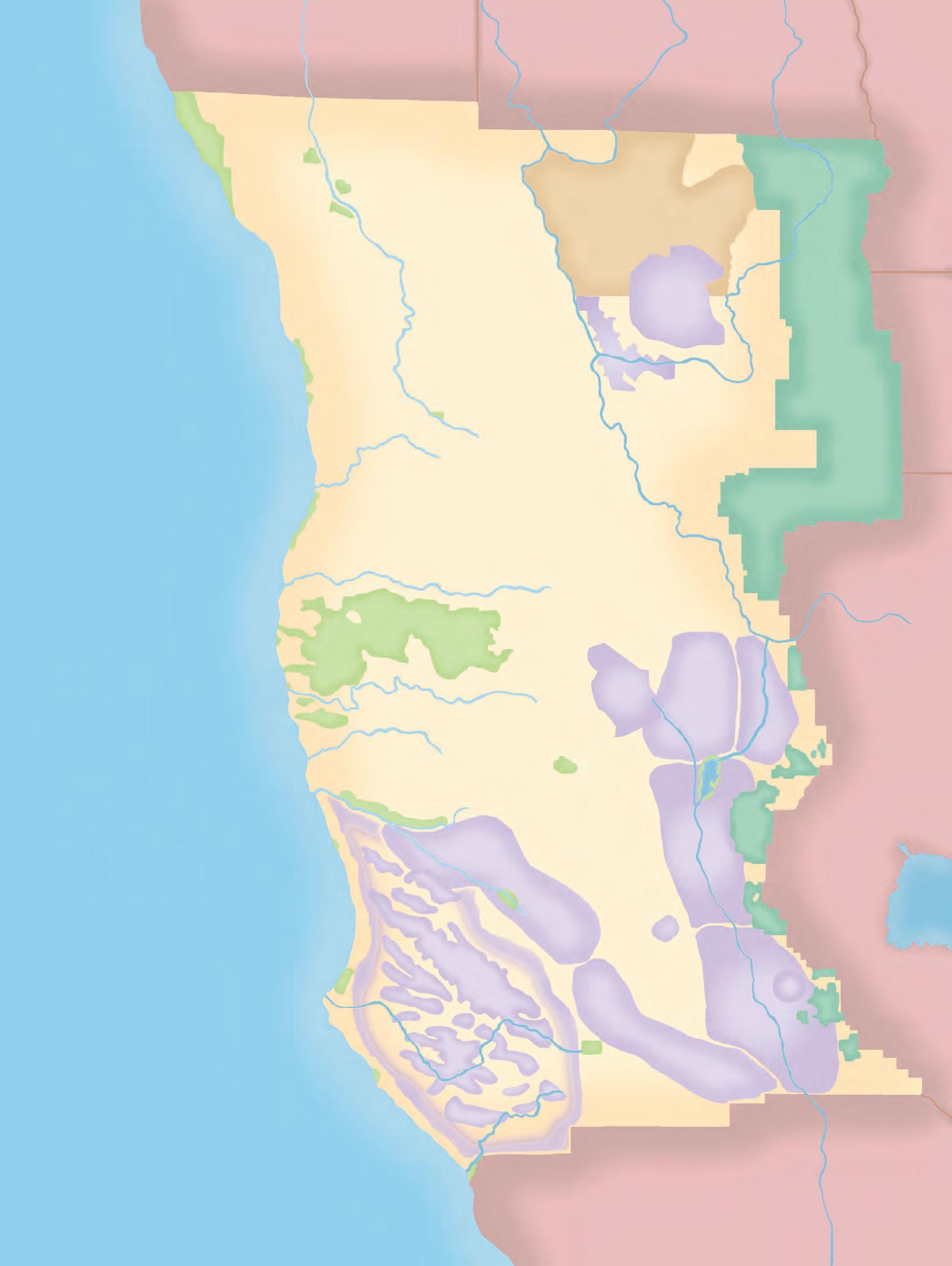


You don’t need a car to transport yourself plus a backpack or bicycle to Mendocino Co unty’s most exhilarating places. Here are six day or weekend trips for hikers and bikers who want to maximize the scenic factor while minimizing their carbon footprints. MTA’s van-style buses have bike racks for two to three bicycles and room for several more inside. There is no extra charge (but do bring your own bungee cords). You’ll be surprised by how much local lore and history you can learn from your driver, so don’t hesitate to tell them where you’re headed.
North Coast Ride: MTA offers frequent trips to Fort Bragg from as far south as Santa Rosa (two round trips daily through Saturday, one on Sunday). Get off on Elm Street at Denny’s in Fort Bragg and ride north over the Pudding Creek trestle bridge. Follow easy paths for about 10 miles to McKerricher State Park and Ten Mile Beach where you can walk the beach for miles. It’s a gorgeous out-and-back trip with ocean views the whole way.
South Coast Ocean Hikes: Take the #95 MTA bus from Santa Rosa north to Gualala and camp in old growth redwoods at Gualala Point Regional Park or stay at one of several hotels in town. Trails from the campground lead to a broad beach and miles of trails south along ocean bluffs and hidden beaches in Sea Ranch. Next day, hop aboard the early #75 headed north to Point Arena, and tell your driver you want to get off at the Rollerville Cafe. Enjoy breakfast (they can pack you a lunch too), then find the trail across the street on the south side of Lighthouse Way that leads onto Stornetta National Monument public lands and miles of trails that follow coastal bluffs between the Point Arena Lighthouse and town. You can see whales offshore year round. Catch the 5 pm bus back to Gualala. bit.ly/no-cargetaway
Hendy Woods: Hike the Redwoods. Take the MTA #75 bus from either Gualala or Ukiah to the hamlet of Philo in Anderson Valley, and ask your driver to unload you and your backpack at Hendy Woods State Park. Hendy Woods is home to enomous oldgrowth redwood trees and miles of pristine hiking trails that wander among them. You can camp overnight or — if you’re coming from the coast and returning there later in the afternoon — indulge in a day of hiking before catching the bus back. RedwoodHikes.com/Hendy/Hendy.html
Willits Backroads Adventure: This 24-mile ride is best suited for cross or mountain bikes because of several miles of gravel and a few springtime stream crossings. Experience gorgeous woods, vineyards and backcountry farmland with a thrilling downhill finale. bit.ly/WillitsBusBikeTrip
Ukiah’s Old River Road: This is one of the most scenic 30-mile out-and-back bike trips anywhere, with options for more miles and big hills. Take the MTA #65 or local #9 to the Pear Tree Shopping Center on East Perkins Street in Ukiah to begin. Ride east on East Perkins Street across the Hwy 101 overpass and turn right onto Oak Manor Road. Continue south onto Babcock Road and turn left onto Talmage. In a quarter mile, turn right onto Ruddick Cunningham Road and follow it through vineyards until it merges with Old River Road. Ride the mostly flat road all the way to Hopland where you can have a great lunch at the Golden Pig or ride back to Ukiah and choose a restaurant downtown. For longer, more challenging rides, either turn left at the roundabout just before Hopland and ride Route 175 toward Lakeport and some steep hills, or continue riding west past Hopland up the steep hills of Mountain House Road.
MORE INFO: Check out the MTA Bus schedule to plan your adventure: bit.ly/MTAhome













If you’re headed from Hopland to Ukiah and you’re not in a hurry, and if you’d like to take in some Northern California countryside not often seen by visitors, here’s a 55-mile tour with stretches that range from the serene to the pulse-pounding. It’s perfect for experienced motorcyclists looking for a challenging ride, and it’s a treat for adventuresome motorists. There are twisting, turning mountain roads with spectacular scenery, gentle country roads and even a few miles of straight and rarely congested roadway.
From its T-junction at Hwy 101 in Hopland take Hwy 175 East, even though Ukiah is to the north. This is probably the most interesting leg of the journey, with the road closely hugging mountainsides in places, and sheer drop-offs to one side. Follow Hwy 175 about 18 miles to Hwy 29, just south of Lakeport. By the time you get there you will have crossed into Lake County and gained about 850 feet in elevation. Hwy 175 has some pretty steep grades and turns with limited visibility, so keep an eye out for oncoming drivers taking blind turns too quickly.
Turn north on Hwy 29 and follow it 11 miles to Hwy 20, just before the town of Upper Lake. Then turn west onto Hwy 20 and take it about 19 miles to Hwy 101. You’ll pass Lower Blue Lake and Blue Lakes, re-enter Mendocino County, and drive past Lake Mendocino. Once you’re on Hwy 101 it’s only 7 miles south to Ukiah.
A heads up: although you won’t have trouble finding fuel in Hopland, Lakeport, Upper Lake or Ukiah, there’s really nothing in the way of gas stations in between.
Farmers’ markets are some of Men docino’s best kept secrets. They are where the locals go to socialize and connect. The markets are mostly made up of mom and pop-scale farms, ranches, creameries and more, most of which you won’t find represented in larger metropolitan markets. Meet the people who run the farm and do the work, and sample and stock up on great organic produce, humanely-raised meat, tasty honey, artisan cheeses, flowers and nursery stock, baked goods, prepared foods and more.

MORE INFO: MCFarm.org for a listing of vendors, special events and other information. Check there also for current times and dates, which change periodically. The following Certified Farmers’ Markets (CFM) are part of the Mendocino County Farmers’ Market Association:
• Fort Bragg , Year-Round, Wednesdays: 3-5 pm , May to Oct., Franklin & Laurel Street; Nov. to April: 3-6 pm: Old Recreation Center Gym, Franklin & Laurel Street (Indoors)
• L aytonville, Year-Round, Mondays, May to Oct.: 2:30-5:30 pm , Albert’s on Hwy 101; Nov. to May: Mondays, 2:30-4:30 pm , Nov. to May, Harwood Hall
• M endocino, Fridays, Noon-2 pm , May to Oct., at Howard & Main Streets
• Redwood Valley, Sundays, 9am -Noon, May 1 to Oct. 16 at Lion’s Club Park, and Oct. 23 to Dec. 18 at Redwood Valley Grange Hall
• U kiah, Year-Round, Saturdays: 9am -Noon at Alex Thomas Plaza, School & Clay Sts
• Willits, Thursdays 3-6 pm , May to Oct., New Location: West Mendocino Ave. between Muir and Main Streets
Albion River Campground
33800 Albion River South Side Rd., Albion 937-0606, AlbionRiverCampground.com
Anchor Bay Campground
35400 Hwy 1, Gualala, 884-4222, ABCamp.com
Black Butte River Ranch
34985 Etsel Ridge Rd, Covelo, CA 95428 983-9438, BlackButteRiverRanch.com
Caspar Beach RV Park and Campground 14441 Pt. Cabrillo Dr., Mendocino 964-3306, CasparBeachRVPark.com
Cleone Campground
24400 N. Hwy 1, Fort Bragg 964 -4589, CleoneCampground.com
Creekside Cabins & RV Resort
29801 N. Hwy 101, Willits, 459-2521
Dolphin Isle RV Park & Marina 32399 Basin St., Fort Bragg 964-4113, DolphinIsle.com
Fort Bragg Leisure Time RV Park 30801 Hwy 20, Fort Bragg 380-0344, FortBraggLTRVPark.com
Golden Rule RV Park 16100 N. Hwy 101, Willits 459-2958, GoldenRuleRVPark.com
Green Acres Campground 23600 N. Hwy 1, Fort Bragg, 964-1435
Gualala River Redwood Park 46001 Gualala Rd., Gualala 884-3533, GualalaPark.com
Harbor RV Park
1021 S. Main St., Fort Bragg, 961-1512
Hidden Pines RV Park & Campground
18701 N. Hwy 1, Fort Bragg, 961-5451
HiddenPinesCampground.blogspot.com
Think you can handle non-stop fun? Then try your luck at one of the many casinos in Mendocino County. These gaming establishments are known for their huge assortments of slot machines, exciting high and low stakes table games, and that perennial favorite, Bingo. You can also enjoy live music performed by the topnotch entertainers who frequent Mendocino County’s casinos. Additionally, there are restaurants in the casinos that serve some of the best food around, and in the most pleasant settings. When you can manage to pull yourself away from all the fun, be sure to stay a night to rest up for a whole new day of excitement.
• G arcia River Casino in Point Arena, 707-467-5300, TheGarciaRiverCasino.com
• H idden Oaks Casino in Covelo, 707-983-6896, HiddenOaksCasino.com
• S herwood Valley Casino in Willits, 707-459-7978, SVRCasino.com
Jug Handle Creek Farm & Nature Center 15501 N. Hwy 1, Caspar 964-4630, JugHandleCreekFarm.com
Mendocino Grove Campground 9601 Hwy 1, Mendocino 880-7710, MendocinoGrove.com
Manchester KOA Kampground
44300 Kinney Rd., Manchester 882-2375, ManchesterBeachKOA.com
Mendocino Redwoods RV Resort 1600 Hwy 20, Willits 459-6179, MendocinoRedwoods.com
Pomo RV Park & Campground 17999 Tregoning Ln., Fort Bragg 964-3373, PomoRV.com
Redwood Empire Fairgrounds, RV Park 1055 N. State St., Ukiah 462-3884, RedwoodEmpireFair.com
Redwoods River Resort & Campground 75000 Hwy 101, Leggett 925-6249, RedwoodRiverResort.com
Schooner’s Landing RV Park & Marina 33621 Albion River N. Side Rd., Albion 937-5707
Sportsmans RV Park 32094 N. Harbor Dr., Fort Bragg 357-2208, SportsmansRVPark.com
Westport Beach RV Park & Campground 37700 N. Hwy 1, Westport 964-2964, WestportBeachRVPark.com
Wildwood Campground & RV Park 29700 Hwy 20, Fort Bragg 964-8297, Wildwoodside.com
Woodside RV Park & Campgrounds 17900 N. Hwy 1, Fort Bragg 964-3684, WoodsideRVPark.net
For more than a few people, a California vacation would not be complete without a relaxing visit to a spa. From facials and massages to a hot cup of tea, Mendocino County’s many spas provide relief from stress.
• Coast Inn and Spa in Fort Bragg — Experience the serenity of the coast while practitioners release the stress and tension from your body. Offering various types of massage, far-infrared sauna and natural healing services. 707-964-2852, CoastInnAndSpa.com
• At The Heritage House Resort and Spa, rejuvenate your body and indulge your senses with massage treatments and body rituals amid soothing views of the sand, sea and sky. Spa services are also available inside your room or on your outdoor deck. Certified specialists. 707-202-9000, HeritageHouseResort.com

• H ave a “massage in the forest” at Stanford Inn just south of Mendocino Village. Choose from Thai, hot stone, neuromuscular or Botanical Aromatherapy massages. Also available: facials, Ayurvedic treatment and yoga. 800-331-8884, StanfordInn.com
• T hird Court Salon and Day Spa in Little River Inn — This family-owned destination resort is located on the coast, two miles south of Mendocino Village. They offer professional hair care, facials, massage, body treatment and more. 707937-5942, LittleRiverInn.com
• Vichy Springs Resort and Country Inn in Ukiah — Relax in a naturally carbonated hot spring or be treated to a number of unique massages and full body treatments. 707-462-9515, VichySprings.com
The discus throw was introduced at the Ancient Olympic Games in 708 B.C., and the modern game of golf dates back to the 15th century in Scotland. It was not until 1926, however, that we have any record of the two games being merged. That year schoolchildren in Canada developed “tin lid golf,” a game similar to golf played by throwing tin lids. Elsewhere and independently, other people tried playing golf with disc-like objects, including pie tins, from the 1930s through the 1960s, but it wasn’t until the late ’60s that the rules for modern disc golf were laid down and the game started to catch on in a big way.
As in traditional golf, a course usually consists of 18 holes. Unlike regular golf, most disc golf courses are located in public parks and are free to play, although some courses charge a nominal fee. The sport requires inexpensive discs instead of costly clubs and balls. The disc golf “hole” is a metal basket mounted on a pole. It’s become wildly popular, and seems to be America’s new favorite park game. It’s so easy to play that just about anyone of any age can enjoy it, yet at the same time it is very challenging to master. Courses can be found all over Mendocino County:
• Anderson Valley Brewing Company, Hwy 253 at Hwy 128 in Boonville, 707-895-2337
• College of the Redwoods, Mendocino Coast, 1211 Del Mar Dr., Fort Bragg, 707-962-2663
• Mendocino High School, 10070 Ford St., Mendocino, 707-964-1601
• Mendocino Redwoods RV Resort, 1600 Hwy 20, Willits, 707-459-6179
• Low Gap Park , 841 Low Gap Rd., Ukiah
• Mendocino College Disc Golf Course, 1000 Hensley Creek Rd., Ukiah, 707-468-3000
• Lake Mendocino, Overlook Day Use Area, 707-462-7581
• Manchester Beach KOA , 707-882-2375

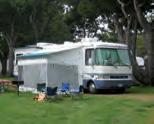



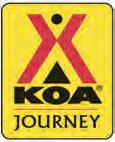
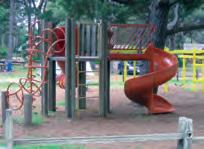
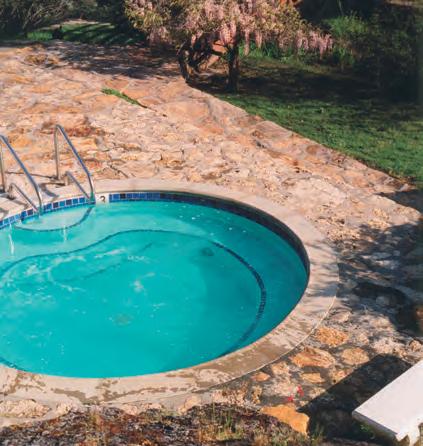









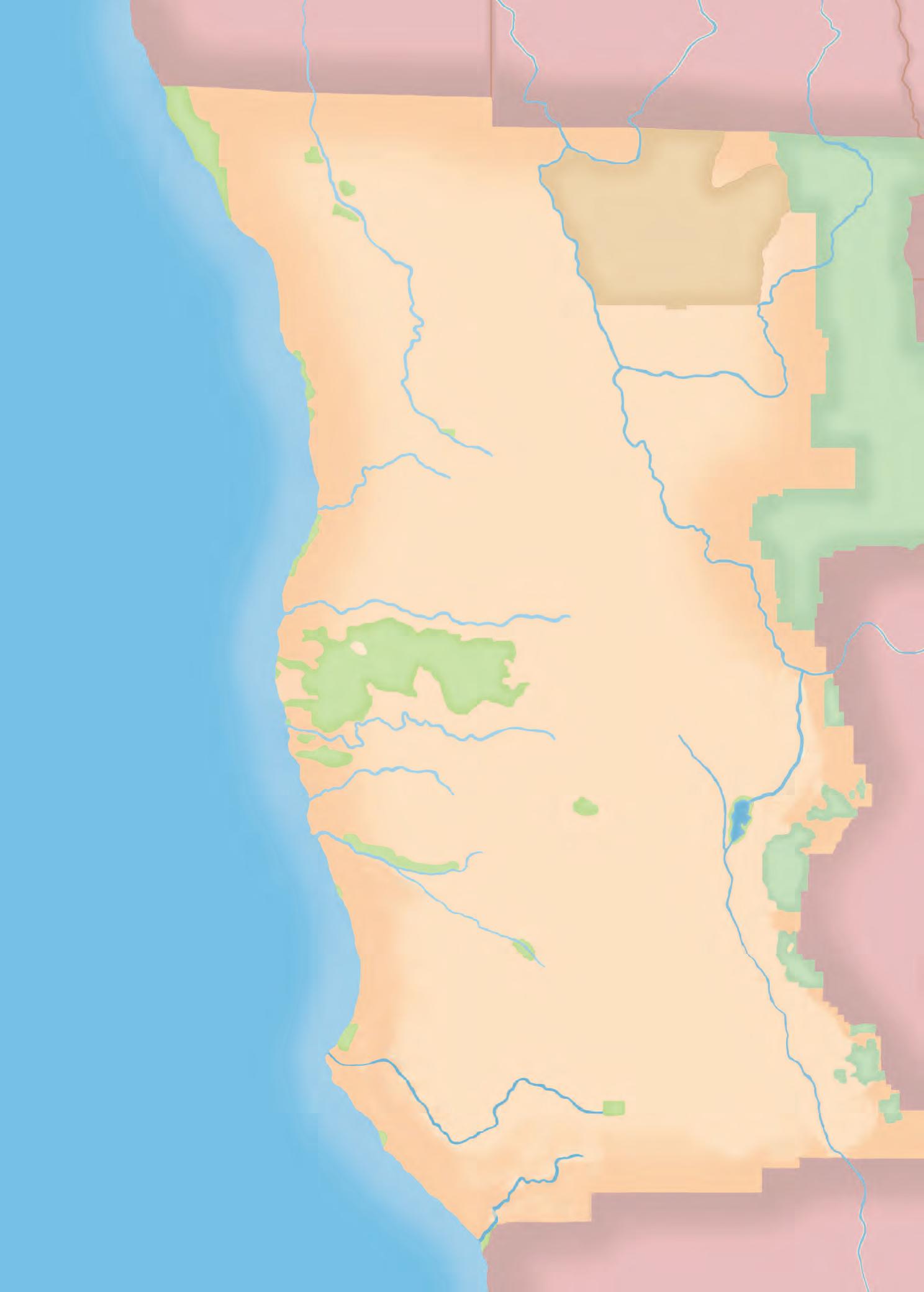




















Cannabis has a long and storied legacy in Mendocino County, one of the three northern California counties that comprise the now world-famous Emerald Triangle, along with Humboldt and Trinity counties. A term that was originally tied to law enforcement actions against small independent farmers living off the land and cultivating cannabis in opposition to State and Federal law, the ‘Emerald Triangle’ signifies the area in the world where there has been the most advancement over the past 50+ years in the craft of small batch cannabis production. The legacy of those early cannabis farmers lives on today in our heritage producing region.
Mendocino was one of the first counties to develop commercial cannabis permitting programs during the days of Prop 215, the Compassionate Care Act which provided an affirmative defense for those cultivating and providing medical cannabis to patients. This period was one where even in the context of stigma and onerous regulations and continued threats from law enforcement at the State, Federal and local levels, small farmers in Mendocino took the breeding and cultivating of their cannabis to new heights.
Today, the implementation of Prop 64, the latest statewide cannabis regulatory package, has made it harder than ever for small farmers to survive in the regulated market. Unreasonable State and local regulations, outrageous compliance fees and Federal tax laws have created the most challenging environment the legacy community of small cannabis farmers in Mendocino has ever faced, and yet our cultivators regularly produce some of the best and most awarded cannabis in California. From securing 11 CA State Fair Awards including several ‘Best in State’ Golden Bears to regular appearances at the top of the awards listings of world famous cannabis events like The Emerald Cup, Mendocino County cannabis is second to none.
Whether traveling in Mendocino, or anywhere in California, if you want the best small batch cannabis from legacy farmers - be sure to ask for Mendocino Cannabis!
Michael Katz, Executive Director, Mendocino Cannabis Alliance MendoCannabis.com • MendocinoCannabis.shop
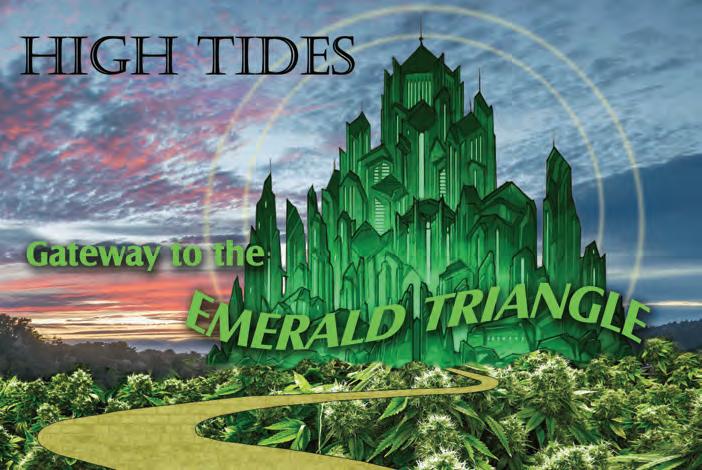
•Bring a legal, photo ID & CASH
•Expect security and a check-in process (usually a quick check of your ID)
•A medical marijuana card is not necessary at Recreational Dispensaries, but some dispensaries offer medical patients a discount.
•Ask the Budtenders questions. They’re there to help you figure out what to try or what to buy, and they’re happy to help guide new customers find a product to enjoy.
•Products may not be consumed on-site. Some dispensaries have a consumption lounge, but most DO NOT and it is strictly against the rules and the law.
•THE LEGAL LIMIT: Individuals may possess up to 28 grams of flower or 8 grams of concentrate.
•Any cannabis products must be transported in a sealed container. Any open containers must be placed in a location inaccessible to the driver.
•Use of cannabis products while driving is strictly ILLEGAL and will result in fines.
•Transportation of cannabis products across state lines is strongly discouraged as the legality is unclear and laws vary from state to state.
• FLOWER: Trimmed marijuana buds that are ready to be smoked or vaporized using your favorite method or device.
• EDIBLE: Drinks, gummies, cookies, chocolate bars and many, many other options are available to consume cannabis by eating or drinking.
•TOPICAL: A lotion, balm, tincture, salve, adhesive patch or other method of applying a cannabis infusion to the skin. Most of these products are not psychoactive and are designed for pain relief and/or inflammation.
• CONCENTRATE: As the name implies, these are strong preparations of cannabis, comprised of the trichomes, terpenes and cannabinoids without any leafy plant material.
Consumer safety is important! All of the products in a legal dispensary are labeled, with complete product information available to measure potency and purity. A licensed dispensary will be able to tell you about any products that interest you. Always remember that cannabis is a natural product with variations in strength, flavor, and effects: please enjoy responsibly.



Ukiah Field Office
2550 N. State St., Ukiah, CA 95482
468-4000 • BLM.gov/office/ukiah-field-office
Access roads into the following areas are narrow and winding. Travel trailers and large RVs not recommended. Before you go, obtain a free map at the BLM office in Ukiah. Campsites first-come, firstserved; no potable water at most campsites.
North Cow Mountain Recreation Area — 17 mi. of foot trails, off-highway vehicles (OHVs) prohibited.
Mayacmas Campground – 9 units, tables, BBQs, pit toilets.
Goat Rock – 2 units, tables, fire grates/BBQ, water for animals.
South Cow Mountain OHV Recreation Area 125 mi. of OHV trails and roads. Area subject to closure during periods of wet weather. For current conditions call 24-hours a day, 468-4000.
Red Mountain Campground – 10 units, toilets, BBQs, tables. Staging area for S. Cow Mtn. OHVs. Buckhorn – 4 units, tables, fire grates/BBQs, toilets. Sheldon Creek – 6 units, toilets, tables, fire grates/ BBQs.
Point Arena-Stornetta Unit of the California Coastal National Monument — next to Point Arena Lighthouse. Day use only, hiking, picnicking.
MENDOCINO NATIONAL FOREST
Covelo Ranger Station
78150 Covelo Rd., Covelo CA 95428, 983-6118
Campsites are first-come, first-served. Get directions and map from Ranger Station. Call for current camping fees and dates campgrounds are open.
Developed Camps
Eel River – 15 campsites, tables, stoves, toilets, fire rings, potable water, river access, no hookups. Hammerhorn Lake – 9 campsites, tables, fire rings, stoves, water, toilets, boat ramp, no hookups, no trash.
Little Doe – 13 campsites, tables, fire rings, stoves, toilets. No water, no hookups, no trash.
Dispersed Camps – “Dispersed” campsites are not as developed as regular campgrounds; unimproved roads, no parking areas or water
Kyen & Bushay Campgrounds – Take Hwy 20 E. from Hwy 101, 5 mi. N. of Ukiah. Marina Dr. exit will take you to boat ramp, marina and Kyen Campground. For Bushay Campground, go past Marina Dr., turn left after bridge, continue along river and up hill. Open AprSept., Bushay subject to closure when lake is high.
Chekaka Campground – 2 mi. N. of Ukiah off Hwy 101, take Lake Mendocino exit and follow signs. Boat ramp, camping, dam overlook and day use area. Open May-Sept.

Admiral William Standley SRA – 14 mi. W. of Laytonville on Branscomb Rd., 247-3318. 45 acres of redwoods, hiking, picnicking. Near headwaters of South Fork of the Eel River.
Big River State Beach – Just S. of Mendocino, Beach, estuary, watershed and hiking trails, 962-0470 or 9375804.
Caspar Headlands State Beach – 2 mi. N. of Russian Gulch on Point Cabrillo Dr., 937-5804. Beach access, boating, surfing, wind-surfing, snorkeling, scuba diving, whale-watching, fishing.

Atchison – 3 campsites, a pit toilet, fire rings. Howard Lake – 5 tent sites, 5 RV sites, fire rings, fishing, vault toilet, no other facilities. Road unimproved, 4 WD recommended.
Surveyors – 3 campsites, tables, primitive, no fee.
U.S. Army Corps of Engineers
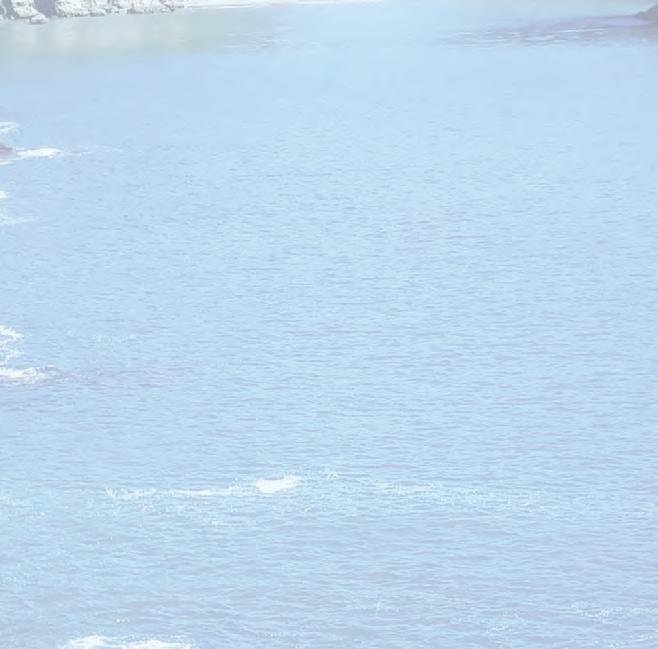
Greenwood State Beach – 15 mi. N. of Point Arena on Hwy 1, 937-5804. Beach access, visitor center. Park open March-Nov., Wednesday-Sunday, 10 AM -4 PM
Hendy Woods – 1⁄2 mi. S. of Hwy 128 on PhiloGreenwood Rd., 895-3537, 895-3141 (seasonal). Virgin redwood groves, Navarro River, hiking, picnicking, camping, swimming, canoeing and kayaking.
Jug Handle SNR –1 mi. N. of Caspar on Hwy 1, 937-5804. Beach access, 2.5-mi. nature trail, pygmy forest.
MacKerricher SP – 3 mi. N. of Fort Bragg on Hwy 1, 964-9112. Beach access, hiking, biking, horseback riding, fishing, wildlife and whale-watching, wheelchairaccessible nature trail, tide pools, Ten Mile Dunes area.
Mailliard Redwoods SNR – East of Yorkville/Hwy 128 on Fish Rock Rd. Picnic area, along Garcia River in redwood forest.
Manchester State Beach – At Manchester on Hwy 1, 882-2463. Day use only, beach access, wildlife watching, hiking, boating, fishing, wind surfing. San Andreas Fault runs into the sea here.
Mendocino Headlands State Park– Surrounds town of Mendocino off Hwy 1, 937-5804. Day use area, whale watching, trails, beach access. Ford House Museum has interpretive displays, seasonal exhibits, guided walks, visitor information; call for hours.
Montgomery Woods State Natural Reserve – 15 mi. E. of Comptche off Orr Springs Rd., 937-5804. Redwood groves, trails, picnic area and day use.
Reynolds Wayside “Campground” – 4 mi. N. of Leggett on Hwy 101, 445-6547. Day use only, river access in old-growth redwood and Douglas fir forest. Russian Gulch State Park – 2 mi. N. of Mendocino on Hwy 1, 937-5804. Reservations, call 800-444-7275 or ReserveCalifornia.com. Camping, beach access, swimming, tidepooling, skin diving, rock fishing, hiking trails, paved bike trail, “Devil’s Punch Bowl” sea cave. Schooner Gulch State Beach – 3 mi. S. of Point Area on Hwy 1, 937-5804. Beach and headlands, fishing, picnicking, surfing, boating.
Sinkyone Wilderness State Park – 36 mi. SW. of Garberville (Humboldt Co.) on Briceland Rd. (last 9 mi. unpaved, may be impassable in wet weather). Rugged, remote wilderness known as “Lost Coast,” first-come first-served camping & backpacking. 247-3318
Smithe Redwoods SNR – 4 mi. N. of Leggett on Hwy 101, 247-3318. Picnic area, hiking, 60-ft. waterfall, fishing and swimming in South Fork of the Eel River.
Standish-Hickey SRA – 1.5 mi. N. of Leggett on Hwy 101, 925-6482. Redwood groves, picnicking, hiking, fishing, swimming on South Fork of the Eel River, year-round camping.
Van Damme State Park – 3 mi. S. of Mendocino on Hwy 1, 937-5804. Fern Canyon scenic trail, Pygmy Forest, “Cabbage Patch” bog, camping, beach access, paved bike path, kayak tours.

Westport-Union Landing State Beach – 19 mi. N. of Fort Bragg (2 mi. N. of Westport) on Hwy 1, 937-5804. First-come, first-served camping, hiking, beach access and smelt fishing.
GUALALA
Bower Park (Mendocino Co.) 463-4441, 884-1136, 38040 Old Stage Rd. Picnic area, BBQ, horseshoe pits, baseball field, basketball courts, tennis courts, playground, outdoor stage, community room.
Gualala Point Regional Park (Sonoma Co.) 785-2377, 1 mi. S. of Gualala on Hwy 1, Beach access, visitors center, picnic tables, BBQs, campground, showers, dump station, but no RV hookups.
PH ILO / BOONVILLE 463-4441
Indian Creek County Park – Hwy 128, 1 mi. E. of Philo, 5 mi. W. of Boonville, on Indian Creek. Firstcome, first-served seasonal camping.
UKIAH VICINITY 463-4441
Low Gap Park – Near Ukiah High School, on Low Gap Rd. Trails, amphitheater, disc golf, tennis courts.

McKee County Park – Located by Russian River along the road connecting Potter Valley with Hwy 20, hiking, wading and fishing at your own risk. Informational Numbers - Area Code is 707 unless otherwise noted Road Conditions – 800-427-7623
1160 Lake Mendocino Dr., Ukiah, CA 95482 462-7581, Facilities on Lake Mendocino include visitor center with weekend campfire programs, group and individual campsites, day use areas, boat ramps, fishing, wild life viewing and equestrian access. Fees vary. Golden Age and Golden Access discounts accepted. Annual passes.
Navarro River Redwoods State Park – Hwy 128, 6 mi. E. of Hwy 1 Junction, 937-5804. Redwoods, picnicking, swimming, fishing, canoeing and kayaking. Inland portion of park is day use only. Beach camping is seasonal and first-come, first-served.
Point Cabrillo Light Station – Pt. Cabrillo Dr. N. of Mendocino, 937-6123, www.pointcabrillo.org. Lighthouse, gift shop and museum, aquarium, guided walks Sundays, 11AM from May-Sept.
Mill Creek County Park – E. of Ukiah, take Talmage Rd. E. to Eastside Rd., turn right and go to Mill Creek Rd. Picnicking, BBQ pits, trails, playground.
Russian Gulch State Park, David Otott Photography, DavidOtott.com

Gualala sits at the dramatic convergence of rolling coastal hills, the Pacifi c Ocean and the Gualala River. The southern coastal gateway to Mendocino County, Gualala is a delightful resort area and a favorite whale-watching spot. Its name comes from the Pomo Indian name for the river, “ah kha wa la lee,” which means “where the water fl ows down.” People from out of town usually call it GWA-la-la, but locals pronounce it wa-LA-la. Once a logging town, Gualala’s primary economic activity is now tourism. It also serves as a commercial center for the surrounding area. Gualala is an ideal spot for viewing the elusive “green fl ash” that can sometimes be seen for a second or two as the sun sinks into the ocean.
Mendocino’s “banana belt” stretches south from Anchor Bay through Gualala and down to Sea Ranch, just across the county line in Sonoma County. Visitors to this area often enjoy warm and sunny weather while the rest of the coast is shrouded in chilly fog. The warmer weather and more frequent sunshine can be attributed to Point Arena: the protrusion of land into the ocean there, less than 20 miles north of Gualala, provides both fog-break and protective shelter for the coastline to the south.













The Gualala Arts Center is the “heart of the arts” for the Sonoma-Mendocino coast. With several galleries showcasing both local and visiting artists, the exhibits feature a wide and ever-changing range of artistic media from oils and watercolors to sculptures and textiles. There is always a full schedule of events going on at the Center, including monthly art exhibit openings, live theater, lectures, concerts, an annual auto show and youth programs. It also o ers excellent workshops and classes, with instructors brought in from around the world. The Center hosts a number of festivals each year, including the Sonoma-Mendocino Coast Whale & Jazz Festival in April and May, the Fine Arts Fair in May, the Summer Chamber Music Weekend in July, the Art in the Redwoods Festival in August and the Festival of Trees in November. For a current list of events check their website. The Center is also available for weddings, memorials or business conferences. When visiting call ahead or go online to see what exhibits and classes are available, and be sure to tour the grounds when you visit. Admission is free.
WHERE: 46501 Old State Hwy, Gualala
MORE INFO: 707-884-1138, GualalaArts.org


Open daily from dawn till dusk, Gualala Point Regional Park is popular with day hikers and picnickers, as well as overnight campers. This lovely park encompasses almost 200 acres of peaceful meadows, dramatic coastal forests and delightful sandy beaches. The Gualala River runs lazily through it, and o ers limited seasonal fi shing (check the local regulations). The park has an intimate, well-maintained campground situated among the majestic redwood trees and adjacent to the river.
Gualala Point Regional Park o ers 2.9 miles of coastal trail along blu s, through meadows, and above the Gualala River. Gualala Point Beach is easily reached via a dirt trail or ADA accessible paved path, and in general the trails throughout the park are fairly fl at. Dogs are permitted on leashes no longer than 6 feet in length, and must be licensed. There are picnic areas scattered throughout the park, some with barbecues, and restrooms with fl ush toilets. The park has an informative Visitors Center featuring exhibits that showcase the history of Northern California, turn-of-the-century logging, and Native American displays. There are also intricately hand-carved poles from Russia.
GualalaArts.org
WHERE: 1 mile south of Gualala on Hwy 1.
MORE INFO: 707-785-2377, camping reservations 707-565-2267, Monday through Friday 10 AM to 3 PM , Sonoma-County.org/parks/pk_glala.htm



The
Breakers graciously greets
and ever-changing
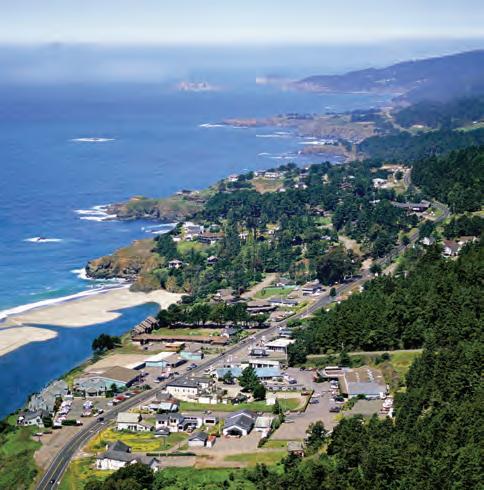
Sandy beaches are rare on the southern Mendocino Coast, which gives Cooks Beach special appeal. A blu trail leads out to the Bonham Overlook, and the other o ers a brief walk through bishop pine forest to access the beach. The short trail makes this an ideal spot to carry in a picnic lunch and enjoy the wind-protected, large pocket beach. Leashed dogs are welcome here, and it is a great family beach. It makes a fantastic spot to watch the sun go down, and perhaps get a chance to see the elusive green fl ash at sunset. There are tidepools near the southern end of the beach that are accessible during low tides, and it is possible to view sea lions, seals, dolphins, and migrating whales (in season). Summer waves tend to be calm.
The trail is managed by the Redwood Coast Land Conservancy (RCLC). Caution should be taken in the water due to the presence of rip currents. Parking is limited. There is no cell reception at this location.
WHERE: About 2 miles north of Gualala on Hwy 1. Take County Road 526 and look for the sign saying Bonham Trail to Cooks Beach.
MORE INFO: rclc.org.

with
views, the waves lull you to sleep, and the sauna and luxurious soaking tub allow you to nourish and pamper yourself. With little light pollution, the evenings and stargazing are remarkable. Each room is enhanced with large private decks, whirlpool spas, fireplaces, and radiant floor heat. Come to the sea.















Open Mon-Sat 11-6 & Sun 12-6

38520 Hwy 1 in Gualala 707.884.1882



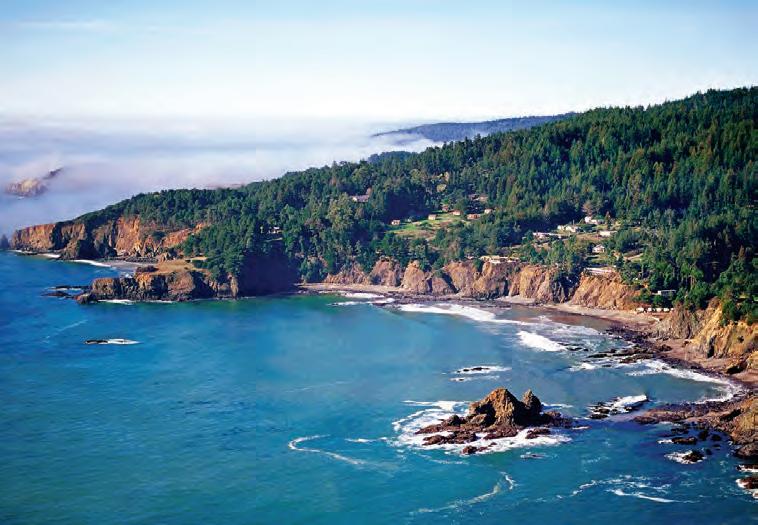
As you travel north from Gualala, you’ll find the beautiful and secluded village of Anchor Bay. It has a rich and colorful history. Prior to the mid-19th century, the Pomo Indians were the only inhabitants of the area. Settlers began trickling in after 1844, when the Mexican government made a large land grant to a man named Rafael Garcia. Garcia brought in cattle, and the area became used for ranching. Loggers came to the area in 1870, and a wharf was constructed and used for lumber products, fishing and occasionally rum-running during the Prohibition days.
Today, visitors enjoy Anchor Bay for its privacy and pristine beaches. Services available in Anchor Bay include a small shopping village, restaurants, lodging and a campground nestled amid redwoods and ferns. Anchor Bay offers relaxation, natural beauty and a peaceful, tranquil environment for spending vacation time along Mendocino’s South Coast.
When Sunset magazine ran a feature called “Top 10 Beaches of the West” a few years ago, Anchor Bay came in at number 3, just behind ‘Aliomanu Beach in Kauai, Hawaii, and well ahead of beaches in Carmel, Santa Barbara and San Diego. Located in the heart of the Mendocino “banana belt,” the coastal village of Anchor Bay is warmer, with less fog and wind, than its surrounding areas. The seclusion of the bay, which is edged by the white sands of Fish Rock Beach and framed by majestic weathered bluffs, makes it popular with visitors and locals. Protected from the wind, the bay is a delightful place to fish, scuba dive, ocean kayak, surf, and boogie and skim board. It is also a great place for sea lion- and whalewatching, as well as beachcombing and tide-pooling.


In the town of Anchor Bay, visitors will find an old-fashioned village market that specializes in natural foods, a complete wine and beer emporium, restaurants, and other businesses. Accommodations in Anchor Bay include individual vacation rental cottages and homes, pristine housekeeping cabins, bed and breakfast inns and a campground. WHERE: Between Gualala and Point Arena.
MORE INFO: Redwood Coast Chamber of Commerce, 707-884-1080 or 800-778-5252


This trail was completed in 2017 by the Mendocino Land Trust. It showcases all aspects of a coastal area, especially the beautiful white cliffs. Home to endangered Point Arena Mountain Beaver, this preserve offers more than 2 miles of public trails. Covering 73 acres, the Preserve hosts a creek recovering from cattle grazing, Bishop pine forests, wetlands, and meadowlands. A scenic sampling of coastal overlooks that (seasonally) provide a great vantage point for whale watching. Steep cliffs provide stunning views, and also require hikers to stick to the trail for safety. Leashed dogs are welcome on the trail. Parking (somewhat limited) is available at the south end of the trail.
WHERE: Located about 1 mile south of Point Arena, look for a Coastal Lookout sign. Highway 1 mile markers: 14.3 at the north end, and 13.5 at the south end.
MORE INFO: mendocinolandtrust.org/trails/southern-coastal-trails/pelican-bluffs-trail/



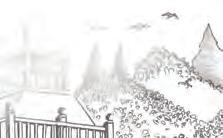
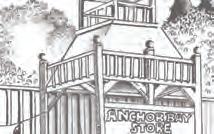














Local lore has it that Schooner Gulch got its name back in the era of sailing ships when a mysterious schooner ran aground there at dusk one evening, only to have vanished without a trace by the following morning. Today, Schooner Gulch State Beach offers its visitors not only great fun and exciting activities, but also some of the most magnificent views anywhere. Spend the day here hiking, picnicking, fishing, sunbathing, surfing or windsurfing.
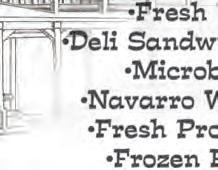





Just north of Schooner Gulch you’ll find Bowling Ball Beach, named after the numerous prehistoric spherical boulders that cover the beach and are visible only at low tide. Such formations grow in underwater environments when materials collect around a nucleus, and are shaped by water action as it moves them around.
WHERE: About 3 miles south of Point Arena, mile marker 11.41 (Schooner Gulch) offers the closest parking area. Look for a sign that says, “Park Facing South Only.” There are two trailheads, about 100 feet apart. The southern trailhead takes you through a dense forest for a short quarter-mile hike to Schooner Gulch Beach. The northern trail goes to Bowling Ball Beach, and gets somewhat steep. You’ll want to go at low tide, so be sure to check a tide table before setting out.
MORE INFO: 707-937-5804, www.parks.ca.gov/?page_id=446
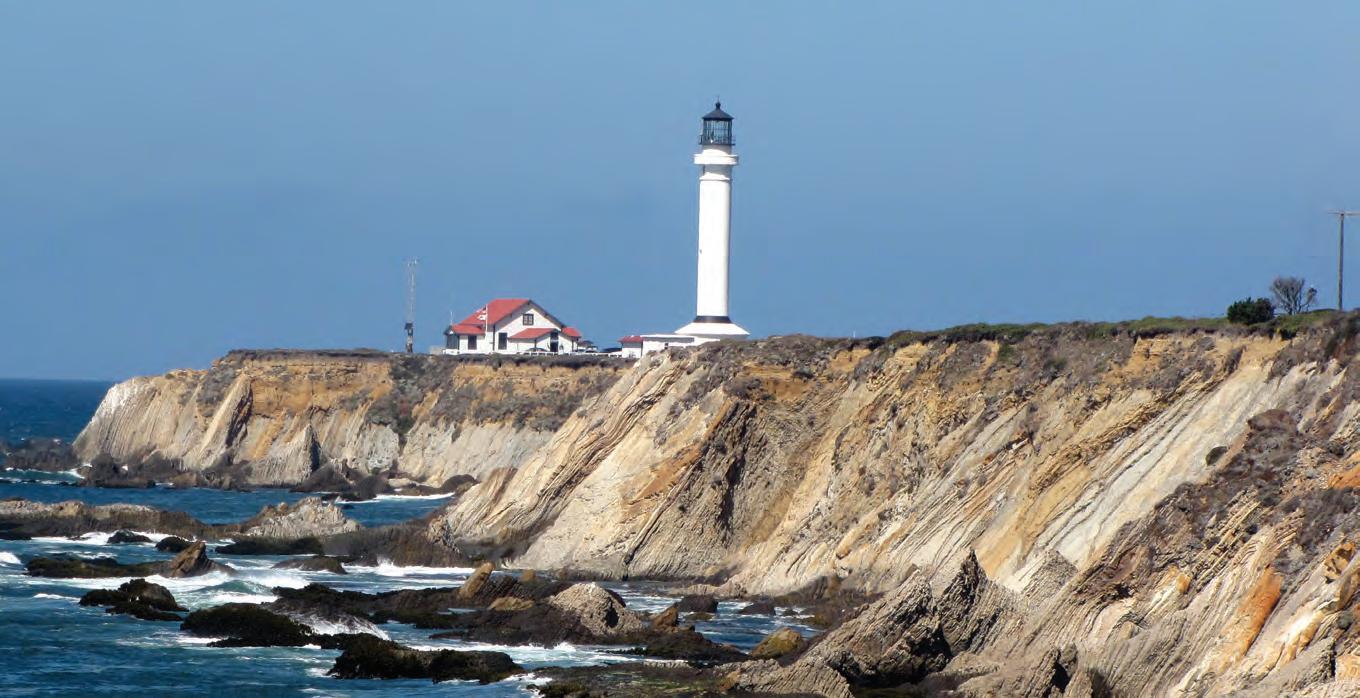
Located on the coast of southern Mendocino County about 130 miles north of San Francisco, Point Arena is one of the smallest incorporated cities in the state of California, with a population under 500, and also one of the most beautiful.
Surrounded by the Point Arena-Stornetta Public Lands, a unit of the California National Coastal Monument; the Point Arena Lighthouse, the tallest on the West Coast of the United States; and the Point Arena Public Fishing Pier in Point Arena Cove, the city and its surrounding area offer incredible natural beauty and a wide range of recreational activities. These latter include fishing, surfing, tidepooling, whale-watching, sightseeing, fine dining and lodging, enjoying music and film, and taking jaunts to well-preserved historical structures. The Point itself is a land mass jutting out into the ocean, and the spot closest to Hawaii in the contiguous 48 states.
For food, fun and live entertainment on the Mendocino Coast, the Garcia River Casino is a short scenic drive on Windy Hollow Road in Point Arena.
MORE INFO: PointArena.net
• O ngoing: Point Arena Lighthouse Full Moon Nighttime Tours
• Feb-October: Blues on the Coast at Arena Theater
• A pril: Wind and whale Celebration
• A pril-May: Whale and Jazz Festival; Almost Fringe Festival
• M ay: Waves and Whales 5K Run
• J uly: Independence Weekend Celebration
• A ugust: September Studio Discovery Tour
• S eptember: Harbor and Seafood Festival
• October: Halloween on Main Street
• November: Point Arena Mushroom Festival
• December: Point Arena Hometown Holidays


Relax
MORE INFO: thegarciarivercasino.com, 707-467-5300




Point Arena Cove is a popular destination for fishermen, surfers, whale-watchers, beachcombers and sightseers. Including the 330-foot Point Arena Pier, it offers something for just about everyone. The cove itself has a rocky bottom that varies from about 20 to 100 feet in depth. Point Arena Creek runs into it a little south of the pier. Offshore lies the Mendocino Trench, with some of the deepest waters in the world. The cove is partially protected from wind and storms by Point Arena to the northwest. The pier has extraordinary fishing, considered by some the best pier fishing in California. Striped sea perch, kelp greenling, rock greenling, cabezon, lingcod and salmon are just some of the species frequently caught there. The pier includes cleaning tables, restrooms and a boat launch.
Whales pass close by Point Arena, and sometimes are seen playing right in the cove. Bring your binoculars for a closer look at them and at many different species of birds, including the famed Laysan albatross, better known as the goonie bird, which has been clocked flying at speeds of up to 80 miles per hour.
The beaches of the cove offer excellent areas for beachcombing, shell collecting and tide-pooling. Surfing and diving are also very popular. The area is home to occasionally spectacular waves, but out-of-area surfers beware: conditions there are often treacherous, and you need to know where the hidden rocks and rusty ship’s boiler are located before setting out.

45500 Lighthouse Rd, Point Arena, CA 95468 877.725.4448 x1 PointArenaLighthouse.com
ELodging and dining can be found in Arena Cove and Point Arena. No license is necessary when fishing off the pier; however, dogs are not permitted.
WHERE: In the heart of Point Arena. From the south, turn left from Hwy 1 onto Iverson Avenue. This will turn into Port Road. Follow the road to the pier. From the north, turn right onto Port Road and follow it to the pier, mile marker MEN 14.85.
MORE INFO: Mendocino.com/?id=3423, PierFishing.com /point-arena-pier
Set in some of the most spectacular yet peaceful surroundings on the northern California coast, and right next to the Point Arena-Stornetta Unit of the California Coastal National Monument, stands the Point Arena Lighthouse. It is the tallest lighthouse on the West Coast (115 ft.), and you can climb to the lantern room at its very top. The panoramic view from there is unforgettable.
The Point Arena Lighthouse was initially constructed in 1870, but suffered major damage in the 1906 San Francisco earthquake and had to be rebuilt. The current lighthouse began operation in 1908, nearly 27 months after the quake. The new tower featured a first-order Fresnel lens, the largest standard size made. It was 7 feet in diameter and weighed more than 4,700 pounds. The Fresnel lens was decommissioned in 1977 and a new rotating beacon was installed. During the restoration of the Tower and Fog Signal Building Museum between 2008 and 2010, the Fresnel lens, mercury bath and rive system were both moved to the Museum, where the are now on display.
Guided tours of the Indoor Museum and Tower as well as self-guided tours of the grounds are available daily, with nighttime tours when the moon is full. The Lighthouse Station Store features unique souvenirs and charming gifts. For those who want he unique experience of spending the night at a Lighthouse there are seven comfortable cottages and studios in the former Lighthouse Keepers’ houses, vacation rentals that are available year-round.
WHERE: 45500 Lighthouse Rd., Point Arena.
MORE INFO: 877-725-4448 ext. 1 or 707-882-2809 ext. 1, PointArenaLighthouse.com





The Village of Elk, previously known as Greenwood, is a charming stop along the Northern California Coast. In this little town you’ll encounter stunning views of the shoreline and Pacific Ocean in a mesmerizing meeting of land, sea and sky, punctuated by waves breaking against picturesque off-shore rock formations known as sea stacks. On a coast celebrated for its scenic beauty, Elk is truly exceptional.
In the 1800s trappers and hunters found their way to the region in search of game. Britton Greenwood, the son of the noted tracker-explorer Caleb Greenwood, was the first to establish a ranch there, which he named the Elk Ranch. A community grew up around the ranches and dairy farms, and soon small mills were established to process the spectacular old-growth redwood. In 1883 local businessman Lorenzo White purchased most of the land around Elk, establishing a large mill and building a railroad to support it. At one point Elk supported a population of almost 1,000. At the turn of the century Elk was alive with hotels, dance halls, saloons and general stores. Probably because of its vibrancy, Jack London found Elk a perfect place to write. According to local legend, in February of 1902 he wrote his masterpiece, The Call of the Wild, while staying in the old White boarding house, today known as the Hospital House, across from Li Foo Gulch. This claim has been questioned.
Manchester is a beautiful, tiny village with a population of about 200. Situated in an area of rich grazing land about 13 miles south of Elk, flocks of sheep and herds of cattle can be seen, adding a pastoral note to some of the most spectacular coastal scenery in the world. Nearby Manchester Beach State Park offers a beach, sand dunes, flat grasslands and 5 miles of shoreline.
MORE INFO: RedwoodCoastChamber.com
• Take a horseback ride through the forest, or along the beach
• Watch for migrating whales, dolphins and sea lions.
• Enjoy a picnic — fill a basket and head to Greenwood-Philo Road to the wineries first.
• E xplore Elk’s history at the Museum.
• S pot wild elk and deer in and around town.
• G o kayaking, wind surfing and surf fishing.
• Visit the shops and cooperative art galleries for some one-of-a-kind local gifts.
Manchester State Park, with nearly 18,000 feet of ocean shoreline, offers a beach with an abundance of driftwood, sand dunes and rich grasslands. A beautiful sandy beach runs southward for about 5 miles towards Point Arena. Among its many attractions is the excellent steelhead fishing in its two streams, Brush Creek and Alder Creek. Please check with the Department of Fish and Wildlife at 530-225-2300 for seasonal closures and restrictions.
Manchester State Park is home to a wide variety of gorgeous coastal wildflowers and provides habitat for tundra swans and other wildlife. The San Andreas Fault runs into the ocean here. Much of the area is used for grazing sheep and cattle, lending a pastoral note to the local scenery. Temperatures tend to range between the low 50s and low 70s most of the time. It is usually windy and often rainy or foggy; wearing layered clothing is recommended. The park takes its name from the village of Manchester, located on Coast Hwy 1 about 7 miles north of Point Arena.
WHERE: The main park entrance is located at 44500 Kinney Ln. (off Hwy 1), 1⁄2 mile north of the town of Manchester.
MORE INFO: 707-882-2463, www.parks.ca.gov/?page_id=437
In the mid-1850s, about a mile north of Elk, sat Cuffey’s Cove. Resident James Kennedy built and operated a wharf and a purpose-built chute to move railroad ties and shingles down the steep bluffs to be loaded onto schooners moored below. At its height, the town hosted nearly 500 residents and included hotels, bars, and restaurants, supported by abundant local timber and a beloved variety of locally-grown red potatoes. A large steam sawmill was built a few miles away in Greenwood (Elk) in the 1870s; then fires in 1886, 1892, and again in the early 1900s destroyed the business district. By the 1920s, Cuffey’s Cove had largely disappeared. All that remains now are two fenced-in cemeteries, one Catholic and the other Protestant, building foundations, a few remnants of the lumber chute, and some weathered cypresses acting as sentinels. The proper spelling of Cuffey is disputed, as are the origins of the name itself.
WHERE: Along Hwy 1 about a mile north of Elk, near the 35 mile marker post. Parking along Hwy 1 is limited, there is a pull-out just south of the cemetery, beyond the gate accessing the adjacent private property.
MORE INFO: https://www.mendorailhistory.org/1_towns/towns/cuffeys_cove.htm 15

Just south of the small town of Elk you’ll find picturesque Greenwood Creek State Beach. Here you can soak up the sun, go swimming or have a picnic lunch on the coast. It’s also a wonderful place to go for a stroll and watch the sunset any time of year.
Greenwood, the old name for Elk, was a lumber town in the late 1800s and early 1900s. Today the Greenwood State Beach Visitor Center, which used to be the Elk post office, houses a museum that includes artifacts from the lumber camps and period furniture that includes turn-of-the-century household appliances. There are also a magnificent mural of the old Greenwood wharf, and books and postcards for sale that cover a wide range of coastal subjects including Pomo Indian culture and local history. The Visitors Center is open Wednesdays to Sundays from 11am to 4 pm , March through November.
WHERE: Just south of Elk, about 15 miles north of Point Arena.
MORE INFO: 707-937-5804, www.parks.ca.gov/?page_id=447

Little River began life as a mill town. Its first lumber mill was built in 1864, and next to it arose the shipyard of Thomas Peterson, whose vessels won prizes for their design and craftsmanship, including first prize in San Francisco at the Fourth of July Regatta in 1876. On average, three prime trees were used to build each ship. The mill closed in 1893, then burned down in 1910.
Little River Cove offers one of the most popular beaches on the Mendocino Coast. The protected cove is a great place for water recreation.
The cove is also near the entrance to Van Damme State Park, one of the coasts most-loved parks. It offers beautiful hiking trails in the lush Fern Canyon trail system along the fern-carpeted floors of the Little River Canyon. You will feel like a giant in the Pygmy Forest with its mature cypress and pine trees that grow between 6 inches and 8 feet tall, or you might decide to follow your nose to skunk cabbage at the Cabbage Patch bog. Van Damme offers several camping options and year-round guided coastal kayak tours.
In 1853 Captain W.A. Richardson built the first lumber mill in the town of Albion, on the river flats below the high wooden trestle bridge that spans the Albion River. Albion, an ancient name for England, was chosen for the town in memory of Sir Francis Drake landing in Northern California in 1579 and naming it “New Albion.”
Today the town features restaurants, lodging, a fully equipped grocery store and deli, and other amenities for the traveler. The area around Albion is rich with sheltered coves that are excellent for tide-pooling, hiking and exploring. Albion Ridge Road, which travels east of Hwy 1, affords the traveler panoramic views of the area’s rolling hills as they slope down to the ocean. It is an excellent place to watch red-tailed hawks, and in winter, the migratory tundra swans on their way to the Garcia River, south of Albion.
For a memorable coastal golfing experience, try the award-winning regulation nine-hole golf course at Little River Inn. With three placements and dual greens on holes 7 and 9, you can play it like an 18-hole course.
Tucked among the hills and redwoods, it comes complete with such unexpected challenges as stunning ocean views that vie for your attention and deer, frogs, blue herons, raccoons or other wildlife gamboling, hopping, leaping, flying or otherwise traversing the putting greens. It is, in fact, an Audubon-certified sanctuary in addition to being the only golf course on the Mendocino Coast. To complete the picture there is a driving range, putting green and a fully stocked Pro Shop. Little River Inn has stunning rooms and a fabulous restaurant to retreat to after a round or two. Inn guests receive a 10 percent discount on greens fees. Inn guests also have free access to Little River Inn’s two lighted championship tennis courts. The only uniforms required are shoes with non-marking soles; diamond tennis bracelets are optional. Fees for non-guests are very reasonable, and lessons are available from a certified tennis pro.
WHERE: 7901 N. Hwy 1, Little River
MORE INFO: 707-937-5667 (Pro Shop/Golf Course), 707-937-5942, 888-INN-LOVE, LittleRiverInn.com

Northern California is famous throughout the world for towering redwood trees that grow to be hundreds of feet tall. There are other trees in the area, however, that cannot grow to a height of even 8 feet, or a thickness greater than an inch wide. Indeed, there are mature, cone-bearing cypress and pine trees there that stand only 6 inches high! To experience this Lilliputian and Brobdingnagian contrast for yourself, take a trip to Van Damme State Park’s Pygmy Forest, located off Hwy 1, 3 miles south of Mendocino. Extremely acidic soil low in nutrients is believed to cause the stunted growth of these cypress and pine trees, found less than a mile away from huge redwoods. It’s amazing that these trees can manage to remain alive and grow at all under such adverse conditions. When some of these tiny trees have been cut down, more than 80 to 100 growth rings have been carefully counted. If you are in the area and have already been wowed by the remarkable redwood towers that soar into the heavens, you should also check out the Pygmy Forest and be astonished by the very existence of these tiny trees.
WHERE: In Van Damme State Park off Hwy 1, 3 miles south of Mendocino.
MORE INFO: 707-937-5804, Mendocino.com/?id=510, www.parks. ca.gov/?page_id=433

How would you like to be a marine mammal for an hour and a half, and explore the Mendocino coast’s incredibly rich and diverse sea caves? It’s easier than you might think. You’re already a mammal. For the marine part, just hop aboard a sit-on-top ocean kayak, and take one of Kayak Mendocino’s professionally guided sea cave tours in Van Damme State Park.
Here you will join harbor seals, sea otters, giant anemones, kelp and other marine flora and fauna as you glide through the water safely and happily. Van Damme is a special place offering protection and easily navigated channels. You will stay within these areas to ensure an easy ride, while still being able to observe wave action on outer reefs.
No kayaking experience is necessary, and tours are safe and enjoyable for all ages. All instruction and equipment are provided, including wetsuits, booties, life jackets and helmets. Walk-ups are welcome, but reservations are preferred because space is limited. Tours leave Van Damme State Park at 9am , 11:30 am and 2 pm , with reservations daily.
WHERE: Van Damme State Park, 3 miles south of the town of Mendocino.
MORE INFO: 707-813-7117, KayakMendocino.com
One of the most popular recreational destinations in the area, Van Damme State Park straddles Hwy 1 where Little River empties into a protected cove that is perfect for scuba diving and snorkeling. There is an outer reef that keeps out swells most of the time even when other locations are blown out. The surf there is usually calm enough to allow launching boats and sea kayaks from the beach. Hiking, camping and fishing are also very popular at Van Damme.
Daytime parking and picnicking at the beach are free. Most of the park’s 2000+ acres lie east of the highway, up verdant Fern Canyon. The park offers 74 beautiful and shady campsites, available on a first-come, first-served basis. A paved trail follows the Little River 2 1⁄2 miles up the lovely canyon, connecting with a dirt path that climbs to the Pygmy Forest. For the more adventuresome hiker, there is an extensive system of trails that meanders throughout the park over 10 breathtaking miles. Whether your stay is short or extended, chances are good you’ll find an unforgettable adventure at Van Damme State Park.
WHERE: 3 miles south of the town of Mendocino on Hwy 1.
MORE INFO: 707-937-5804, 707-937-0851, 707-937-4016, www.parks.ca.gov/?page_id=433; Campground reservations: ReserveCalifornia.com, 800-444-7275








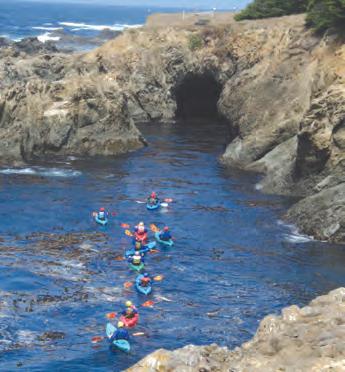








A trip to Northern California would not be complete without a stop in the quaint, charming Village of Mendocino. This historic town, which sits on rugged bluffs overlooking the Pacific Ocean, features dozens of shops, art galleries and bed-and-breakfast inns, and is host to a number of special events every year. These include the Mendocino Whale Festival in March and the Mendocino Music Festival in July.
The beauty of the town is what first impresses visitors. The New England-style architecture is the influence of homesick pioneers who “came ’round the horn” in the mid19th century to be a part of the town’s lumber boom resulting from the Gold Rush. San Francisco was a booming city in need of building materials, and harvesting the coastal redwoods abundant around Mendocino provided a source of prosperity for people in the small town. Then after the Great San Francisco Earthquake of 1906, timber from the Mendocino area was shipped south to help rebuild the city. The area’s history is evident in its buildings, and the town of Mendocino has been designated a National Historic Preservation District.


MORE INFO: Mendocino.com/eventfestival.html
• O ngoing: Second Saturday Art Walk
• January: Mendocino Crab Feasts
• M arch: Mendocino Whale Festivals, MendocinoCoast.com/ whale-home
• M ay-October: Mendocino Farmers’ Markets, MCFarm.org/ mendocino.html
• M ay: Mendocino Film Festival, MendocinoFilmFestival.org;
• J uly: Mendocino Music Festival, MendocinoMusic.org; 4th of July Parade & Events
• November: Mendocino Wine & Mushroom Festival, VisitMendocino.com
Visitors will be delighted in and around this picturesque town. The area offers deep-sea fishing, whale-watching, canoeing, kayaking, hiking, biking and horseback riding. Trails lead from the headlands down to beaches where visitors can search for seashells or explore the numerous tide pools. However, beachcombers and hikers should always keep an eye on the ocean. Large “sneaker waves” are common, and can sweep unsuspecting hikers off the rocks and out to sea.
The Mendocino Hotel on Main Street is an attractive inn that was built in 1878. It still serves the same function today that it did more than 100 years ago, and its rooms are furnished with antiques, fireplaces and historic memorabilia. The Kelley House Museum on Albion Street is another historic building popular with visitors. Built in 1861, the Kelley House has period artifacts and photographs, as well as a lovely pond and gardens.







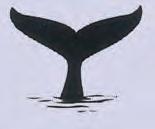





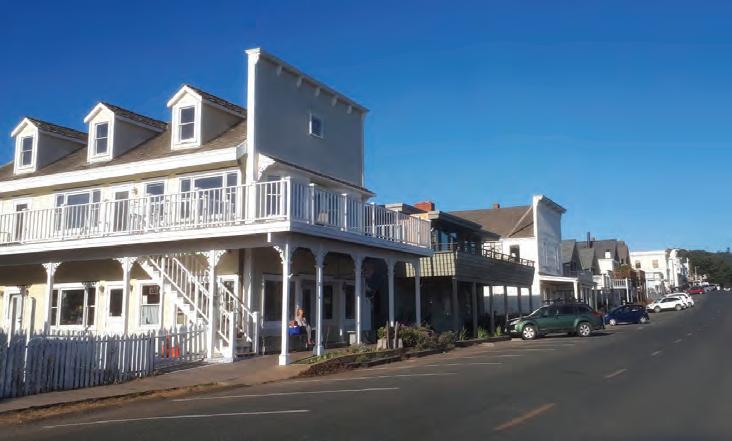
In July of 1850 the Frolic, a two-masted clipper ship bound for San Francisco from China, shipwrecked a little north of present-day Mendocino. A salvage crew was unable to recover the cargo, but did discover vast stands of old-growth redwood trees. A mill was built, and the village of Mendocino grew up around it. Perched on bluffs painted with wildflowers and overlooking the Pacific Ocean, some of the homes and shops from the 1850s still stand today, although most of the structures are Victorians from the second half of the 19th century. There are also examples of New England Salt Box, Gothic Revival, Italianate and vernacular (defined by local style) architecture. Many of these historic buildings are now on the National Register of Historic Places.
Be sure to drop by the Ford House Museum and Visitor Center, open daily from 11am to 4 pm , where you can take a look at a model of what the town looked like almost a century ago. Also visit the Kelley House Museum to learn more about the history of this charming village. Kelley House Museum is open Friday through Monday 11am to 3 pm Visitors can enjoy a Historic House and Building Tour that begins there every Saturday and Sunday at 11am , and lasts 1- 1⁄2 hours.
MORE INFO: Ford House Museum, 45035 Main St., Mendocino, 707-937-5397, MendoParks.org/visitor-centers; Kelley House Museum, 45007 Albion St., Mendocino, 707-937-5791, KelleyHouseMuseum.org
Since 1916 the Mendocino coast has starred in 17 silent movies and over 40 “talkies.” Notable among these are East of Eden, The Russians Are Coming! The Russians are Coming!, The Dunwich Horror, The Uninvited, Summer of ’42, Forever Young and The Majestic, as well as the long-running TV series, Murder She Wrote. So what better place to host a film festival? The event’s relaxed and intimate feel offers visitors a great chance to interact with filmmakers from around the world while enjoying their work. Set in the natural splendor of the Mendocino coast, this gem of a film festival has become a favorite of the cognoscenti.
The 2023 festival is scheduled for June 2-5. Follow the updates on Facebook and the web page for updates, Mendocino film facts, and remote and in-person viewing opportunities.
The Mendocino Film Festival offers a wealth of cinema in a variety of genres. Check their website for more information, including venues, show times and ticket information. MORE INFO: 707-937-0171, MendocinoFilmFestival.org and on Facebook
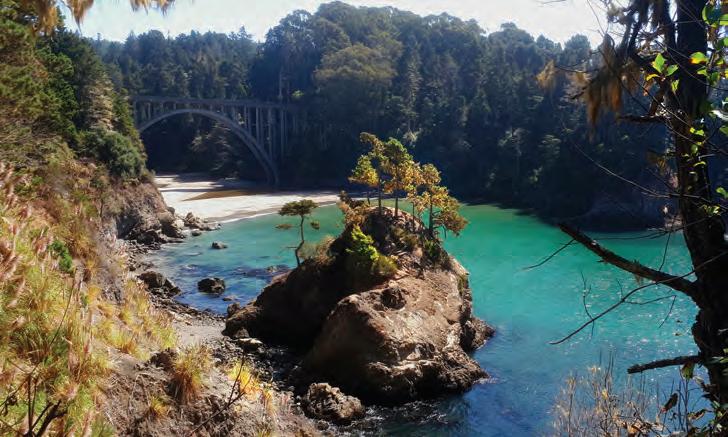
Established in 1986, the Mendocino Music Festival is a magical blend of fine music by outstanding performers in one of the most enchanting sites anywhere. Evenings include orchestra concerts, Big Band, chamber music ensembles, dance, blues, jazz, world, folk, bluegrass and popular contemporary music.
The next edition of the Mendocino Music Festival is slated for July 15-29, 2023. Follow their Facebook page or check their website to see the future plans for bringing live music back “to the edge of the world.”
WHERE: Main Street in the town of Mendocino.
MORE INFO: 707-937-2044, MendocinoMusic.org
This is a gem of a park, offering almost a mile and a half of ocean frontage with great beaches and tide pools, plus more than 10 miles of lush, forested hiking trails and plenty of horseback riding trails. You’ll find a beautiful picnic area perched on a cliff overlooking a dramatic cove, spacious, well-laid out campgrounds with bathrooms and hot showers, a 3-mile long paved bicycle trail, and a 36-foot high waterfall that’s one of the park’s star attractions. Another highlight is the Devil’s Punchbowl, sometimes referred to as “the blowhole,” a partially collapsed sea cave 200 feet from the water’s edge that offers a stunning view of churning, surging waves 60 feet below you. The beach offers swimming, tide pool exploring, kayaking and rock fishing. Russian Gulch Creek Canyon is heavily forested. Altogether, Russian Gulch State Park’s 1,305 acres offer an ever-changing palette of natural beauty.
WHERE: 2 miles north of Mendocino on Hwy 1.
MORE INFO: 707-937-5804, 707-937-0497, www.parks.ca.gov/?page_id=432
The Big River Unit of Mendocino Headlands State Park offers 7,400 wild acres for exploration. Acquired in 2002, it includes 1,500 acres of coastal estuary wetlands. You can swim, bike, canoe, jog, walk your dog (leashed) or hike along the beautiful Big River. The beaches along the river are perfect for swimming and sunbathing. Big River’s lower 6 to 8 miles provide a wonderful boating experience. Private canoes, sailboats, kayaks and rowboats can put in at the primitive boat ramp at the eastern edge of the sandy beach just below the trailhead. Along Big River’s northern bank, Big River Haul Road provides a flat, wide, scenic promenade leading to nearby Jackson Demonstration State Forest and Mendocino Woodlands State Park.

The trailhead is at the end of a dirt road that can be reached by turning east (inland) off Hwy 1 just north of the Big River Bridge. For a more serious walk, start in the village, cross the beach under the bridge and continue along the shore until you come to the gate at the trailhead. People are cautioned to stay on the main road; there are numerous dead-end logging roads and skid trails throughout the Big River Unit that make it easy to get disoriented and lost. You can also hike along the shore to find marsh and tidewater wildlife. The Big River protects, preserves and is home to great blue herons, osprey, wild ducks, river otters and over 27 endangered, threatened or special concern species of wildlife.
WHERE: Just south of the town of Mendocino.
MORE INFO: 707-937-5804, MendocinoFun.com/big-river


The title of “State Reserve” in California is only given to areas of land that have outstanding or unusual natural or scenic value. Caspar Headlands State Reserve certainly fits that description. Located about 4 miles north of Mendocino off Hwy 1, this 3-acre reserve is located just south of the town of Caspar, and sits atop one of California’s most strikingly beautiful coastal bluffs. The reserve is characterized by sculpted rock formations and spectacular cliffs that provide dazzling views. It is also home to a magnificent array of wildflowers.
In order to gain access to the reserve, you will have to obtain a free entry permit from the Mendocino Sector Office, located across from Russian Gulch State Park.
Nestled adjacent to Caspar Headlands State Reserve just north of Mendocino, this dramatic stretch of coast offers a beautiful beach with swimming, boating, fishing and other popular beach activities. From it you can enjoy panoramic views of the Pacific Ocean meeting the headlands’ rugged cliffs and coastal bluffs. If you happen to arrive between November and June, you might get to see some California gray whales as they migrate. The headlands are among the most beautiful and awe-inspiring locations on the West Coast, and are well worth the trip. The weather can change unexpectedly, so it’s a good idea to wear layered clothing. Open from sunrise to sunset.
WHERE: South on Point Cabrillo Drive, past the RV campground, turn right on Caspar Drive to Headlands Drive. Parking is outside the reserve on Caspar Drive.
MORE INFO: 707-937-5804, www.parks.ca.gov/?page_id=444
In 1851 Jerome Ford made his way overland to the Mendocino headlands, looking for salvage from the shipwrecked Frolic, which had met its fate off nearby Pt. Cabrillo the previous spring. He found no remains — local Pomo indigenous people had beaten him to them — but he did discover vast stands of coast redwoods instead, and soon partnered with an eastern entrepreneur to establish both the town of Mendocino and a booming mill yard.
Jerome Ford and his wife Martha built a house on Main Street of the new town in 1854; today it stands as the Ford House Museum. It serves as the visitor center for the Mendocino Headlands State Park, offering both historic and current information about the Mendocino area. Open every day from 11am to 4 pm , the Ford House Museum exhibits models of 19th century oceanic vessels, logging tools, photographs, Native American relics and an elaborate model of the town of Mendocino in 1890. It also offers a wide selection of brochures, books and cards, as well as free seasonal lectures on area wildlife and changing seasonal exhibits in its gallery. History lovers will want to catch Heritage Days in May. Call for reservations for the Ford House Progressive Dinner held the first Friday in May, an annual benefit for the continued restoration of the Mendocino Headlands State Park’s historic visitor center and museum. Each successive course is served at a different historic Victorian treasure in Mendocino — the Kelley House, the Mendocino Hotel and the Ford House.
WHERE: 45035 Main St., Mendocino
MORE INFO: 707-937-5397, MendoParks.org/visitor-centers
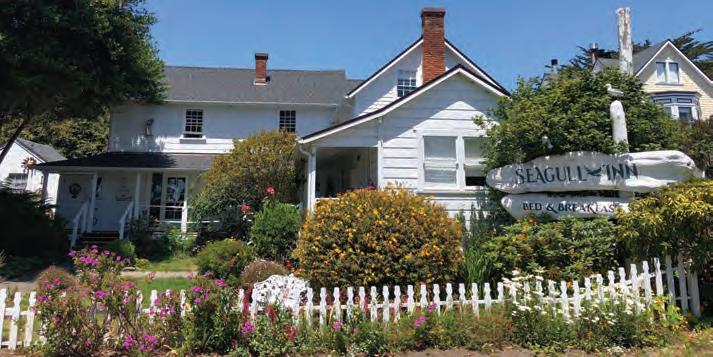





gourmet dinners
luxury guest rooms
weddings and events


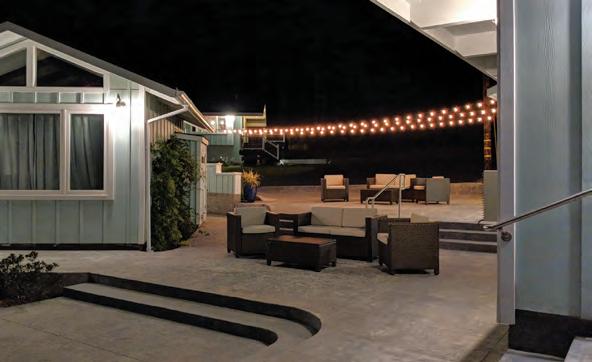
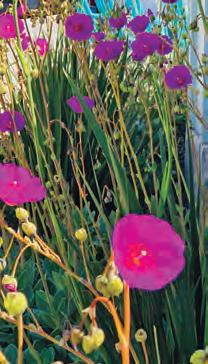




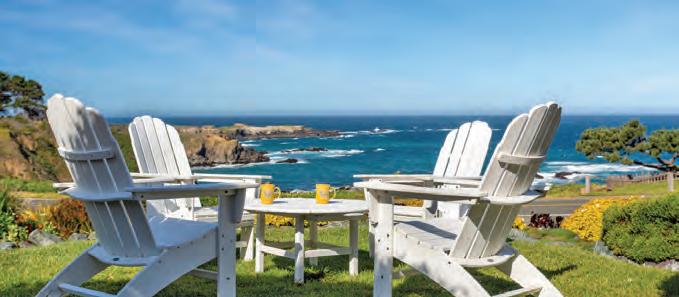


The annual migration of California gray whales takes them from their feeding grounds in the cold waters of the Bering Sea near Alaska to the warm waters off Baja California, Mexico, and back. Their young, called calves, are born in the protected lagoons of western Baja, and do not begin their trek northwards until they are about a month old. Unlike other whale species, California grays stay fairly close to the coast, often within a few hundred yards of shore. This means that twice a year (from November to February going south, and from February to June going north), visitors can observe whales from atop the Mendocino headlands.
To celebrate this happy occurrence, three festivals in honor of the confluence of whales and all things Mendocino have sprung up, typically on successive weekends in March: the Mendocino Whale Festival, the Little River Whale Festival and the Fort Bragg Whale Festival. This year, due to concerns about the spread of COVID-19, the March festivals have been cancelled. The Ft. Bragg festival has been tentatively rescheduled for Fall. Activities include food, beer and wine-tasting, art exhibits, whalerelated educational programs, nature walks, and whale-watching from the headlands, from chartered boats and from kayaks, plus lots more. Don’t miss the fun!
MORE INFO: Mendocino Whale Festivals, 707-961-6300, MendoWhale.com; 707-937-4700, MendoParks.org/whale-festival

With the decline of the lumber industry, Mendocino fell on hard times. Then, in 1957, a local mansion that appeared in the James Dean movie East of Eden burned down, and Bill Zacha acquired the grounds with a small deposit. With the help of friends, other artists and townspeople, by 1959 he and his wife Jennie had established the Art Center there, utilizing the still-standing carriage house and outbuildings.
During the ensuing years, the history of the Art Center and Mendocino village became closely entwined. The Art Center grew and became the focal point of a thriving art colony that revitalized the nearly abandoned town. Mendocino, along with the Art Center, has since become a world-renowned haven for artists.
Today the Art Center’s facilities include studios and classrooms that offer over 200 retreat-style classes each year in a wide range of media, and its galleries present monthly exhibits spotlighting the work of local and national artists. The Center hosts popular annual events on its beautiful campus as well as artists’ receptions the second Saturday of each month, and concerts periodically. Its Members’ Gallery offers exquisite locally produced artwork for purchase.
WHERE: 45200 Little Lake St., Mendocino
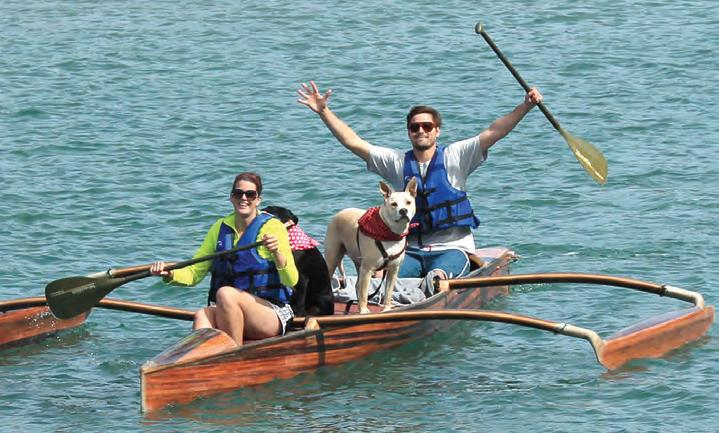
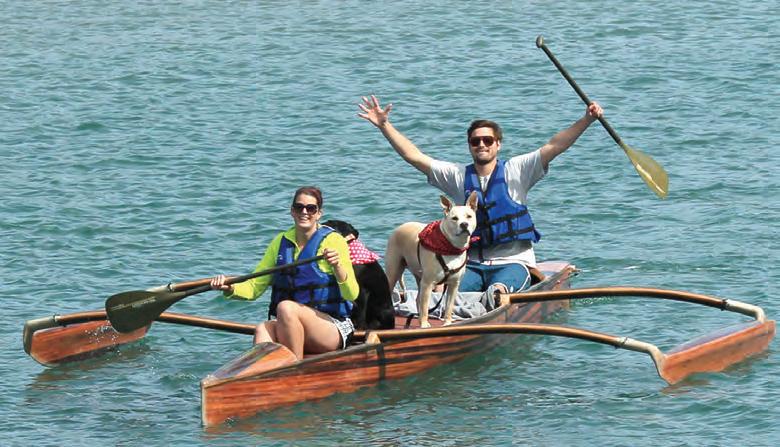
Established in 1972, Catch a Canoe & Bicycles, Too! is the Mendocino Coast’s only full-service outdoor shop, providing year-round rentals, sales and service of a wide selection of redwood outriggers, kayaks, canoes, SUP’s and bicycles. The Big River Cruise is a professionally guided tour and departs daily during the summer aboard the Mendoléa Voyaging Canoe. This unique group voyaging canoe is equipped with downwind sails and a solar electric drive for an effortless cruise up beautiful Big River Estuary—be alert for harbor seals, river otters, birds and more.
Redwood Outriggers are their specialty and are made locally from reclaimed old growth. Several configurations are available for one to seven persons, and the Canine Series is made specifically for dogs and their humans. All outriggers are designed in house at Catch a Canoe and are ultra-stable, narrow and efficient, with foot rudder control for easy steering.
For those who prefer bicycles, the 8-mile-long Big River Trail is a close and easy ride. Catch a Canoe designs and distributes the definitive mountain bike trail map for this area, which can be used to explore the myriad of awesome trails in and around Mendocino.
Catch A Canoe & Bicycles Too! is open year-round, daily from 9am to 5 pm WHERE: 1 S. Big River Rd., Mendocino, on the grounds of The Stanford Inn by the Sea. MORE INFO: 707-937-0273, CatchACanoe.com, canoe@mcn.org
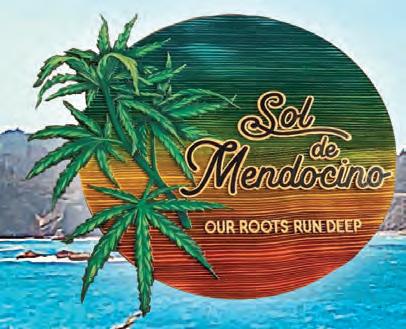

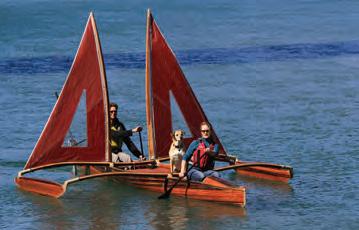


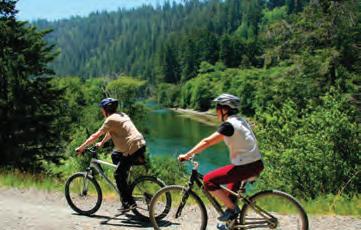





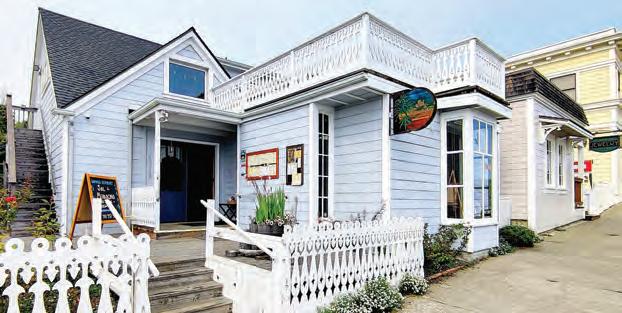







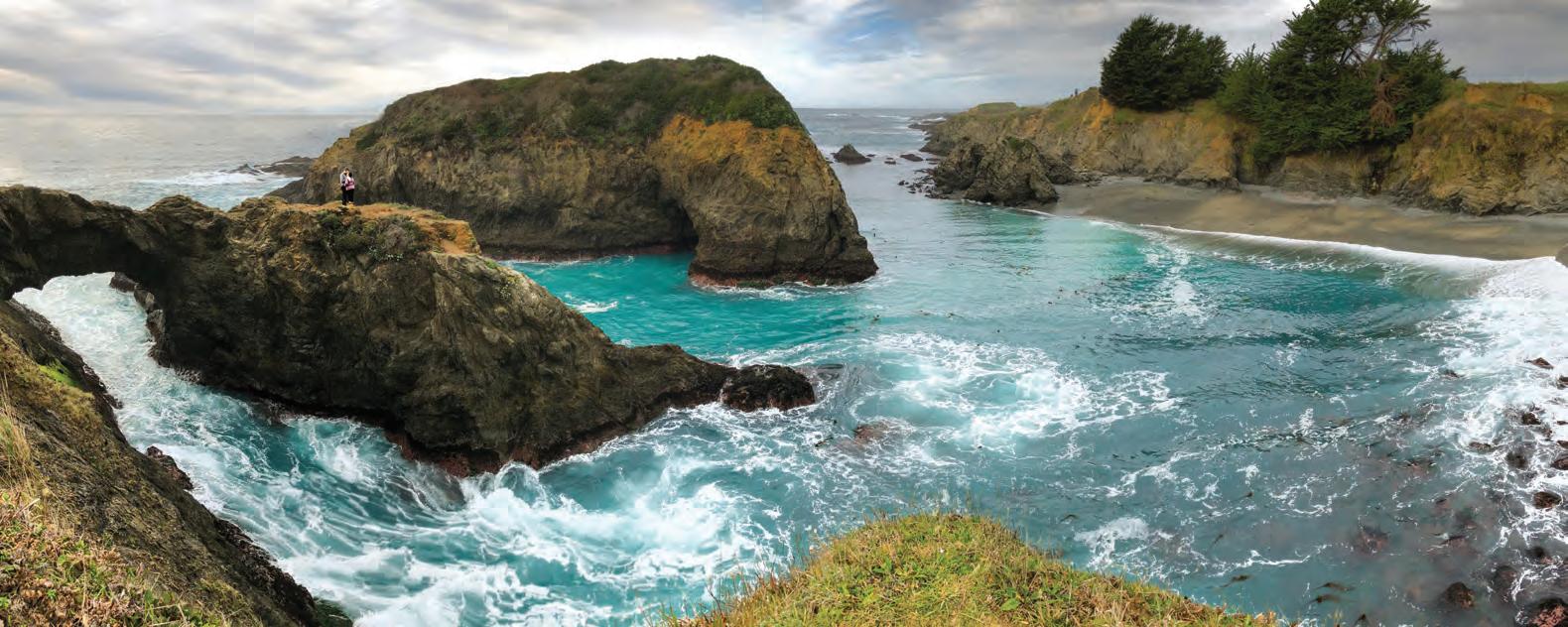
It is likely that you will never experience anything else quite like the Jug Handle State Natural Reserve’s Ecological Staircase. The “staircase” is a land formation that stretches for 2.5 miles over five wave-cut terraces formed by glacier, sea and tectonic activity. Starting in the inter-tidal zone, it ascends through a series of areas that include prairie, pine forest and even a unique pygmy forest with knee-high trees. The nonprofit Jug Handle Creek Farm and Nature Center acts as a private gateway to the area, and offers environmental education programs that are packed with fun and entertaining activities. The Farm also offers hostel-style accommodations in an 1870s-era Victorian farmhouse as well as cabins and camping. An educational brochure is available to explain the changing environments as you travel the 5-mile trail up the slope.
WHERE: In Caspar, located halfway between Fort Bragg and Mendocino on Hwy 1.
MORE INFO: 707-937-5804, www.parks. ca.gov/?page_id=441
Jug Handle Creek Farm and Nature Center, 707-964-4630, JugHandleCreekFarm.org

Construction of the Point Cabrillo Light Station began in 1908, and its lens, a British-build 3rd order Fresnel lens, was illuminated for the first time in June of 1909. The station operated under the U.S. Lighthouse Service and then the Coast Guard before being acquired by the California State Coastal Conservancy in 1991.
Today the light station and its grounds, along with 270 acres of undeveloped coastal bluffs and prairie, are part of the California State Parks system. The light station has been completely restored, and the Fresnel lens, which was decommissioned in 1973, has been refurbished and remounted. Two of the beautiful lightkeeper’s houses and their auxiliary buildings are now vacation rentals for people visiting the Mendocino coastline. They are cozy and intimate, with ocean and headlands vistas all around. The third house is a museum, set up as the lightkeepers would have had it in the early 1900s.
The Point Cabrillo wildlife area has some of the most beautiful scenery on the West Coast. Deer roam the headlands, harbor seals play in the coves, black oystercatchers grace the rocky shorelines, while songbirds, squirrels, weasels and rabbits frolic along our bluffs. During the whale migration season you may even see some of the estimated 18,000 gray whales that migrate from Mexico to Alaska every spring.
Inside the lighthouse and fog signal building is a gift shop and museum. In 2023, the light station was damaged in an extreme winter storm. At press time, the repairs are beginning. Please check their website to check Park and Gift Shop hours. The gift shop is staffed by volunteer docents. The park is open from Sunrise to Sunset. Donations to help the recovery effort can be made on their website.
WHERE: Midway between Mendocino and Fort Bragg, off Hwy 1 on Point Cabrillo Drive, follow signs.
MORE INFO: 707-937-6123, PointCabrillo.org
When visiting the town of Mendocino, take some time to see Mendocino Headlands State Park. The park surrounds the town on three sides with delightful expanses of land perched atop stunning bluffs. From there you can enjoy whale-watching in the winter, wildflowers in the spring, nesting seabirds in the summer and vivid color throughout autumn. Three miles of trails wind along the cliffs, surprising the casual explorer with spectacular views of sea arches and hidden grottos. The park has a beach that is accessible from Hwy 1 or by trails down the bluffs, and offers excellent fishing and scuba diving opportunities.
The park has been in operation since 1974. The town’s south headlands, facing Main Street, remained in timber company ownership until 1972. The threat of development there spurred resident artist Emmy Lou Packard to start a movement in 1969 that led to the inclusion of the south headlands in the State Park. An outgrowth of this effort was the listing of Mendocino on the National Register of Historic Places in 1971, an essential step toward protecting Mendocino’s 19th-century flavor. Now the parkland provides Mendocino with a buffer zone that helps preserve the town’s historical presence, while providing a scenic backdrop of breathtaking beauty. Admission is free. Day use only.
WHERE: Surrounds the town of Mendocino on three sides.
MORE INFO: 707-937-5804, www.parks. ca.gov/?page_id=442


Originally established as a military garrison overseeing the Mendocino Indian Reservation in 1857, by 1869 small lumber mills and ranches had become the area’s dominant features. The San Francisco earthquake of 1906, which leveled much of Fort Bragg, also brought prosperity to the town in its wake, as its mills provided much of the lumber used to rebuild San Francisco. Today, Fort Bragg is the largest city on the Mendocino Coast. Much of Fort Bragg’s history can be viewed at the Guest House Museum, located on the corner of Main (Hwy 1) and Laurel Streets. Built for the Fort
• E xcellent restaurants, lodging, retail stores, antique shops
• B eaches are nearby for beachcombing, picnicking and surf fishing
• E xplore Noyo Harbor and Noyo Headlands Park
• K ayak, paddleboard, charter a boat for whale-watching or fishing, or both
• Diving, snorkeling, spearfishing
• H orseback Riding — Ricochet Ridge Ranch, Horse-Vacation.com
• M acKerricher State Park — numerous campsites and day use areas including a raised wooden walkway that leads to a seal observation point overlooking a secluded cove. The walkway is wheelchair accessible. The park also features a small lake and miles of unspoiled coastline. Great tide pools.
• T he Skunk Train — takes passengers on a scenic tour of the redwood forests east of Fort Bragg along the Noyo River, Railbike Excursions are also offered
• M endocino Coast Botanical Gardens — 2 miles south of the center of Fort Bragg, contains 47 acres of flowers, trees and shrubs with winding trails throughout.
• C .V. Starr Community Center — swimming pool, Skate Park and more, 300 S. Lincoln St.
Noyo Harbor, on the south end of town, is a working port with a commercial fishing fleet, charter boats, fish markets and processing plants, as well as several seafood restaurants. The harbor is also a haven for local seals and sea lions.
MORE INFO: FortBragg.com, Mendocino.com/eventfestival.html
• Symphony Orchestra concerts, Symphony of the Redwoods, 707-964-0898, SymphonyOfTheRedwoods.org
• January: Crab Feast Mendocino, various locations, VisitMendocino.com
• M ay: Annual Rhododendron Show, Mendocino Coast Botanical Gardens, GardenByTheSea.org
• J une: Fort Bragg Quilt Show,OceanWaveQuilters.com
• J uly: World’s Largest Salmon BBQ, SalmonRestoration.org; 4th of July Fireworks
• A ugust: Art in the Gardens, Mendocino Coast Botanical Gardens, GardenByTheSea.org; Fort Bragg Shoreline Riders Rodeo, ShorelineRiders.com
• S eptember: Paul Bunyan Days, PaulBunyanDays.com; Winesong Wine and Food Tasting and Charity Auction, Winesong.org
• N ovember to December: Festival of Lights, Mendocino Coast Botanical Gardens, GardenByTheSea.org
• December: Holiday Lights Parade, NorCoastRodders.com/events.html
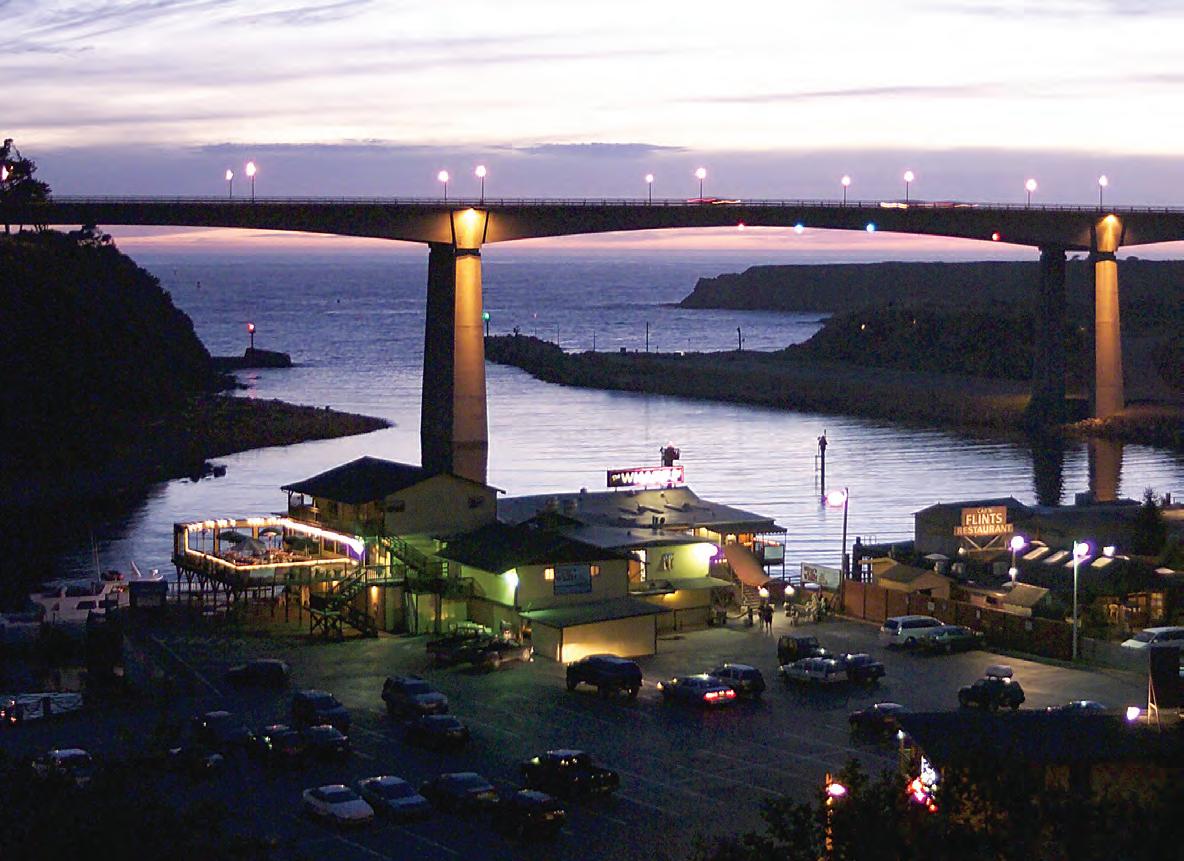

















The harbor offers excellent sportfishing opportunities; a local guide can draw from firsthand experience on these waters, supply the proper gear, and show you how to catch that monster fish. Charters are available from the harbor and can accommodate almost any ocean fishing need. The harbor and surrounding coastal areas are teeming with fish including rockfish, lingcod, halibut and tuna, and are some of the best places onthe West Coast to catch Chinook salmon. If it’s the land you love, yet you would still like to enjoy the ocean, take a walk down the Noyo Jetty. No fishing license is required to fish from it.






Touch, taste and smell the harbor at water level from a kayak. Visitors can bring their wn kayaks, rent them in the area, or employ local outfitters for guided tours. Kayaking in the harbor is a great experience for the beginner, the expert, or anyone at any skill level in between. When the tide is right the beginner can paddle down the Noyo River to enter the ocean, taking in the views. For the more experienced, or if kayaking with a guide, the harbor has spectacular sea caves to explore, abalone diving and even fishing from the kayak. Whether sightseeing, sport kayaking or fishing, kayaking in Noyo Harbor is a healthy, delightful way to spend a day, and a fun way to connect with family and friends.

Enjoy the ocean view, taste the catch of the day and sip a local Mendocino wine. The harbor has a variety of dining options to choose from, the food is fresh and the atmosphere and views are free. Several lodging options are available on the harbor; choose from ocean view rental homes, enjoy the personal touch at a nearby bed andbreakfast, or camp at the mouth of the Noyo River at Sportsmans RV Park. Whatever your plan or price range, you can wake to an ocean view or watch the sun set over the Pacific Ocean.

One of the West Coast’s most scenic harbors, Noyo Harbor is the perfect place to start a day of adventure on land or on the high seas. Highway 1 passes over the harbor along the Noyo Bridge; the harbor itself is located at the mouth of the Noyo River at the southern end of Fort Bragg. Here the towering redwoods sprawl to the edge of the continent, stopping just short of spilling into the vast Pacific Ocean.
Gorgeous views and warm hospitality make Noyo Harbor a great place to meet the ocean from the land. The harbor is home to abundant wildlife, extraordinary fishing and whale-watching opportunities, and world-class lodging and dining. It is a must-experience destination for outdoor recreation.
Communing with nature is a way of life in Noyo Harbor. Harbor seals, sea lions and even river otters bask in the sun, play, and poke their smooth-looking heads out of the water all around the bay. Waterfowl, including osprey, cormorants, pelicans and gulls, patrol the waters looking for their next dining opportunity. Nature lovers have plenty to marvel at, with the wide variety of wildlife that calls the harbor home.
Annually, over 20,000 California Gray Whales travel south along the coast from Alaska to winter in their breeding grounds in Baja, Mexico. In the spring they return north to begin the cycle again. Often you can see these graceful giants from the shore, but chartering a boat from the harbor is an excellent way to meet them on their own terms, in their world — so don’t forget your camera. A local professional guide can educate guests about the habits and history of these awe-inspiring creatures, and increase the number of whales they are likely to see, even on a short visit. During the whale migrations many charter fishing outfits offer fishing trips combined with whale-watching tours. In March, you can celebrate during the annual Fort Bragg Whale Festival, an experience the whole family can enjoy. Take part in guided whale-watching walking tours, sample clam chowders with the kids, and take a free trolley from the festival grounds to the Point Cabrillo Lighthouse. Adults can sample good beer and great BBQ at the microbrew and barbecue tasting.
WHERE: at the South end of Fort Bragg, under the bridge.
MORE INFO: mendocinocoast.com
Located on Northern California’s Mendocino Coast in MacKerricher State Park, and part of the vast California Coast Trail system, the Ten Mile Coastal Trail starts at the Pudding Creek Trestle. The Beachcomber Motel front desk staff provides visiting walkers with the Ten Mile Coastal Trail log book to sign their names and join the ranks of the hundreds of people who have walked this trail. The trail runs along the bed of an old logging haul road and railroad, north from the Fort Bragg city limits for 7 miles to the Ten Mile River. A multi-use trail for hikers, bicyclists and horse back riders, the asphalt paved trail traverses coastal bluffs to Ward Avenue, connecting to Hwy 1. An additional 3 miles north of Ward Avenue leads to the Ten Mile River through a sand dune complex. To the south the trail connects to the new Noyo Headlands trail, which runs without interruption all the way through Fort Bragg and south across the Noyo River Bridge to Pomo Bluffs Park. The combined trails will provide one of the longest unbroken whale-watching locations on the West Coast, along with such diverse activities as nature study, fresh and salt water fishing, tide-pooling, seal-watching and surfing.
MORE INFO: TheBeachcomberMotel.com
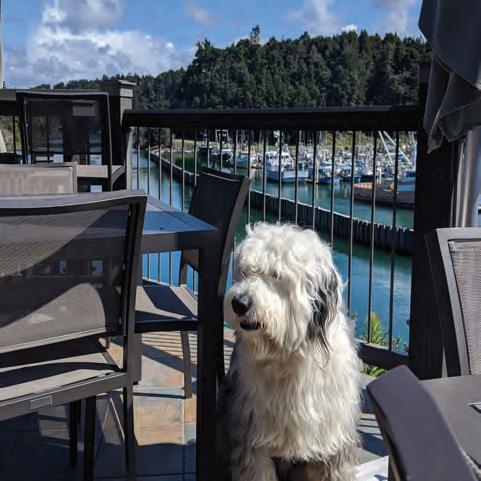





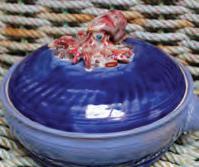
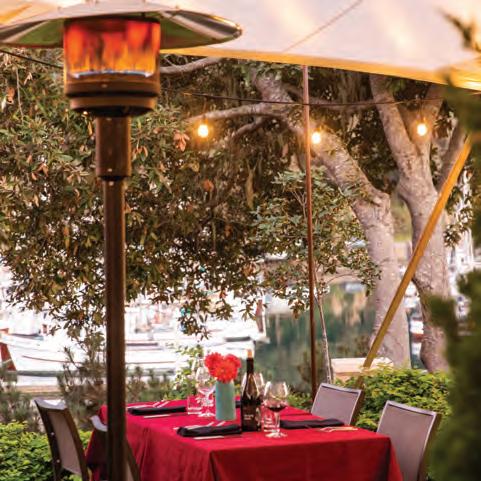
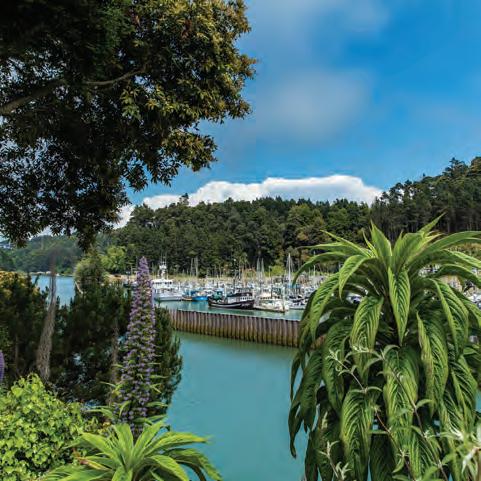

world’s largest killer whale skeleton on display at the Noyo Center’s Discovery Center, located in the heart of downtown Fort Bragg. This 26’ long orca skeleton is gracefully displayed in mid-dive, jaws wide open with massive teeth greeting all who enter. Learn his story, what he ate, how he died, and the incredible community science project he inspired in our local community. Explore the world of Rotifers in our newest exhibit, in partnership with the Exploratorium, and be sure to check out the Ocean Immersion Dome, the Sea of Skulls, or walk through a giant bull kelp forest. The Discovery Center store is full of interesting marine themed gifts, unique work by local artists, clothing, books and guides. Come be a part of the Noyo Center’s mission to advance ocean conservation through education, exploration and experience. Fun for all ages!
Open 11am – 5 pm , Thursday – Monday (closed Tues. and Wed.). Call or go online for seasonal hours.
WHERE: 338 N. Main St., Fort Bragg
MORE INFO: 707-733-NOYO (6696)• noyocenter.org
Get an up-close look at a sea star and other intertidal creatures in the aquarium, look through whale baleen, zoom in on migrating whales using high-powered spotting scopes, and walk next to a life-sized terra-form blue whale. Those are just a few of the things you can do when you follow the Fort Bragg Coastal Trail to Crow’s Nest Interpretive Center, located along the southern part of the Coastal Trail, with closest access through the Cypress Street entrance to the Noyo Headlands Park. Staffed by a dedicated group of volunteer ocean stewards, the Crow’s Nest is home to engaging, interactive, and dynamic exhibits telling the story of the Mendocino Coast and opportunities to learn more about what you can do to support ocean conservation. Fun for all ages!
Open 11am –3 pm , Thursday – Monday (closed Tues. and Wed.). Call or go online for seasonal hours. Admission is free.
WHERE: South Fort Bragg Coastal Trail near the Cypress Street entrance, or the trailhead at the western base of Alder Street from downtown Fort Bragg.
MORE INFO: 707-733-NOYO (6696) • noyocenter.org
Visit Noyo Center’s newest location, located in the Carine’s Landing building in the Noyo Harbor, for a cup of great coffee, pastries and morning fare, or soups and sandwiches for lunch. You will also find a nice selection of local wine and beer, and Slack Tide logo apparel and other items in the retail store. The deck overlooks the Noyo River where you can check out the wildlife and the activity going on in the harbor. Open Thursday-Monday, 8 am -3 pm
WHERE: 32430 N. Harbor Drive, Fort Bragg
MORE INFO: 707-962-8808 • noyocenter.org





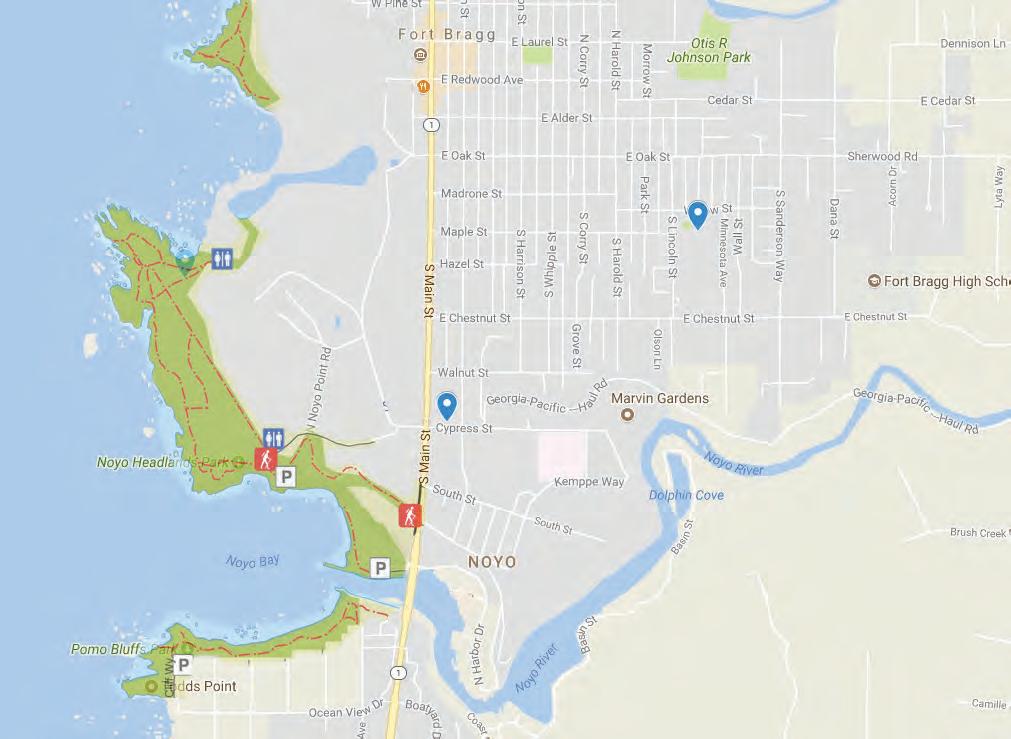


















While wandering around the sleepy North Coast town of Fort Bragg, consider a permanent souvenir from the stellar artists Mr. G, Niki Needles, and Nicola at Triangle Tattoo & Museum on Main Street. Climb up the bright red stairway to the museum and you will feel enveloped by the spirit, history and excitement of Tattoo.












Founded in 1986, Triangle Tattoo & Museum celebrates their 35th year of tattooing in Fort Bragg. One of only a few museums in the world dedicated to Tattoo History, this unique collection is fittingly housed in one of the town’s original Victorian storefronts. On display are striking, vintage exhibits of tattoo artifacts. Many cultures are represented including the Maori, Japanese, Native American, South Seas, European and American tattoos.


Mr. G & Madame Chinchilla are world-famous tattoo artists and historians quoted in the New York Times & other publications, and were featured in Discovery Channel’s 1st Tattoo documentary, “Tattoo, Beauty, Art and Pain.”

356-B North Main Street


Fort Bragg • 814
The Museum is free and open 7 days a week from 12 to 6 pm . Children are welcome. Triangle hosts many world-recognized visiting artists from around the globe. Dr. Lars Krutak, anthropologist at Smithsonian National Museum of Natural History noted in his visit: “One of the few places in the United States where you can learn about the history of this ancient form of human cultural expression is at Fort Bragg’s very own Triangle Tattoo & Museum.” This is the place to meander and view for anyone curious about the art and history of tattooing. Educational video documentaries play daily… Be Art with a Pulse!
WHERE: 356 B N. Main St., Fort Bragg • MORE INFO: 707-964-8814, TriangleTattoo.com
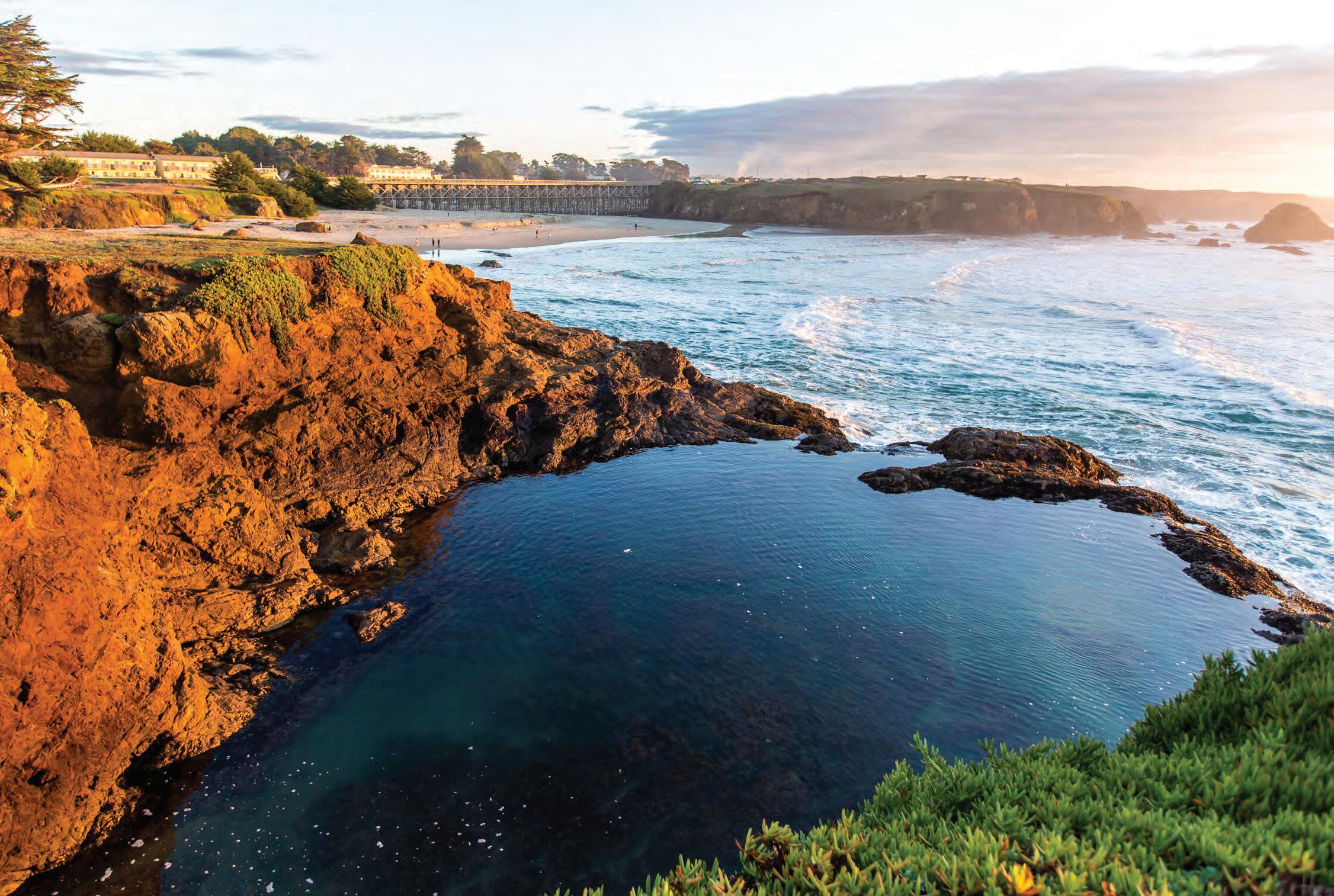
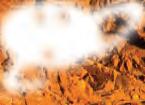

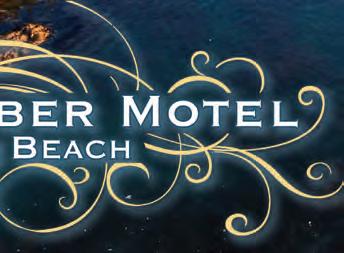








At Pacific Star Winery visitors are spellbound by the stunning views while enjoying an extensive selection of uncommon varietals and signature blends from Mendocino County’s heritage vineyards. The winery sits atop an active fault officially called the “Pacific Star Fault” named after the winery by geologists upon its discovery in 2006.
The winery’s cellar and tasting room sit over sea caves where the crashing waves below help to naturally filter the aging wine from its sediment. Because of its proximity to the ocean, salt from sea air gathers on oak barrels, and accelerates osmosis, creating unique wines. The atmosphere is casual, friendly and fun. Snacks are available if you decide to stay awhile, or you can pack your picnic basket and sit atop the cliffs as the waves crash and break on the rocks below; the winery’s spectacular site offers breathtaking coastal views. In the springtime this is the perfect place to see California gray whales pass by on their migration route.
Pacific Star has a comprehensive website where visitors can view photos of the winery and its beautiful location, learn more about its unique wine making process, seek out event planning, join the wine club for specials and discounts on wines you won’t find anywhere else, and check their tasting hours.
WHERE: 12 miles north of Fort Bragg at the 73.58 mile post on scenic Hwy 1 with easy RV parking. MORE INFO: 707-964-1155, PacificStarWinery.com


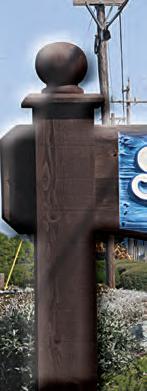

















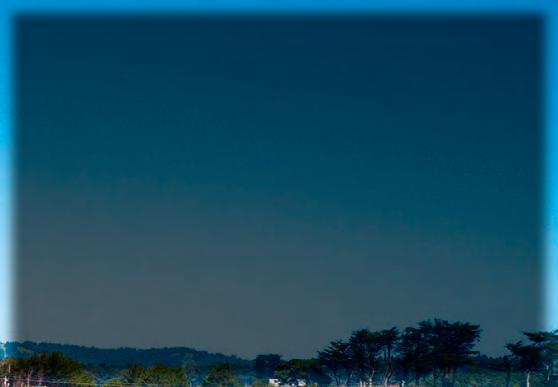



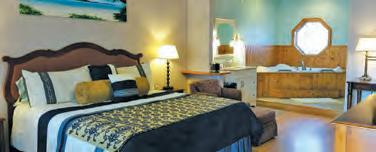


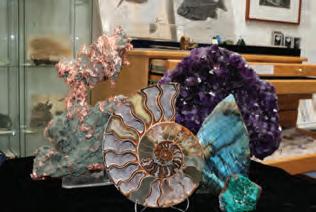



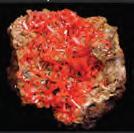
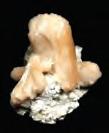


Beautiful Earth offers some of Earth’s oldest and most beautiful creations — over five thousand select specimens of minerals, fossils and meteorites. Beautiful Earth also offers an extensive library, gem elixirs, gem beads, and Earth-inspired art. Beautiful Earth feels like a miniature museum, being overseen by a geologist/mineralogist and an active field paleontologist, with over fifty years of combined teaching, museum curation, and field experience between them.
Education is critical to the mission of Beautiful Earth. Children are welcome and are encouraged to touch. Place your hand into a 200 million year carnivorous dinosaur track from Massachusetts. Touch a ten pound 148 million year old dinosaur poop, or a complete 70 million year old Hadrosaur thigh bone as big as a child. Or hold a remnant of the core of a long dead planet from the main asteroid belt – and marvel that what you hold in your hands is actually 4.6 billion years old.
They offer only natural minerals, crystals, and fossils from all over the world. Specimens are priced from the most affordable, found in the eight-drawer “student collection” cabinet, to those of the connoisseur.
Many say this is “the best rock shop in California,” or simply their favorite shop of any kind. If you love rocks, crystals, and the remains of ancient life, Beautiful Earth is a must visit. Beautiful Earth is open Thursday thru Monday from 10am-4pm. Where: Downtown Fort Bragg in the Depot at the corner of Laurel and Main. More Info: Call 707-962-3038 or visit earthbeautiful.net




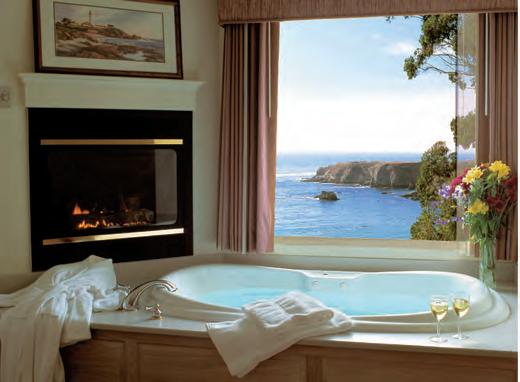







There are hundreds of coastal birds that frequent Mendocino County, and the Mendocino Coast Audubon Society invites you to see them for yourself. Join the MCAS for endlessly fascinating walks and field trips at the Mendocino Coast Botanical Gardens, MacKerricher State Park, Van Damme State Park, Virgin Creek and elsewhere.
The walks at the Botanical Gardens are regularly scheduled for the first Saturday and third Wednesday of each month, with free admission for Botanical Garden members and special reduced rates for nonmembers. Generally the Saturday walks are designed with beginners in mind and the Wednesday walks for more experienced birders, but anyone is welcome to join in, regardless of experience. Also, binoculars are available for those who need them.
Field Trips are scheduled for the second Saturday of each month. The locations, local birding hot spots, are selected to take advantage of seasonal birding opportunities. Check the Mendocino Coast Audubon Society’s calendar on their website for times and information.
MORE INFO: MendocinoCoastAudubon.org, Audubon@mcn.org; GardenByTheSea.org

Whether you are an experienced surfer or a beginner, you will find waves to suit you on the Mendocino coast. Many of the area’s more experienced surfers will be found at Point Arena Pier (35 miles south of Mendocino Village) and Virgin Beach, which is just north of Fort Bragg. Look for “overhead” and “double overhead” (literally higher than your head, or twice as high as your head) waves at these locations. Places more suited to intermediate-level surfers include Blues Beach (south of Westport); Pudding Creek (two blocks north of Elm Street in Fort Bragg) and Wages Beach (north of Westport). In Mendocino, Smuggler’s Cove (south of Big River Bridge) has waves that are bigger than they appear at first, and should not be attempted by beginning surfers. Caspar State Beach (on Point Cabrillo Drive off Hwy 1) is better suited for beginners. You’ll need a wetsuit, the water is in the low 50s year-round so you’ll probably also want a hood and booties. If you’re a beginner, learn surf etiquette by talking with local surfers. Surfboards, wetsuits and equipment are available to rent or buy at local surf shops and they can give you information you need, along with lessons, demos, trips and tours. And know your limitations, “Get swept away by the beauty, not by the waves!” MORE INFO: Mendocino.Surfrider.org




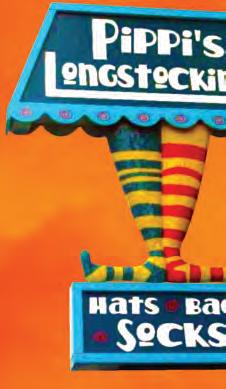























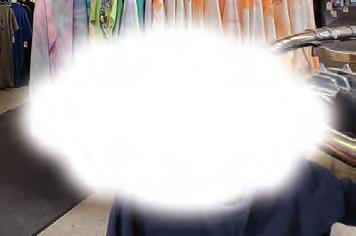



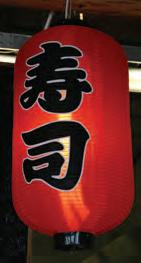






There’s now an amazing new way to experience the Redwood Route — on the back of a custom-built railbike. These two-person railbikes sit securely on the track, allowing passengers to make their journey in a peaceful and quiet atmosphere unlike anything else found on a railway. These railbikes are quiet enough that it’s likely you’ll see a great collection of animals, including blue herons, osprey, egrets, deer, river otters, and more.
Travelers depart as part of a small group, with a trained guide overseeing everything and leading the way along the track. Since the track is owned and operated exclusively by the Skunk Train, they are able to guarantee no trains or other traffic along the route. The guide is there to help out should anything come up, but these bikes are incredibly easy to ride — perfect for all ages and skill levels.
They even come with an electric assist — ideal for taking a relaxing breather while still moving along the track, or for a little bit of extra oomph while you make yourself up the gentle grade on the return trip. The 7-mile trip isn’t too tiring, so the electric motor probably won’t be necessary for most people — but it can certainly provide a nice break along the way. The excursions are about an hour long, and currently depart only from Fort Bragg.
WHERE:
MORE INFO: 707-964-6371








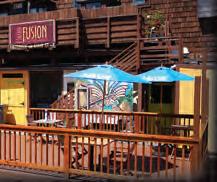
MacKerricher State Park offers miles of magnificent rocky coastline, beaches, dunes, bluffs and headlands that give way to forests, seasonal streams, grasslands, and a lake. Some of California’s richest tidepools form during low tide along the shore near Laguna Point, where offshore rocks attract black oystercatchers and provide a rookery for harbor seals.
The park encompasses nearly 2300 acres, over 450 of which are designated “underwater park,” preserving some of the best and most unique of California’s natural underwater ecosystems. Inglenook Fen, the last remaining coastal fen in California, supports salamanders, rare insects and shorebirds. Waterfowl and wading birds frequent Lake Cleone and Mill Creek; in fact, more than 100 bird species have been observed in MacKerricher State Park. A convenient boardwalk wanders past Lake Cleone, and another, the wheelchair-accessible Laguna Point Boardwalk along the beach, provides sweeping vistas of the coast and five overlook platforms for whale and harbor seal watching. The historic Haul Road runs through much of the park and is great for hiking and bicycling. Most of it is wheelchair-accessible as well. The park also offers opportunities for camping, horseback riding, fishing and abalone-diving, although some of the campgrounds are closed in the winter. Glass Beach, at the southern end of the park, is noted for brightly colored, wave-polished glass pebbles, remnants of broken glass dumped there between 1906 and 1967 (see page 34).
MORE INFO: www.parks.ca.gov/?page_id=436, 707-964-8898; Camping reservations,1-800-444-7275 or ReserveCalifornia.com

Since 1885 California’s renowned Skunk Train has been transporting passengers along the world-famous Redwood Route. The views on this scenic stretch of track are nearly the same as they would have been more than a century ago — the result of visionary forest stewardship and a dedication to the natural wonder of the redwoods. Some of the trees along the route are more than 1,000 years old, and reach more than 300 feet tall. They have awed passengers both young and old riding on the back of the Skunk for generations, and remain as delightful today as they were for those first riders.
The train offers two points of departure — from the iconic fishing town of Fort Bragg on the stunning Mendocino Coast, and from the inland city of Willits, nestled among the redwoods and sweeping hills of the 101 corridor.
From Fort Bragg you’ll explore the Pudding Creek, an estuary along which the first tracks were laid in the 1880s. The trip is beautifully scenic, with a large verdant waterway that still features old wooden pilings from long-forgotten trestle bridges. A bounty of wildlife calls the estuary home as well.
Wherever you choose as your point of departure, you’ll experience the same great connection with a living, breathing piece of history, and discover the majesty of the California redwoods in a way unlike any other. The Skunk Train operates year-round, is child and dog-friendly, and offers snacks and beverages (alcoholic and non-alcoholic) on board the train. Throughout the year there are seasonal event trains, and for most of December it transforms into the Magical Christmas Train, an experience featuring caroling, hot cocoa, an interactive story, and a visit from Santa Claus.
WHERE: (Depot) 100 W. Laurel St., Fort Bragg
MORE INFO: 707-964-6371, SkunkTrain.com
Since 1976, Gloriana Musical Theatre (originally The Gloriana Opera Company) has entertained Mendocino County audiences with blockbuster Broadway musicals, musicals starring young performers, and one of a kind special productions.
Throughout the year, the company offers workshops to improve technical and acting skills, and provides an annual scholarship program for students furthering their education in the performing arts. Call or go to their website for more information about workshops, tickets and upcoming shows, including if any have been postponed due to concerns about COVID-19.

WHERE: Eagles Hall Theatre, 210 N. Corry Street at Alder Street, Fort Bragg
MORE INFO: 707-964-SHOW (7469), Gloriana.org Gloriana.org








Fort Bragg’s 104-acre park is situated atop Fort Bragg’s bluffs overlooking a very dramatic coastline and ocean. The park includes 5.6 miles of multi-use trails with many stunning ocean views and dynamic views of the town and mountains beyond. Various stages of the park were opened between 2015 and 2018, and the park is now fully connected with access points at Cypress Street (south) and Elm Street (northern side of town). The park includes many community favorites such as the beautiful Otsuchi Point overlook, the stunning Johnson Point and Johnson Rock, Glass Beach, and the Crow’s Nest Interpretive Center, brought to you by the Noyo Center for Marine Science. The trail also connects to the North, across the Pudding Creek Trestle, to MacKerricher Park and south across the Noyo River Bridge to Pomo Bluffs Park: all together a distance of 7.5 miles. The multi-use trail provides the first public access to Fort Bragg’s rocky coast since the 1800s. Views are spectacular, and Noyo Headlands Park has already gained the enviable reputation of being one of the best places anywhere to view stunning sunsets. The park includes 18 unique hand crafted artist benches and five stunning murals.
Dogs are allowed off leash in the dog park (near the Cypress Street parking lot), but otherwise must be kept on leash.
The park was reclaimed from an industrial mill site formerly owned by GeorgiaPacific. Before the restoration, much of the site was covered with asphalt, which was removed, and the entire area was restored to its natural state. You can still see remnants of the old Mill Site to the east of the park. The $12 million project was funded through a combination of Prop. 84 funds, California State Coastal Conservancy funding and ATP funds from Caltrans.
WHERE: Access to the park is via Elm Street at the north end and Cypress Street at the south. Parking and admission are free, and the park is open 24 hours a day.
MORE INFO: city.fortbragg.com/666/Noyo-Headlands-Park; Noyo Center for Marine Science, 707-733-NOYO (6696), NoyoCenter.org
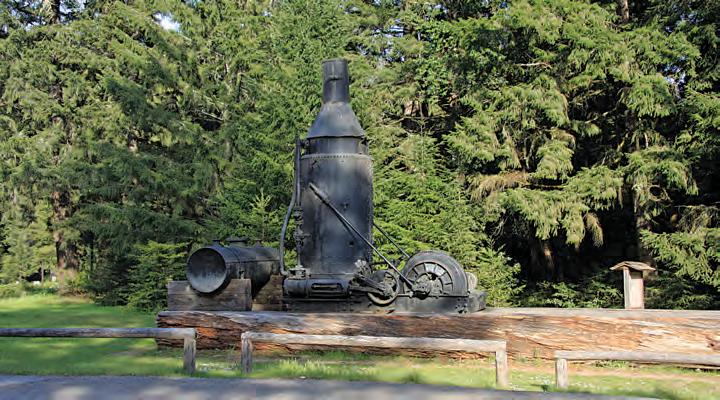
Sitting in the spray of a delightful waterfall on Chamberlain Creek Trail or staring out at the uninterrupted view from the top of Riley Ridge after a long hike through old redwood forests on the remote Volcano Point Trail, it’s easy to forget the bustling history of the land in Jackson State Forest.
A booming industrial logging center from 1862 until 1947, the land now serves as 50,000 acres of peaceful respite for visitors who come to see the forests. Maps and brochures available from the California Department of Forestry in Fort Bragg or online at the CalFire website (given below) show the location of trails where you can learn about the ecology, history and management of the forest or go mushroom hunting, hiking, biking or horseback riding. With your own bottled water and appropriate permits, overnight camping is available in rustic and equestrian campsites for a small fee. Leashed pets are welcome, and swimming is allowed in the rivers, although fishing is not.
WHERE: On Hwy 20 between Fort Bragg and Willits.
MORE INFO: Search calfire.ca.gov, 707-964-5674; MendoWalks.org/JSDF/JSDF.php; MendocinoFun.com/jackson-forest

Resting atop a small knoll in Fort Bragg on the west side of Main Street lies an ancient storehouse of history, a three-story Victorian mansion known as the Guest House Museum. Built primarily of coast redwood, the building has served numerous functions over the years. Its first role was as the Fort Bragg Lumber Company’s guest house for out of town company senior officials from San Francisco and VIP guest visitors. The lumber company owning it subsequently changed hands, and the function of this architectural marvel also changed, from guest house to entertainment hub to part of a military post; at one point it even served as a specialty boutique for a department store. Finally in 1985 then-owner Georgia-Pacific Corporation donated the building to the City of Fort Bragg.
Today it is a museum that documents 150 years of Mendocino history. Within the ornate mansion’s walls visitors will find a repository of artifacts that shed light on logging, fishing, steam trains, and wood and glass craftsmanship, along with fascinating photographs of the families who once resided in the bustling town of Fort Bragg. The Guest House Museum is run by the Fort Bragg-Mendocino Coast Historical Society. Hours vary seasonally.
WHERE: 343 N. Main St., Fort Bragg
MORE INFO: 707-964-4251, FortBraggHistory.org
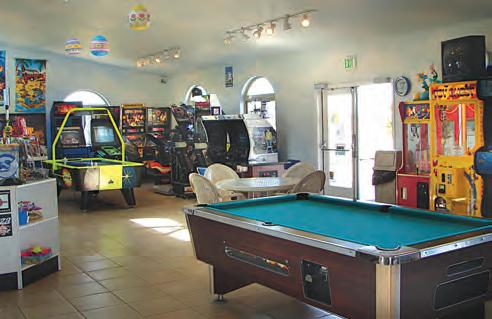
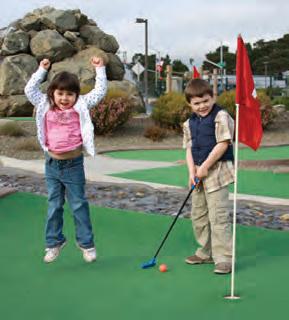
Wow, what a blast! At the Emerald Dolphin Mini Golf and Fun Center, all 18 challenging holes are located in and around gorgeous streams, fountains and waterfalls, and are designed to be tons of fun for all ages and experience levels. Also, the first nine holes are handicapped-accessible. To top it off, if you’re a guest at Emerald Dolphin Inn you’ll receive your first round free if you book directly with them, or at a discounted rate if you book through a third party.
After a round of mini golf, you can go inside the clubhouse and play a game of pool, or try your hand at today’s top arcade games including Dance Dance Revolution Extreme, pinball, air hockey and Big Buck Hunter. Also inside you will find delicious treats including fresh out of the oven corn dogs, soft pretzels, and sweet treats like candy and ice cream, as well as ice cold sodas, beer and more. There is even a private party room available for your next celebration or event. Parties can be planned with the Emerald Dolphin staff in any theme you desire. They do all the decorating, food, drinks and cleanup: it just doesn’t get any easier than that. Plus, Emerald Dolphin is the only place in the county that offers Gorilla-Grams, a “gorilla” dressed in costume who will arrive at your next party to dance your guests into hysterics! Call well in advance for the perfect gift for that someone who has everything, and check the website for more information. Emerald Dolphin Mini Golf has everything you need for an outrageous party. WHERE: 1211 S. Main St., Fort Bragg
MORE INFO: 707-964-6699, EmeraldDolphin.com





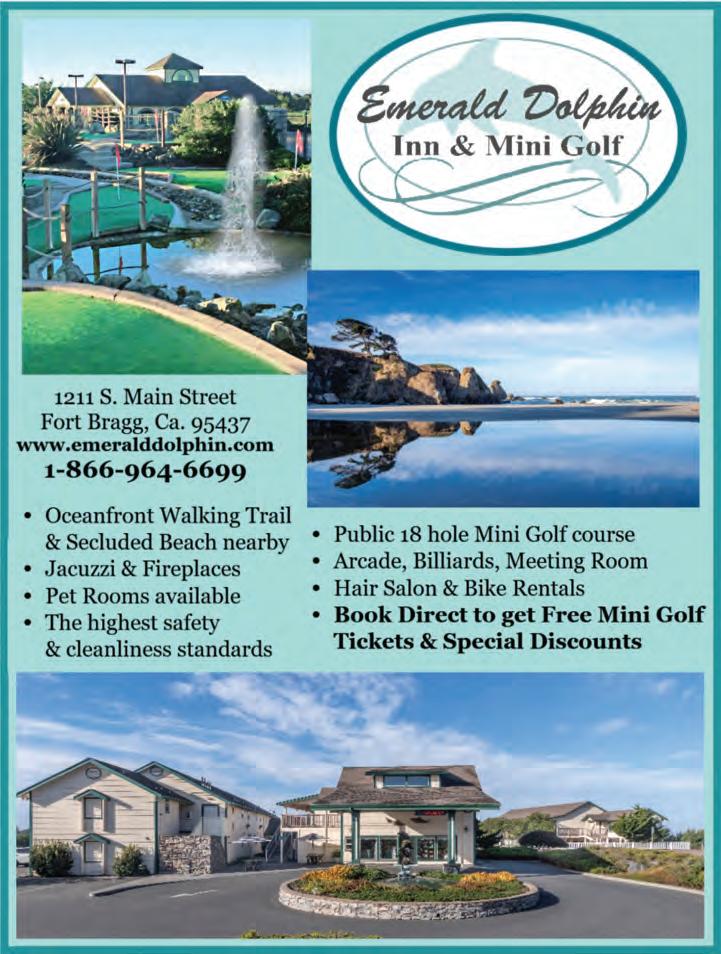
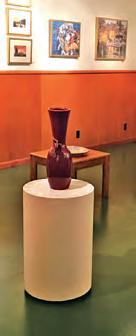








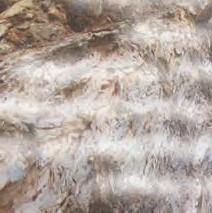

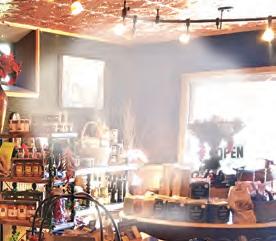


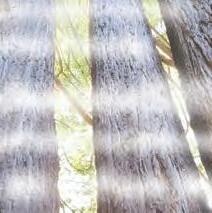
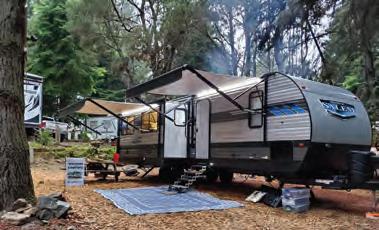





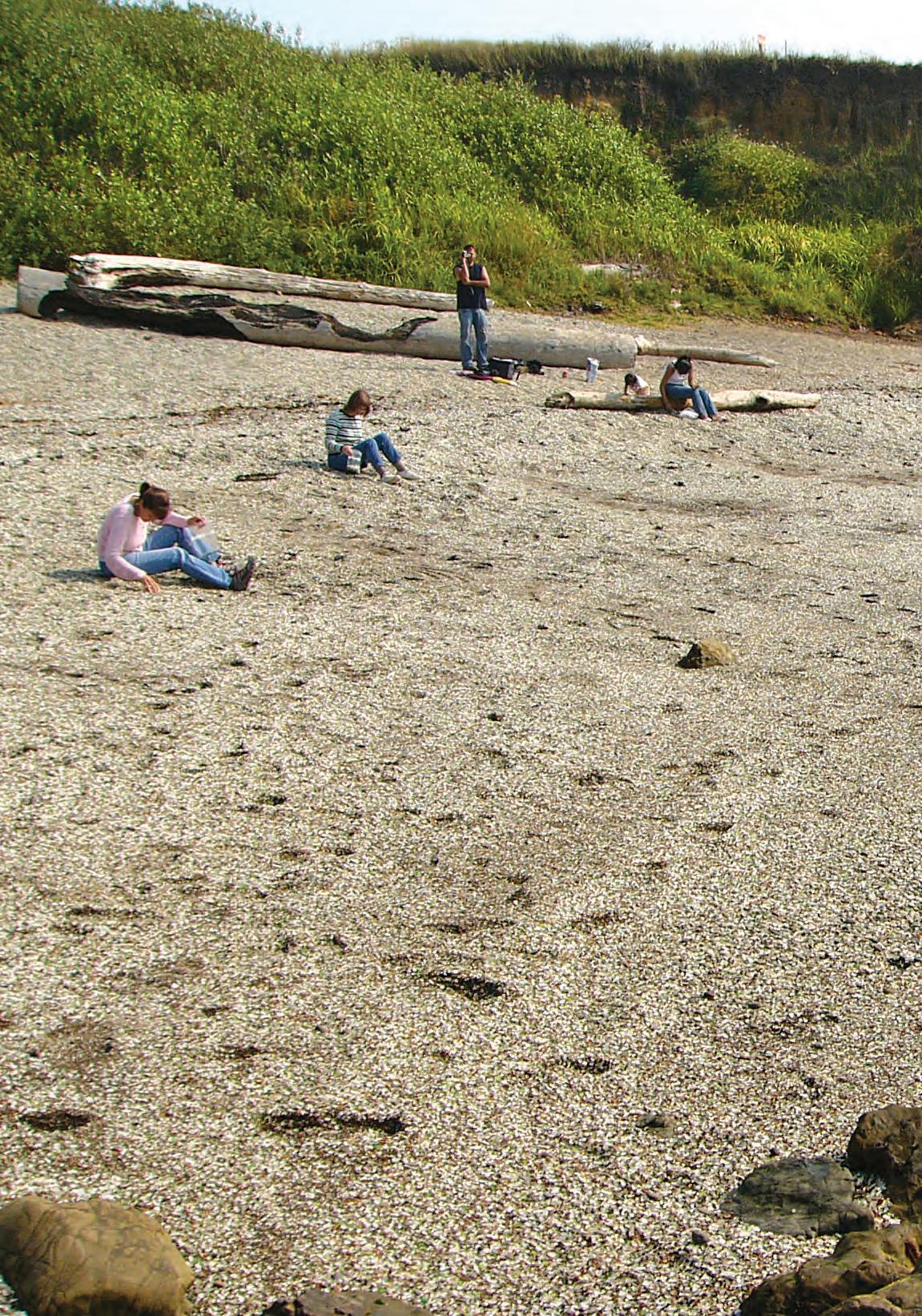
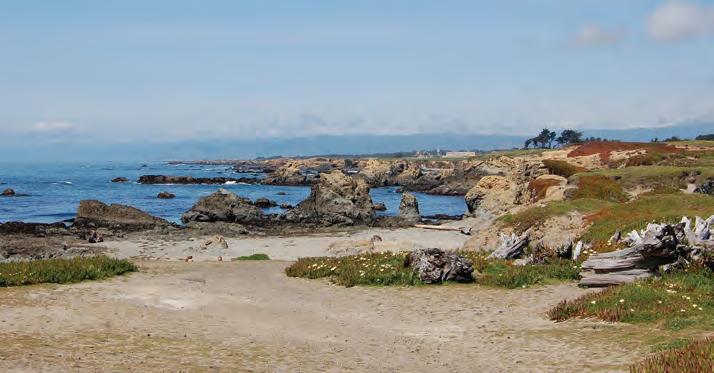

At first you might think that the sea glass covering this beach has been there practically forever. Not so. For centuries it was a common practice of people who lived in seaside cities to dump their trash into the ocean, and from 1906 through 1967 it was true of people in Fort Bragg as well. In 1967 the practice came to a screeching halt, however, and the coastal dumps in Fort Bragg were cleaned up. Perhaps by way of thanks, the ocean responded by washing up beautiful multicolored pieces of wave-tumbled glass from those very dumps onto its beaches.

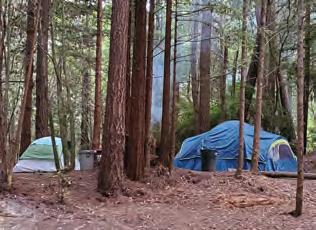
The most celebrated of these beaches of polished glass is located in MacKerricher State Park. It is very safe to walk on. All along its shore there are gem-like pieces of wave-tumbled glass in a rainbow of vivid colors glistening in the sun. There is now a stairway down to Glass Beach from the new Noyo Headlands Park.
Glass Beach is a fantastic place to bring the family to wander. There are also plenty of tide pools there to wade through and see crabs, mollusks and aquatic plants. However, please leave the glass where you find it. Much of the sea glass that was originally there is now gone, and at the rate it’s disappearing estimates are that the rest could be gone within 30 years. Plus, it’s a misdemeanor to remove any from state park property. WHERE: You can find the beach at the end of Elm Street; signs on Main Street point the way to a parking area and paths leading to the beach.


The steam engine and the highly specialized logging railroad formed an integral part of the Mendocino coast’s rich history from the late 19th century through the 1930s. Though now long gone, they have not been forgotten. In a barn just behind the Skunk Train Depot in Fort Bragg, the Mendocino Coast Model Railroad and Historical Society has built a remarkable model logging railroad layout displaying miniature structures and equipment from logging operations that existed along the coast here in Mendocino County. The model is set in the 1900 to 1940 period, when steam was still king and diesel power was just entering the scene.

The layout is built in G (Garden) scale, meaning everything is approximately 1⁄24 of life size. There are about 1,800 feet of 2 1⁄4 -inch wide track, with seven model trains usually running on them at the same time. There is an incline, a switchback, tunnels, a re-creation of the existing downtown Fort Bragg depot and an engine house. Three of the five trestle bridges that existed between downtown Fort Bragg and Ten Mile River have also been re-created, and the club plans to add the other two to the layout as well. There are even scale models of the Point Arena and Point Cabrillo lighthouses, the latter with a working Fresnel lens and foghorn.
The model railroad is open Wednesday, Saturday and Sunday from 10:30 am to 2:30 pm . Admission is free with your Skunk Train ticket stub, or at nominal cost otherwise. WHERE: Located right behind the Fort Bragg Skunk Train Depot at 100 W. Laurel St. MORE INFO: MendoRailHistory.org (Check out their Virtual Tour) and on Facebook


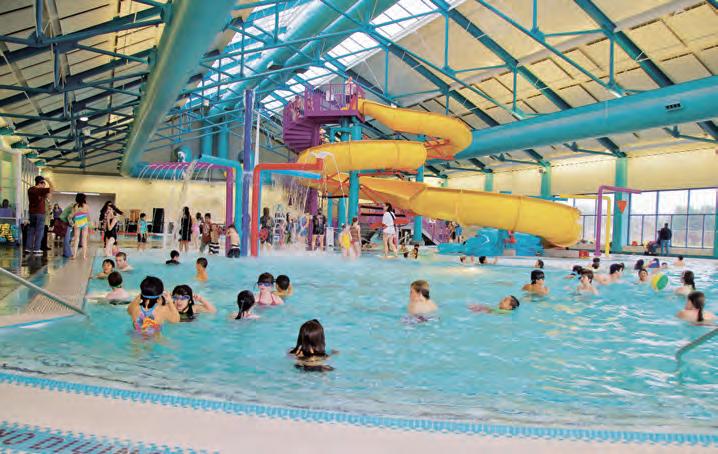
Much more than a swimming pool, fitness center, community center and outdoor activity area combined, the C.V. Starr Community Center offers people of all ages a wealth of wonderful, exciting things to do and magnificent facilities to do them in. The physical infrastructure is a 4-acre campus that hosts an off-leash dog park, a 10,000 square foot skate park, sun deck, two petanque (an ancient Roman game) courts, and a 43,000 square foot aquatics and fitness facility. Inside that facility they have a full waterpark-style pool complete with a 146 foot water slide, zero depth entry warm water leisure pool, lazy river, eight lane lap pool and a 1 meter diving board. In addition to the pools there are two group exercise studios, a wellness center with a full range of weight and cardio equipment, and multipurpose rooms for meetings and an incredible variety of enrichment classes for everyone from pre-schoolers to senior citizens. Visit their website for information on hours, fees and class schedules.
WHERE: 300 S. Lincoln St., Fort Bragg
MORE INFO: 707-964-9446, MendoCoastRec.org

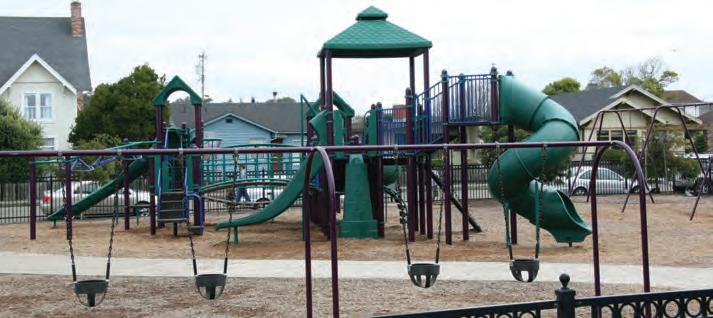
Noyo Headlands Park , home to the famous Glass Beach, offers 4.5 miles of trails along the bluff top overlooking spectacular ocean views. This is the crown jewel of the city’s park system, and its newest park. The trail, part of the California Coast Trail, provides the first public access to Fort Bragg’s rocky coastline since the 1800s. Access is via Elm Street to the north and Cypress Street to the south. Open 24 hours.
Pomo Bluffs Park offers gorgeous views from the southern bluffs above Noyo Harbor. This 25-acre park offers outlook points and benches, coastal pedestrian and bike trails, and interpretive exhibits. From Hwy 1 take Ocean View Drive to Cliff Way to get there. Open dawn to dusk.
Otis R. Johnson Wilderness Park is located at the east end of Laurel Street, southeast of Fort Bragg Middle School. This 7-acre park offers shady walking trails and a close-up experience with nature, including old-growth and second-growth redwood trees. Charming wooden footbridges cross a stream that has undergone extensive aquatic restoration. Open 7am to 8 pm May through October and 7am to 5 pm November through April.
Harold O. Bainbridge Park is designed for the whole family to enjoy. The park offers tennis courts, a basketball court, and open space to play or spread a blanket and enjoy an afternoon picnic. Its Wiggly Giggly Playground is located on Laurel Street, between North Harrison and North Whipple Streets, across from the Fort Bragg Library. It offers swing sets, slides and equipment of all shapes and sizes to climb, hide in, run around and hang from. The park is open 7am to 10 pm
MORE INFO: City of Fort Bragg Public Works Dept., 707-961-2824







Mendocino Coast Botanical Gardens offers everything from colorful displays to thunderous waves. Open year-round, the mild maritime climate makes it a garden for all seasons. The Cliff House provides an indoor vantage for watching the winter and spring grey whale migration. Spring brings a profusion of bulbs and stunning rhododendrons. In summer you will find a riot of color in the Display House overflowing with fuchsias, begonias, and hungry hummingbirds. Savor a strawberry from the organic demonstration Vegetable Garden. In the fall, an abundance of mushrooms burst forth — a mycologist’s paradise! A birding hot-spot, the Gardens provides habitat for more than 180 species that live in or visit the Gardens yearly. Bring the whole family and make a day of it. Dogs are welcome and enjoy free admission. Experience the rugged beauty of the Mendocino Coast mixed with the peaceful tranquility at this garden by the sea. Visit www.gardenbythesea.org for admissions information. The Garden Store and Nursery are open yearround; Rhody’s Garden Café is open April to Sept. There is no admission fee to shop or dine.
• Dog-Friendly • Retail Store & Nursery • Café with Wi-Fi • Events & Weddings
WHERE: 18220 N. Hwy 1, Fort Bragg
MORE INFO: For a listing of special events and workshops visit GardenByTheSea.org

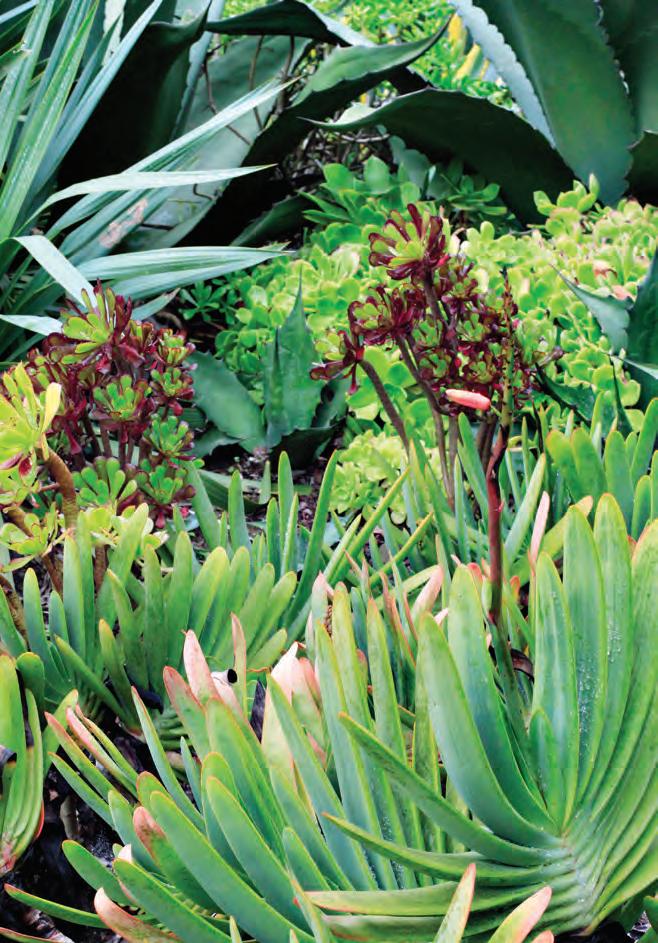

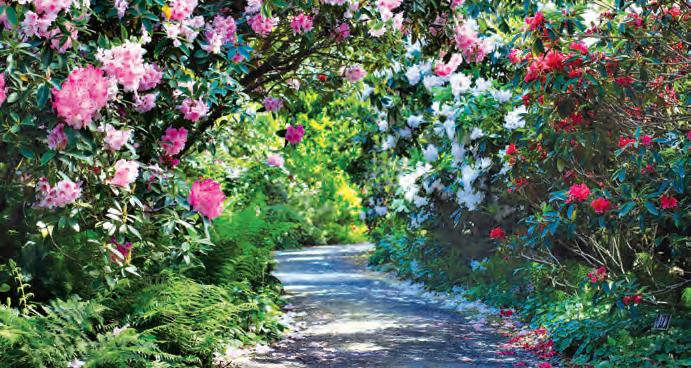





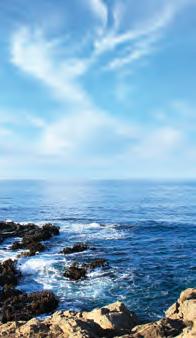

The beautiful, laid-back village of Westport perches on bluffs 80 feet above sea level, approximately 28 miles west of Hwy 101 and 13 miles north of Fort Bragg. During the redwood lumber boom, for a while it was the fastest growing coastal town north of San Francisco. It served as a busy commercial shipping harbor, with two massive wharves loading lumber as well as wool, oats, tanbark, shingles and railroad ties into schooners bound for San Francisco. At its peak Westport boasted 14 saloons.
Just south of Westport were two other bustling lumber towns, Newport and Kibesillah. They only existed for about 40 years, from 1867 to the early 1900s. During their heyday it was hard to imagine that their future would be anything but bright, but in the long run their harbors proved too difficult and dangerous to be viable. The beginning of the end for them came in 1885, when lumber operations moved to Fort Bragg. Today not even a ghost town remains to mark where they once stood.
These days, residents settle in the Westport area seeking a strong sense of community and an escape from the harried pace of city life. Visitors find a charming windswept seaside village with a bluff-top park suitable for picnics, volleyball games and weddings, where a bustling shipping yard once sat.
Camping on the beach is a favorite Thing To Do in Westport. Westport Union-Landing State Beach covers over 3 miles of rugged and scenic coastline, and has 86 campsites available on a first-come, first-served basis. The magnificent vistas, sunsets and tree-covered mountains in the background provide an inspiring backdrop to the park. In addition to campgrounds, Westport’s hotels and restaurants serve travelers, many of whom visit for the village’s annual events. These include Whalefest in March, the Volunteer Fire Department’s annual barbecue every August and the Great Rubber Ducky Race, a Mother’s Day (“Ducky Sunday”) event that also includes a tri-tip and vegetarian barbecue, a quilt raffle, and a decorated rubber ducky beauty contest. The course follows Wages Creek to the Pacific surf’s edge. Other favorite Things To Do: pinicking on the headlands while looking for birds or gray whales, or just watching the sunset.
MORE INFO: www.parks.ca.gov/?page_ id=440, WestportVillageSociety.orgw
60
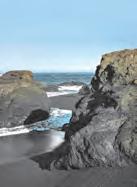




Kyle Siler (aka Carlos Amigos) set his sights to building his own roadside attraction back in 2008. His artistic journey was well-rounded; he learned to weld and completed a pilgrimage to Wisconsin to view the art of Fred Smith, his inspiration. His goal was to put his small town on the map with a classic roadside attraction. Deciding on a whale them was easy, what better way to celebrate the annual migration visible from his yard? Built with his newly-acquired welding skills, several tons of concrete, and a dash of mosaic sculptures, Amigos slowly transformed his yard into a destination. True to the tradition of roadside attractions, the whale features bright colors, and it has a few special tricks, too. At the top of the hour between 10 am and 3 pm , the whale spouts water from its spout. The whale is supported by donations and the income generated by renting out the artist’s studio for overnight stays.
WHERE: 37060 Hwy 1, Westport
MORE INFO: https://bit.ly/2ZJFABJ







If you’ve ever wanted to walk part of the California Coastal Trail, the Peter Douglas Trail is a perfect sampling of everything it has to offer. This 2.3-mile extension on the southern end of the Lost Coast Trail is rugged, wild, and blends together forest and ocean topography. Ultimately, this portion of the trail connects to the Lost Coast Trail, which is mainly located in Humboldt County. A four-wheel drive vehicle is recommended for this outing, which is only accessible from June-October. Be aware that there is no cell reception in the area, so any maps or information should be downloaded before you get underway. Expansive views of the Mendocino coast, old-growth redwoods magically sculpted into candelabras, wildflower meadows, and 300 hand-built steps are only a few of the featured highlights of the trail. Roosevelt Elk and other wildlife are often seen near Usal Beach. Shady Dell was part of a privately-owned property until 2011, and has not been accessible to the public for over a century. Restoration has healed and continues to bring back streams, trees, meadows, salmon, and forests damaged by logging and building roads. WHERE: Follow Usal Road (narrow and rough). Call the Mendocino DOT at 707-463-4363 to verify road conditions beforehand.

1. P lan ahead. Many wineries have limited hours. Appointments to taste and tour wineries are very easy to set up and in many cases can be quite impromptu, so don’t hesitate to call ahead even if it’s last minute.
2. A sk questions. Wine tasting is an opportunity not only to educate your palate, but also to learn more about the winemaking process.
3. De signate a driver. For a carefree day of tasting, this is the best way to go. Available local tour services are fun and especially affordable. It is illegal for a tasting room to serve wine to anyone who appears intoxicated, even if they have a designated driver — so taste responsibly.
4. Feel free to use the dump buckets set out on the tasting bar for excess wine.
5. Limit yourself to no more than four wine tastes per winery.
6. A sk before you picnic at a winery, and never bring other alcoholic beverages to drink at a winery.
7. C hildren are welcome during non-event weekends, but please keep an eye on them. Most wineries operate heavy equipment and therefore it is not safe for unsupervised children. Remember, no one under the age of 21 may sample wine — not even your children.
8. A lways taste from whites to reds. If you’ve already entered the red list and want to try a particular white again, try another day. If you’re on the cusp of whether or not to buy it, take your best guess or come back for another try later.
9. Try vertical/horizontal tasting. Vertical tasting involves sampling the same wine from different years. Horizontal tasting involves sampling the same vintage year and wine from different wineries.
10. S tep away from the wine. If you’re in a winery that’s very busy at the tasting bar, back away from the bar after receiving a tasting.
11. Don’t wear perfume, cologne, or lotions. The aromas of the wine mingle with strong scented cosmetics, which alter perception in taste, and can ruin the experience for others.
12. Follow the winery’s advice on tasting order. Winemakers’ styles differ, so trust the order provided by each winery’s experts.
13. Acidity: Since acid is present in all grapes, it’s also present in all wines. It is extremely important in determining structure, shape and lifespan, and it helps preserve wine for longer aging. Good acid levels can make a wine crisp and refreshing, supporting the aftertaste.
14. A ppellation: In the United States, appellation is a grape-growing area defined strictly by a geographic area. If a wine label cites an appellation, 75% of the grapes must be grown in that appellation. (For a more detailed explanation of Appellation, see 37, 38 and 39.)
15. A roma: Refers to fragrances in the wine that are characteristic of the grapes. For instance, Chardonnay might be described as
citrusy. Its aromas of lemon, lime or grapefruit come from the grapes; they are not added. Also see Bouquet or Nose.
16. B alance: An integration of the major components of wine (fruit, acidity, tannins, alcohol, oak) so none outweighs the other. A balanced wine fills the mouth with flavors.
17. B arrel Fermented: Wine that is fermented in 55-gallon oak barrels contributing to an increased complexity and flavor. The interaction with wood adds suggestions of spice and vanilla to wines.
18. B ody: The feeling of a wine’s weight in the mouth, such as full-bodied, medium-bodied or light-bodied.
19. B ouquet: The fragrances in the wine that are introduced by the wine-making process, including the smell of the oak (vanilla) or the yeast in the wine.
20. C hewy: Describes full-bodied, sometimes tannic wines — rich enough to chew on.

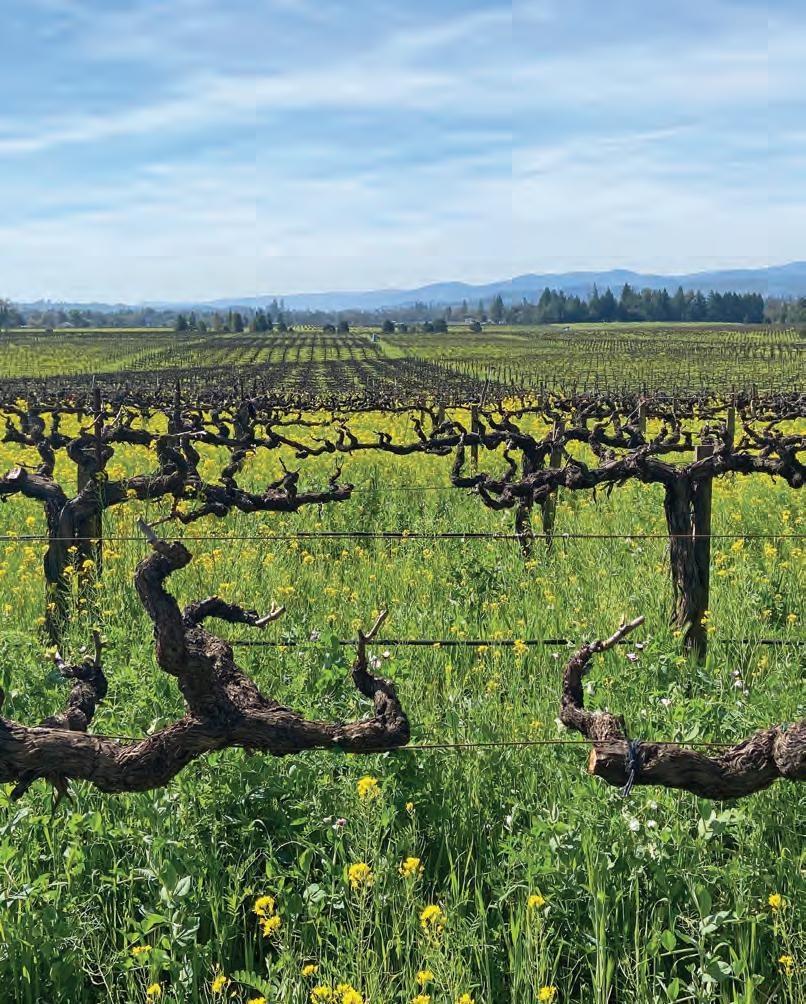
21. Complexity: The interplay of a wines many characteristics. A wine can be at once rich and deep, yet balanced and showing finesse.
22. Corked: The term corked refers to wine that smells moldy and disagreeable as a result of a bad cork likely tainted with bacteria called TCA (trichloroanisole).
23. D ry: A wine with little or no perceptible sweetness.
24. Earthy: Wine, such as Pinot Noir, that has the smell or slight taste of fresh dirt.
25. E nology: The science of winemaking, also spelled oenology.
26. E state Bottled: Indicates the winery owns or controls the grapes that produced the wine in the bottle.
27. Fermentation: The process by which yeast converts sugars into alcohol and carbon dioxide, turning grape juice into wine.


28. Field Blend: A common practice among the early grape growers in Mendocino County, where complementary grape varieties were interplanted in a vineyard. The grapes are harvested and fermented together, creating a field-blend wine.
29. F inish: The taste that remains in the mouth after the wine is swallowed. A long, lingering finish is considered desirable.
30. Fortified: The addition of brandy or spirits to wine to increase alcohol content.
31. G rassy: An aroma or taste of grass or newly-mowed hay — usually associated with Sauvignon Blanc.
32. L ees: Sediment and yeast found in a barrel or tank during and after fermentation. More winemakers are using the old technique of aging wine on the lees to increase complexities in aromas and flavors.
33. L egs: The drops of wine that slide down the sides of the glass when it is swirled, indicating the alcohol content in the wine.



41. Residual Sugar: The amount of unfermented grape sugar remaining in a wine. Dessert wines have a high level of residual sugar, while dry table wines have little to no residual sugar.
42. S plit: The term used for a six-ounce bottle of wine, usually champagne.
43. S ulfites: A natural by-product of fermentation. Sulfites (in small quantities) may be added to wine to guard against spoilage.
44. S ur Lie: A term used for wines aged on the lees (also see Lees #32).
45. Ta ble Wine: The legal term for wine that is less than 14% alcohol. Any wine over 14% alcohol must state the alcohol content on the front label and may not use the term “table wine” on the label.
46. Tannin: Chemicals found in the skins of many fruits, including grapes, which impart astringency. Tannin naturally preserves wine from oxidation and is a primary component in determining the wine’s structure and aging potential.
47. Tartrates: Natural, purely harmless crystals from the tartaric acids present in wines that often form in used casks, in wine sediment and on used corks. Although they look like cut glass, they are completely safe, and are a positive indication to experienced tasters that a wine has not been overly processed.
48. U nfiltered: Some winemakers do not filter their wine because they believe filtering strips aromas and flavors from the wine. However, these wines can be clarified using a fining process.
49. U nfined: Wine that was not treated with any fining agents; however, it can be clarified using filtering. Some winemakers believe fining wine strips essential aromas and flavors from the wine.
50. Varietal: Term used to describe a wine produced from a particular type (variety) of grape. Cabernet Sauvignon, Merlot, Zinfandel, Chardonnay, Pinot Noir, Sauvignon Blanc and hundreds of others are examples of varietal wines.
51. Varietal Character: The aromas and flavors typical for a particular grape variety.


34. L ength: The amount of time a wine’s taste and aroma are evident after swallowing.
35. M ade and Bottled By: The legal phrase used if a winery crushed, fermented and bottled at the same location at least 10% of the wine in the bottle.
36. N ose: Refers to how the wine smells, similar to aroma and bouquet — as in, “This wine has a great nose.”
37. Oa ky: Describes the aroma or taste character of a wine that has interacted with the oak of a wood barrel.
38. O xidized: A loss of freshness from exposure to air. If a wine has been open for several days, it will become oxidized.
39. Produced and Bottled By: A legal phrase that indicates the winery crushed, fermented and bottled a minimum of 75% of the wine in the bottle.
40. R acking: The traditional practice of moving wine from one container to another. Essentially it is decanting on a grand scale by moving wine from barrel to barrel to rid the wine of sediment.
52. Va riety: Term used to describe a type of grape. A wine made from a particular grape variety (e.g., Zinfandel) is referred to as a varietal.
53. Vintage: The year the grapes were grown and harvested.
54. Viticulture: The science of grape growing. When including the production of wine, the proper term is viniculture.
55. Wine Thief: A glass or plastic tube used to get a sample of wine from a barrel or other container.
56. Ye ast: Important microorganisms that cause fermentation by converting sugar to alcohol.
57. A ppellation: is a term used to define different grape growing regions. If “California” is on a wine label, the wine is made from grapes grown anywhere in California. If “Mendocino County” is on the label, then at least 75% of the grapes were grown in Mendocino County. Within the Mendocino County appellation there are almost a dozen sub-appellations, including the Anderson Valley, Redwood Valley and Mendocino Ridge.
58. M any appellation boundaries are easy to understand. State and county appellations of origin such as California and Mendocino County are defined by governmental boundaries.
59. S ub-appellation boundaries are determined by similar climatic conditions, soil types and weather patterns, or what the French call “terroir.” Variations in terroir contribute to different flavors in the same grape variety grown in different regions. Mendocino County currently has 10 such legally defined AVAs, or American Viticultural Areas.
60. A licante Bouschet: A cross between Petit Bouschet and Grenache, Alicante Bouschet’s red flesh and dark skin produce a wine with deep, intense color.
61. B arbera: Known for its rich color, low tannins and high acid, this Italian grape came to California in the 1880s and today is part of the “Cal-Italia” varietal trend produced by several Mendocino County wineries.
62. C abernet Franc: Wine produced from this grape can have the intensity of flavors of a Cabernet Sauvignon without the overpowering tannins, allowing it to be enjoyed without waiting years for the tannins to soften.
63. C abernet Sauvignon: Described as the “King of Red Wines,” this small grape produces some of the most magnificent and sought after wines in the world. Through DNA testing Cabernet Sauvignon was found to be a cross between Cabernet Franc (red grape) and Sauvignon Blanc (white grape).
64. C arignane (Carignan): Grown by early California wine pioneers Carignane produces a fruit-driven, easy-to-drink wine that is used as a blending wine, as well as a single varietal wine.
65. C hampagne: Term for sparkling wine made in the Champagne region of France.
66. C harbono: Thought to be a relative of Barbera or Dolcetto, or both varieties, that dates back to the 1880s in California. It is popular within the current “Cal-Italia” movement in the wine industry.
67. C hardonnay: The Queen to Cabernet Sauvignon’s King, this white grape variety produces the famous Champagne, Chablis, White Burgundy and Maconnais wines from France, and is the most popular white wine in the world. As a varietal wine, Chardonnay can range from rich, oaky and buttery to fresh, crisp and fruity.
68. Ch enin Blanc: Once a popular wine ranging in style from dry to semi-dry to sweet, Chenin Blanc primarily is used for blending. The fruity, well-balanced wine is more challenging to find as a single varietal, but for white wine lovers, it can be worth the hunt.
69. Cinsaut (Cinsault): A Rhône varietal used to blend grapes or to produce an aromatic rosé, Cinsaut produces a soft, light-bodied red wine with perfume aromas and fruit forward flavors.
70. Dolcetto: From the Piedmont region of Italy, Dolcetto is produced in two distinctly different styles: a soft, slightly sweet aperitifstyled wine or a robust, hearty rich wine. A classic Dolcetto exhibits flavors of citrus peel, almonds, blueberries and even licorice.
71. French Colombard: Also known as Colombard, this white grape variety once was the second most planted grape in California.
Today it rarely is found as a varietal wine, but with its fruit-forward flavors, it is used as a blending grape.
72. Fumé Blanc: A fanciful name for Sauvignon Blanc.
73. G ewürztraminer: Originally from the Alsace region of France, Gewürztraminer quietly gained fans for its strong floral aromas and classic lychee-nut and spicy flavors. This versatile, fruity white wine can be made semidry to bone dry as a late harvest dessert wine.
74. G renache: In France’s Rhône region, Grenache is used in the classic Châteauneuf-duPape. In California it is often used in delicious Rhône varietal blends or in Rosé.
75. M albec: Often used in Bordeaux-style blends and as a single varietal wine.
76. M arsanne: A white grape originating in the Rhône region of France. It frequently is blended with other Rhône varietals.
77. M eritage™: A trademark name developed by the Meritage Association to identify blends made from specific Bordeaux varietals. Association wineries’ Bordeaux must be produced from a blend of two or more of the following varieties in order to be called a Meritage: Cabernet Sauvignon, Merlot, Cabernet Franc, Malbec, Petit Verdot, St. Macaire, Gros Verdot, and Carmenere. No single variety can be more than 90% of the blend. For a white wine Meritage, the wine must have two or more of the following varieties, and no single variety can be more than 90% of the blend: Sauvignon Blanc, Semillon and Sauvignon Vert.
78. Merlot: A classic Bordeaux grape traditionally used for blending. In the early 1970s Merlot gained popularity with wine drinkers seeking a softer, fruitier red wine.
79. M ourvèdre: Mourvèdre arrived in Northern California in the 1870s from the Mediterranean regions of Spain and France, where it was called Mataro. It often is blended with varietals, such as Grenache, to create a fruity, crisp Rosé.
80. M uscat: A versatile grape with perfumy aromas and fruit-forward flavors dating back to early civilizations. Muscat varieties include Muscat Blanc, Muscat of Alexandria, Muscat Hamburg (Black Muscat), Orange Muscat and more.
81. Peloursin: An almost extinct French Rhône region variety that has been identified as having ties to Petite Sirah.
82. Petit Verdot: Used to blend with Cabernet Sauvignon or with other Bordeaux varietals to add color, a spicy quality and additional structure or backbone. This wine is rarely found as a single varietal.
83. Petite Sirah: DNA studies show Petite Sirah is the Rhône grape Durif, a cross between Peloursin and Syrah. Although called ‘petite’ the wine is anything but — it offers robust flavors and plenty of tannins.
84. P inot Gris: Pinot Grigio is a natural mutation of Pinot Noir that yields a soft, perfumy white wine.
85. P inot Noir: Grown in the cooler regions of Mendocino County, this fog-loving grape is an essential component in the production of some French Champagnes.
86. Port: This term is used to describe the famous fortified sweet wine made in Portugal. Port-style wines are made in the United States from a variety of grapes.
87. R iesling: Also known as Johannesburg Riesling or White Riesling, this classic German varietal was once produced by many California wineries. Now it is rarely found on a winery’s tasting list. Generally a flowery, fruity dry wine with high acid and low alcohol, it can be also be made in a semi-dry and late harvest style.
88. Rosé: A pink or salmon colored wine produced from red grapes. Because the juice has limited contact with the skins and seeds that give the wine structure and tannin, Rosé is a soft, easy-to-drink wine best served chilled.
89. Rousanne: A Rhône variety frequently blended with Marsanne and occasionally Syrah, Rousanne contributes good acidity and aromas of herbal tea and floral notes to the blends.
90. S angiovese: Brought to Mendocino County by Italian immigrants, Sangiovese is produced as a varietal wine with possibly small amounts of other wines blended in to add a layer of dimension or additional flavor components.
91. S auvignon Blanc: Also known as Fumé Blanc, Sauvignon Blanc is a classic variety that is an alternative to Chardonnay. Its styles can vary from grassy and herbaceous, to citrus qualities of lime and grapefruit, to flint and mineral qualities with gooseberry flavors.
92. S emillon: Traditionally blended with Sauvignon Blanc to produce dry table wine or a sweet dessert wine, including the renowned dessert wines from Sauternes, France. As a single varietal, Semillon displays aromas and flavors of figs and honey.
93. S hiraz: The Australian and South African name for the Syrah grape. See Syrah for additional info.
94. S parkling Wine: Usually produced from Chardonnay, Pinot Noir and Pinot Meunier, this wine bubbles when poured into a glass due to carbonation. Harvested early to capture the tangy flavors and high acids, a second fermentation in individual bottles starts with the addition of a small amount of sugar. Carbon dioxide, a natural by-product of fermentation, is trapped in the bottles and creates tiny bubbles when the sparkling wine is uncorked. This method of producing sparkling wine is called methode champenoise.
95. Syrah: Syrah is a warm climate wine with characteristics that include white pepper, leather, wild gamey and intense dark berry flavors.
96. Tempranillo: Considered the Cabernet Sauvignon of Spain, Tempranillo has many names including Tinto Fino, Tinta Roriz, Tinta del Pais, Aragonez and Valdepañas. Tempranillo is generally blended with other varietals, similarly to the use of Cabernet Sauvignon in Bordeaux.
97. Valdiguié: For years it was known as Napa Gamay or Gamay until DNA analysis properly identified this variety as Valdiguié. This original French variety has all but disappeared as a varietal in France just as it has gained in popularity in California.
98. Viognier: Originally from the Rhône region, Viognier wines have a distinctive fragrance, a combination of floral and fruity aroma and flavors. Sometimes small amounts are blended with Syrah to tame and add elegance to the wine.
99. W hite Zinfandel (also see Rosé #88): This soft, easy-to-drink wine is produced in a similar style to a Rosé, White Zinfandel is produced from Zinfandel grapes. As the grapes are crushed, the juice picks up some of the pigmentation from the skins, giving it a rose or pink color.
100. Zinfandel: Although how the first Zinfandel vines arrived in the United States is a mystery, DNA testing linked it to both the Italian variety Primitivo and the Croatian variety Crljenak Kasteljanski. Zinfandel was a standard variety found in field-blend wines produced by the Mendocino County wine pioneers. This robust wine has an enormous following among wine lovers.
101. L ate Harvest: A term used to describe wine made from grapes picked after the normal harvest time, generally late fall. Such grapes have a much higher sugar content, or Brix, that can translate to a sweet wine that is high in alcohol, making them a perfect complement for after dinner.

here here.


seawolfwines.com • (707) 494-0312 33151 CA-128, Yorkville, CA 95494

10am-7pm daily reservations recommended


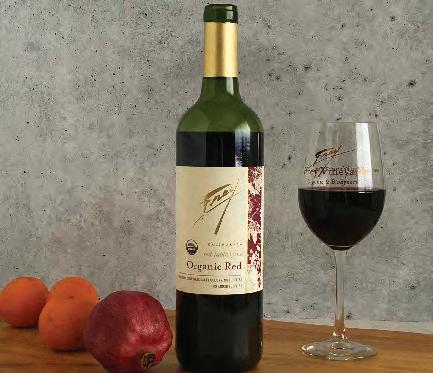
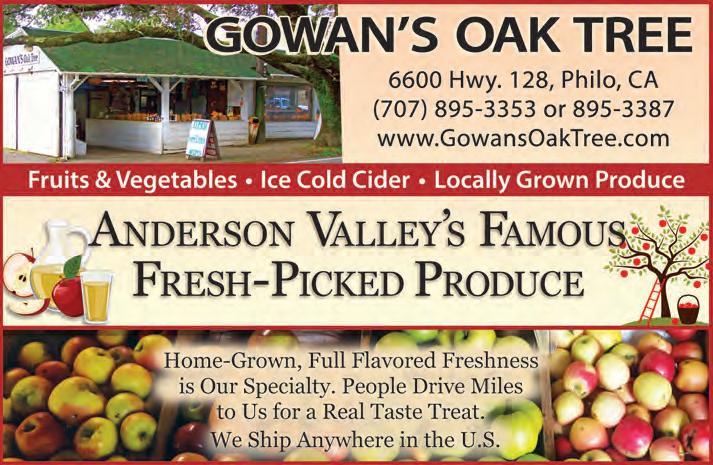
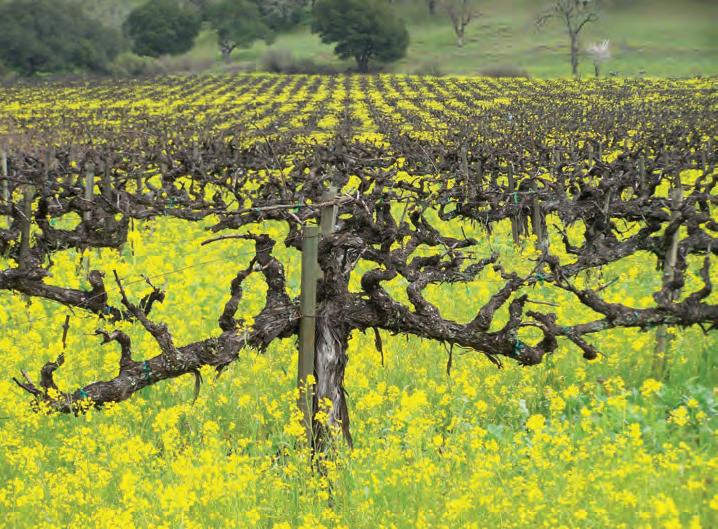
8B: Annapolis Winery
26055 Soda Springs Rd., Annapolis 707-886-5460 • AnnapolisWinery.com
5D: BARRA of Mendocino, CO 7051 N. State St., Redwood Valley 707-485-0322 • BarraOfMendocino.com
6C: Baxter Winery 8660 Hwy 128, Philo 707-895-3173 • BaxterWinery.com
7C: Bee Hunter Wines
14251 Hwy 128, Boonville 941-320-1678/707-357-0598 • BeeHunterWine.com
6C: Boonville Road Wines 8750 Philo School Rd., Philo 707-472-6993 • BoonvilleRoad.com
#X: Brashley Vineyards 7000 Hwy 128, Philo 707-510-7360 • BrashleyVineyards.com
7D: Brutocao Cellars 13500 S. Hwy 101, Hopland 707-744-1664 • BrutocaoCellars.com
7D: Campovida, CO, BD 13601 Old River Rd., Hopland 707-744-8797 • Campovida.com
7D: Cesar Toxqui Cellars
Tasting Room, 13440 S. Hwy 101 Hopland 707-744-1071 • Toxqui.com
6C: Domaine Anderson, CO, BD 9201 Hwy 128, Philo 707-895-3626 • DomaineAnderson.com
6C: Drew Family Cellars
Tasting: The Madrones, 9000 Hwy 128 707-895-9599 • DrewWines.com
7C: Foursight Wines 14475 Hwy 128, Boonville 707-895-2889 • FoursightWines.com
5D: Frey Vineyards, CO, BD 11700 West Rd., Redwood Valley 707-485-5177 • FreyWine.com
5D: Girasole Vineyards , CO 7051 N. State St., Redwood Valley (at Barra) 707-485-0322 • GirasoleVineyards.com
7D: Graziano Family of Wines 13275 S. Hwy 101 Suite 3, Hopland 707-744-8466
GrazianoFamilyOfWines.com
6C: Goldeneye Winery 9200 Hwy 128, Philo
707-895-3202 • GoldeneyeWinery.com
6B: Greenwood Ridge Vineyards
5501 Hwy 128, Philo
707-895-2002 • GreenwoodRidge.com
6B: Handley Cellars, CO 3151 Hwy 128, Philo 707-895-3876 • HandleyCellars.com
Tasting Varietals
Daily CS, G, PN, R, SB, Z
Daily C, CBSB, CS, Mu, PB, PN, PS, RD, Sa, Z
Thur-Mon C, Ca, N, PN, Sy
Daily C, CS, Gr, M, PN, R, Ri, S, SB, Sy
Thur-Sun or By Appt RS, Sy, CS, Ca, Gr
Call for Information SB, RO, PN
Daily Ba, C, CS, Do, M, P, PN, R, RD, Sa, SB, Sy, Z
Daily C, Mar, Gr, PN, Sy, Vi
Wed-Sun C, CF, CS, P, PG, PN, R, Z
Daily C, PN, R
Thur-Mon PN, Sy
Daily PN, S, SB
Daily C, Ca, CBSB, CRSB, CS, Do, G, M, Mal, P, PG, PN, PS, R, RB, Sa, SB, SpW, Sy, Vi, Z
Daily C, CBSB, CS, PB, PN, PS, Z
Daily Ba, Ca, ChB, Do, Mu, PB, PG, PN, PS, R, Sa, SB, SpW, Sy, WD, Z
Daily C, PN, SpW
Daily C, CS, CRSB, M, PN, Ri, RB, SB, SpW, Vi, WD, Sy, Z
Daily C, G, PG, PN, Ri, SB, SpW, Sy, Vi, Z
Grid location on Wine Map (pages 42-43)
Name of Winery
Certified Organic, Bio-Dynamic (see Varietal Key to right)
5D: Frey Vineyards, CO, BD 14000 Tomki Rd., Redwood Valley 707-485-5177 • FreyWine.com
Recommendations are listed in Bold Print
6B: Husch Vineyards 4400 Hwy 128, Philo 707-895-3216 • HuschVineyards.com
7D: Jaxon Keys 10400 S. Hwy 101, Hopland 877-462-6666 • JaxonKeys.com
7D: Jeriko Estate, CO, BD Hwy 101, one mile north of Hopland 707-744-1140
• JerikoEstate.com
6B: Lazy Creek Vineyards 4741 Hwy 128, Philo 707-895-3623 • LazyCreekVineyards.com
6C: Lichen Estate 11001 County Rd. 151, Boonville 707-895-7949
• LichenEstate.com
6C: Long Meadow Ranch
Tasting: The Madrones, 9000 Hwy 128 707-963-4555
• LongMeadowRanch.com
6B: Lula Cellars 2800 Guntley Rd., Philo 707-895-3737
• LulaCellars.com
7C: Maple Creek Winery 20799 Hwy 128, Yorkville 707-895-3001 • MapleCreekWine.com
5D: Mas´ut Winery 301 Reeves Canyon Rd., Redwood Valley 707-485-5466 • Mas´ ut.com
7D: McFadden Blue Quail Tasting Room, CO 13275 S. Hwy 101, Suite 5, Hopland 707-744-8463 • McFaddenVineyard.com
7D: McNab Ridge Winery
13450 S. Hwy 101, Hopland 707-744-1986 • McNabRidge.com
7C: Meyer Family Cellars
19750 Hwy 128, Yorkville 707-895-2341 • MeyerFamilyCellars.com
7D: Milano Family Winery
14594 S. Hwy 101, Hopland 707-744-1396 • MilanoWinery.com
6B: Navarro Vineyards
5601 Hwy 128, Philo 800-537-WINE • NavarroWine.com
6D: Nelson Family Vineyards
550 Nelson Ranch Rd., Ukiah 707-462-3755 • NelsonFamilyVineyards.com
Pacific Star Winery 33000 N. Hwy 1, Ft. Bragg 707-964-1155 • Pacificstarwinery.com
5D: Parducci Wine Cellars
501 Parducci Rd., Ukiah 888-362-9463 • Parducci.com
7C: Pennyroyal Farm
14930 Hwy 128, Boonville 707-895-2410 • PennyroyalFarm.com
6B: Phillips Hill Estates 5101 Hwy 128, Philo 707-895-2209 • PhillipsHill.com
Color indicates Appellation (See Key to right and on Wine Map, (page 42)
Tasting Varietals
Daily C, ChB, CS, G, Mu, PN, SB, Z
Daily C, CS, Gr, M, P, PN, PS, SB, Sy, Vi, Z
Daily C, CS, PN, Sa, SB, SpW, Sy
Thur-Sun G, PN, R
Daily PG, PN, SpW
Thur-Mon C, CS, M, PG, PN, SB
Daily G, PN, R, SB, Z
Daily C, CS, G, M, Mu, PN, Z
By Appt PN
Daily C, G, PG, PN, Ri, SB, SpW, Z
Daily C, CBSB, CS, G, M, P, PN, PS, R, RD, SB, Z
Daily C, CS, P, PS, R, SB, Sy
Daily C, Ca, CBSB, CS, M, Mal, P, PS, PV, RD, WD, Z
Daily C, CS, G, Mu, PB, PG, PN, PS, R, Ri, SB, Sy, WD, Z
Daily C, CS, Mu, PG, PN, Ri, Vi, Z
Thur-Mon Unusual and Rare Wines
Daily C, CS, M, Mu, P, PG, PN, PS, R, SB, Vi, Z
Daily C, PN, R, SB
Daily C, G, PN, Ri
List of Varietals
Produced (See Key to right)
Mon-Fri C, CS, G, M, PN, PS, R, Sa, SB, Sy, WZ, Z
When Tasting Room is Open
Winery
7C: Philo Ridge Vineyards 14125 Hwy 128, Boonville 707-895-3036 • PhiloRidge.com
6D: RIVINO Winery 4101 Cox-Schrader Rd., Ukiah 707-293-4262 • Rivino.com
6B: Roederer Estate 4501 Hwy 128, Philo 707-895-2288 • RoedererEstate.net
7D: Saracina 11684 S. Hwy 101, Hopland 707-670-0199 • Saracina.com
6C: Scharffenberger Cellars 8501 Hwy 128, Philo 707-895-2957 • ScharffenbergerCellars.com
7D: Seawolf Wines 33151 Hwy 128, Yorkville 707-494-0312 • SeawolfWines.com
7C: Seebass Family Wines 14077 Hwy 128, Boonville 707-4380-4949 • SeebassVineyards.com
5D: Silversmith Vineyards 8121 Vineyard Oaks, Redwood Valley 707-485-1196 • SilversmithVineyards.com
6D: Simaine Cellars 3001 S. State St., Ste 42, Ukiah 707-462-6300 • Simaine.com
6C: Smith Story Wines Tasting Room The Madrones, 9000 Hwy 128 Philo 707-494-5575, SmithStoryWineCellars.com
7D: Terra S ávia, CO 14160 Mountain House Rd., Hopland 707-744-1114 • TerraSavia.com
5D: Testa Vineyards 6400 N. State St., Calpella 707-485-7051 • TestaRanch.com
6C: Toulouse Vineyards & Winery 8001 Hwy 128, Philo 707-895-2828 • ToulouseVineyards.com
6C: Twomey Cellars 4741 Hwy 128, Philo 707-942-7099 • Twomey.com
2C: Vin de Tevis 51161 Covelo Rd., Dos Rios 707-983-8433 • VindeTevis.com
6C: Weatherborne Wine Corp 8750 Philo School Rd., Philo 707-684-5299 • Weatherborne.com
6C: Witching Stick 8627 Hwy 128, Philo 707-895-3454 • WitchingStickWines.com
7D: Yorkville Cellars 25701 Hwy 128, Yorkville 707-894-9177 • Yorkville-Cellars.com
7D: Yorkville Deli & Wine Tasting 26701 Hwy 128, Yorkville 707-894-9456
Tasting Varietals
Fri-Mon C, G, PG, PN, Vi, Z
Daily C, CBSB, CF, P, PB, R, Sa, Vi
Daily C, PN, SpW
Daily C, Gr, Mal, PN, R, SB, Vi, Z
Daily C, PN, SpW
Daily 10am-7pm SB, R, PN, Sy, Gr, CS, M, Z
Daily C, CRSB, M, R, Sy, Z
Daily CS, PS, Vi, Z
Daily Ca, M, Sa, SB, Sy, Z
By Appt C, CF, CS, M, PN, Ri, R, S, SB, Z
By Appt C, CBSB, CS, M, PN, PV, SpW
Daily CA, CBSB, Gr, R, SB, Z
Daily G, M, PG, PN, PS, R, Ri, SpW, Z
Fri-Mon SB, PN
By Appt Ca, CF, CS, M, Z
Fri-Sun or M-Thurs By Appt RO, PN, Gr, ChB
Thur-Mon C, G, PN, R, Sy, Z
Daily CBSB, CF, CS, M, Mal, PV, S, SB, SpW
Daily Multiple Wineries
CO Certified Organic
BD Bio-Dynamic
Ba Barbera
C Chardonnay
Ca Carignane
CBSB California Bordeaux Style Blend
CF Cabernet Franc
Cha Champagne
ChB Chenin Blanc
Ci Cinsault
CRSB California Rhone Style Blend
CS Cabernet Sauvignon
Do Dolcetto
G Gewurztraminer
Gr Grenache
M Merlot
Mal Malbec
Mar Marsanne
Mu Muscat
N Nebbiolo
P Port
PB...........Pinot Blanc
PG..........Pinot Gris-Grigio
PN Pinot Noir
PS Petite Sirah
PV Petite Verdot
R Rosé
RB Rhone Blend
RD Red Dessert Wine
Ri Riesling
S Semillon
Sa Sangiovese
SB Sauvignon-Fume Blanc
SpW Sparkling Wine
Sy Syrah-Shiraz
Vi Viognier
WD White Dessert Wine
WZ White Zinfandel
Z Zinfandel
Information is subject to change. Many wineries produce varietals and special blends not listed here. We strive to make these listings as accurate and up to date as possible. Please email any discrepancies or changes to info@101things.com
Anderson Valley
Mendocino Ridge
Yorkville Highlands
Mendocino
Redwood Valley
Eagle Peak
Dos Rios
Covelo
Potter Valley
McDowell Valley

MORE INFO: M EN d O c INO cOM/FE st I vals ht M l
• Fe bruary: Anderson Valley White Wine Festival, 707-895-WINE (9463), AVWines.com
• M arch: Bike Monkey’s Fish Rock Bike Race, 707-560-1122, BikeMonkey.net/fishrock
• A pril: S. V. Muzzleloaders Rendezvous, Yorkville, 707-479-0112, 707-664-0511
• M ay: Boonville Beer Festival, Anderson Valley Brewing Co., 707-895-2337, AVBC.com; Anderson Valley Pinot Noir Festival, 707-895-9463 (WINE), AVWines.com; Anderson Valley Wildflower Show, 707-895-2609, M endoCountyFair.com
• M ay-June: Rock Sober, Boonville, Mendocino County Fairgrounds
• J uly: Old Time 4th of July Celebration, Boonville (no fireworks)
• S eptember: Mendocino County Fair, Boonville, MendoCountyFair.com; California Wool and Fiber Festival, FiberFestival.com
• De cember: Holiday Passport Wine Weekend, Hwy 128 locations, 707-895-WINE (9463), AVWines.com
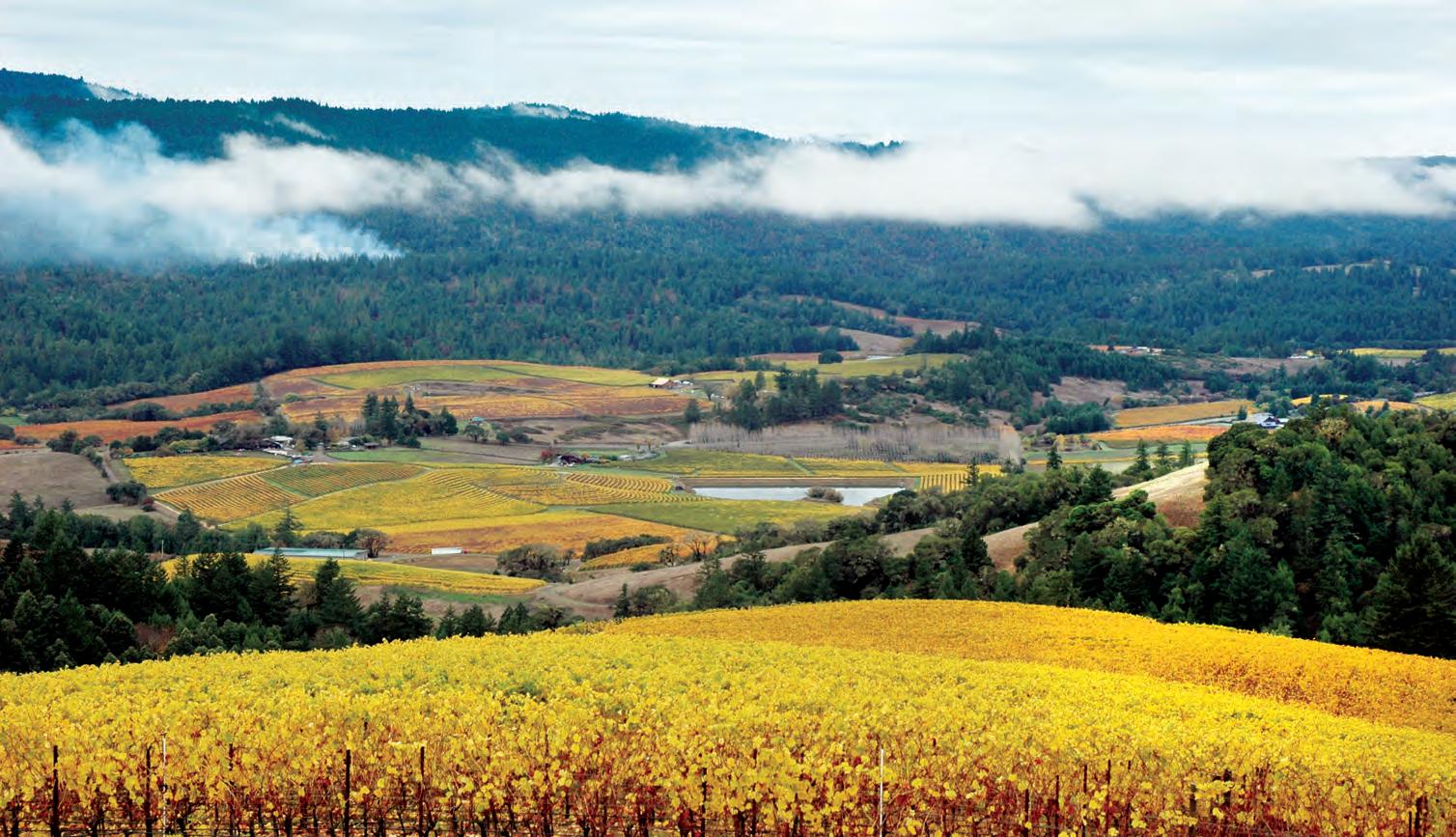



Anderson Valley, located between Cloverdale and the Mendocino Coast, stretches along Hwy 128. Yorkville marks its eastern end, Boonville and Philo are located in its center, and Navarro sits at its western terminus. The main highway is busiest on the weekends as tourists head to and from Mendocino Village and Fort Bragg on the North Coast. The valley is sparsely populated on mostly large parcels, with Boonville leading Anderson Valley in activity and population. The town holds another distinction: it has its own language, called Boontling. Widely used in Boonville during the late 19th and early 20th centuries, there are still about 100 people who speak it fluently. An example: “harp a slib of the ling” (speak a little Boontling).
The Anderson Valley is filled with rolling hills, shaded with oak and madrone trees, and home to apple orchards, vineyards and colorful wildflowers. Some 1,000 acres of wine grapes are produced in the area, and many local wineries with tasting rooms are found there, primarily along Hwy 128. According to Food & Wine magazine, “Anderson Valley may be one of the best places in the country to grow Pinot Noir.” AVWines.com
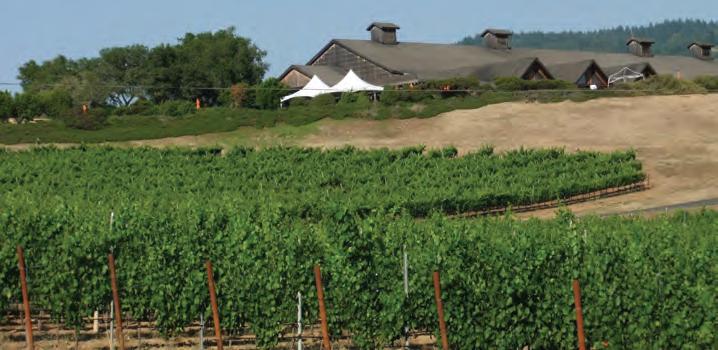
RoedererEstate.com
The Anderson Valley Wine region, best known for its production of rich Pinot Noirs and smooth, dry, Alsatian-style Gewürztraminers, is the home of beautiful scenery as well as superb wines. The region is full of family-owned wineries that produce small batches of excellent handcrafted wines showing off the characteristic qualities that have made Anderson Valley a famous growing region. In this area you can even find méthode champenoise sparkling wines that originated in the Champagne region of France.
The area has a wide variety of tasting room atmospheres that range from the rustic aura of a former chicken coop to an elegant, French-inspired experience. Wine, art and beautiful natural scenery blend seamlessly in this fascinating region of Mendocino County. There is an established driving route that takes you past all of the region’s many highlights. If you’re on a tight schedule, Hwy 128, which runs east of Elk, splits the region right down the middle. See our wine section starting on page 37 for more on all Mendocino County wineries.
MORE INFO: Visit Mendocino County, 866-GO-MENDO (466-3636) or 707-964-9010; VisitMendocino.com, AVWines.com
1 Roederer Estates
2 Gowan’s Oak Tree
3 Scharffenberger Cellars
4 Seawolf Wines
5 Domaine Anderson Winery
6 Anderson Valley Brewing
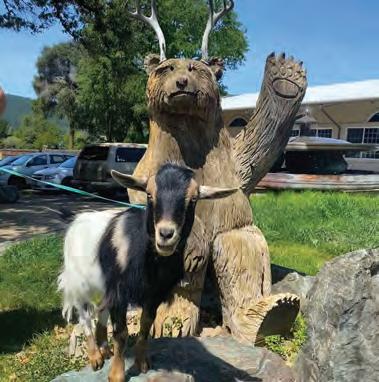
For over thirty years, Anderson Valley Brewing Company has been hand-crafting authentic craft beer in Northern California’s famed Anderson Valley region and is now transforming its Tap Room and brewery property into a Beer Park experience. The Beer Park spans almost 30 acres throughout its Boonville brewery property and redefines the concept of a beer garden. The Beer Park includes a 9,000 square foot “lounge lawn” with outdoor seating and picnic area along with an 18-hole disc golf course. Indoor seating is available in the renovated tap room along with 20 taps of everything from classic flagship beers to innovative and tap-room-only beer offerings including the highly allocated beers from AVBC’s sister brewery the Healdsburg Beer Company. Visitors are free to grab a beer and explore the property, play a round of disc golf or spend time in the tap room tasting through AVBC’s award winning line up of beers. There’s no fee for the disc golf course and the entire grounds and family and dog friendly. Check the events page on AVBC.com for the live music schedule, and check their Facebook page for updates on Farmers Market and food truck schedules.
WHERE: Off of Hwy 128, 17700 Boonville Ukiah Road.
MORE INFO: 707-895-2337, avbc.com



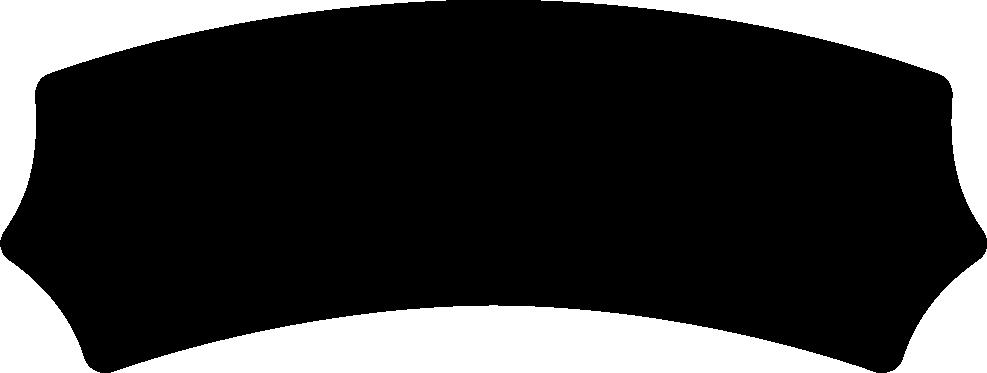
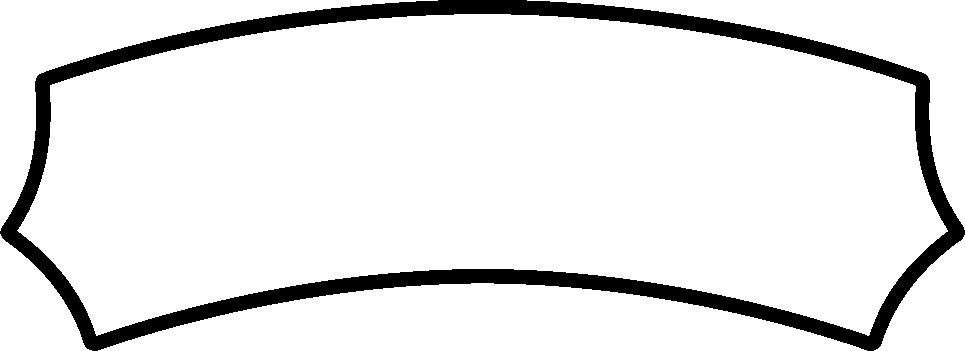



Nestled between the beautiful Alexander and Anderson Valleys near Yorkville, the Yorkville Highlands Appellation offers enchanting scenery and excellent wines. The area stretches nearly 16 miles on either side of Hwy 128, with approximately 40,000 acres of excellent wine grapes that range from Sauvignon Blanc and Semillon to Cabernet Sauvignon, Pinot Noir, Syrah and Merlot. Over 40 wines are made from grapes from the Yorkville Highlands region, known for the passion and quality of the growers and winemakers who call it home. The wineries are all family owned and managed. Most, if not all, of the wines are made in small lots. The highland scenery is well worth the trip. See the sights and taste the wines!
MORE INFO: YorkvilleHighlands.org, see winery section starting on page 43.

Intriguing artifacts from the area’s rich history await you at the Anderson Valley Historical Society’s museum. Located in a “little red schoolhouse” that was built in 1891, it is directly adjacent to Hwy 128 between Elk and Ukiah. Although the building is no longer used as a schoolhouse, as a museum it still teaches a great deal about the rich history of the Anderson Valley and Mendocino County. The museum showcases what life was like for those hardy pioneers who chose to settle here. Exhibits include a blacksmithing display, Pomo Indian baskets and basketmaking tools, historic timber equipment and fascinating photographs. Learn about “Boontling,” the whimsical local language once spoken widely throughout the valley. Bring your own lunch and enjoy an outdoor meal in the picnic area, sheltered in the shade of a redwood grove. The museum is open Saturdays and Sundays, 1 to 4 pm , from February through November.
WHERE: 12340 Hwy 128, Boonville, in the Con Creek “Little Red Schoolhouse.”
MORE INFO: 707-895-3207, AndersonValleyMuseum.org
For an awe-inspiring experience, come experience redwood trees more than a thousand years old in Hendy Woods State Park. Located in the middle of the fantastic Anderson Valley Wine District, the park is noted for two breathtaking groves: the Big Hendy, which is 80 acres and includes a self-guided discovery trail, and the Little Hendy, which covers about 20 acres. The park’s Upper Loop trail, which winds through the center of the Big Hendy, is a particularly beautiful route that leads through a towering cathedral of old-growth redwoods. A day use area near the Big Hendy offers gorgeous views and picnic sites. There are picnic sites throughout Hendy Woods with access to the Navarro River, which runs through the entire length of the park.


The Navarro River is a popular destination of its own. Fishing is not allowed in the park, but permitted in the Navarro River watershed downriver from the bridge at the park entrance. In the late winter and spring, kayaking and canoeing are very popular because the park is less foggy than other redwood parks along the coast. Bikers and horseback riders enjoy the trails that meander throughout it. In the summer, Hendy Woods State Park offers great swimming in the river for a respite from the heat of the summer sun. WHERE: Off Greenwood Road Scenic Byway outside of Elk.
MORE INFO: 1-800-444-7275, 707-895-3141 (seasonal), www.parks.ca.gov/?page_id=438
After following Hwy 128 through the Anderson Valley, just west of Navarro motorists will find themselves suddenly entering an 11-mile-long tunnel of redwood trees that takes them all the way to the ocean. Welcome to Navarro River Redwoods State Park. The park’s redwood groves are home to raccoons, black-tail deer and other wildlife, as well as belted kingfishers and other river-oriented birds. Visitors to the park can enjoy swimming, fishing, canoeing, kayaking and picnicking in and along the Navarro River. There are two campgrounds, although for the past four years the Paul M. Dimmick campground has been closed
The Navarro Beach campground remains open, however. There are 10 primitive campsites available there on a first-come, first-served basis. Beach wheelchairs can be reserved at least a week in advance.
WHERE: On Hwy 128, 2 miles east of the junction with Hwy 1.
MORE INFO: 707-882-2463, 707-937-5804, www.parks.ca.gov/?page_id=435
Please say you saw

Although only a few blocks long, the town of Hopland packs a lot into its short length. Its primary attraction, however, is a host of great winery tasting rooms, with more just outside of town.
Hopland’s focus is wine, boasting the area’s top-awarded wineries. It is home to 18 wineries, and there are eight tasting rooms in downtown Hopland alone, with more along Old River Road and Hwy 101. You can also sample organic olive oils and wildflower honey. Local wines can be paired with delicious food made from the freshest, local ingredients. Visitors can share tapas-sized small plates or tasty pizzas and farm-to-table salads, or for that matter sample Mexican food from a taco truck.
Some local hotspots will waive the corkage fees on any wine bottle purchased from a Hopland wine tasting room. Several Hopland area winery tasting rooms offer special complementary food and wine pairings. Wineries in the greater Hopland area hold two great gatherings for wine and food lovers each year, a spring and a fall Hopland Passport event.

TerraSavia.com
Mendocino County offers some of the finest olive oils available in California. This is partly due to its great olive-growing climate, with somewhat chilly winters and hot summers, but also because of the high concentration of small artisan producers here who grow olives on their own or in their vineyards. The region lends itself lends itself to growing well-known olive varieties like Mission, but also such popular Tuscan varieties as Frantoio, Leccino, Pendolino, Maurino and Coratina. There are three attributes of extra virgin olive oil that are considered “positive”: fruitiness, pungency and bitterness. The last two are acquired tastes, and most people in this country prefer olive oils that are less pungent and bitter. Good producers will try to achieve a palatable balance.
In addition to the olive varieties chosen at time of planting, Mother Nature’s kindness plays a big role in the outcome. Rain, drought and frost can affect the quantity and quality of oil produced.
Are you confused when buying extra virgin olive oil? That’s because there are so many factors to consider. Much like wines, olive varieties largely determine the flavor profile. Nevertheless, Spanish and Greek olives tend to produce oils that are fruitier than Tuscan olives, which are more pungent and slightly more bitter, in part because the Spanish and Greek olives tend to be allowed to ripen longer.
Air, light and heat can affect how long the oil lasts. Unopened good oils can last up to two years. However, once opened they should be consumed within a month, since air will begin to oxidize them. Keep several oils on hand for different purposes, but not so many that they will go rancid in your cupboard. It is important to store them in a cool dark place, but not the refrigerator.
To learn more, tour the county’s first certified organic olive mill located in Hopland, Terra Savia. The facility offers olive oil tastings and resources for growing olives and crafting premium olive oil.
WHERE: 14161 Mountain House Road, Hopland
MORE INFO: 707-744-1114, TerraSavia.com
3





Handcrafted
Ports
Gift
Open
14594
Hopland
MilanoWinery.com


BrutocaoCellars.com

JaxonKeys.com
When you pay a visit to the world-renowned wineries of the Hopland region, located in and around Hopland off Hwy 101, you will be treated to fantastic wines and delightful scenery. This region embodies everything that is the Mendocino wine experience. The Hopland wineries are famous for their awardwinning Rhone, Burgundy and Bordeaux varietals, and offer elegant tasting rooms presenting a variety of unique wine-tasting experiences. You’ll find live music, bocce courts, barrel tasting and organic gardens awaiting you in the distinct Hopland wine region. There are many different ways to experience the wineries and tasting rooms in Hopland. There is a convenient driving loop that you can enjoy at your own pace, and there is also a selection of more deluxe tours — something for every preference and price range. A trip to the Hopland Wine Region will leave you with delightful memories of picturesque hillsides and delicious wines.
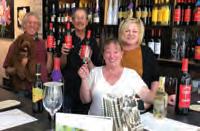


In 1997 Brutocao Cellars purchased the old Hopland High School from the Fetzer family and built a 7.5-acre complex dedicated to wine and food. The Schoolhouse Plaza is a prominent and historic (circa 1920) landmark travelers pass as they drive through Hopland on Hwy 101. There are a tasting room, gift shop and six regulation bocce courts on its premises. Take the time to participate in a spirited game of bocce ball (Italian lawn bowling), a Brutocao family tradition. The tasting room staff can explain the rules as well as provide you with award-winning handcrafted wines. Hopland Brutocao Cellars tasting room is open daily from 10 am to 5 pm
WHERE: 13500 S. Hwy 101, Hopland.
MORE INFO: 800-433-3689, 707-744-1664, BrutocaoCellars.com
Please say you saw it in 101 Things
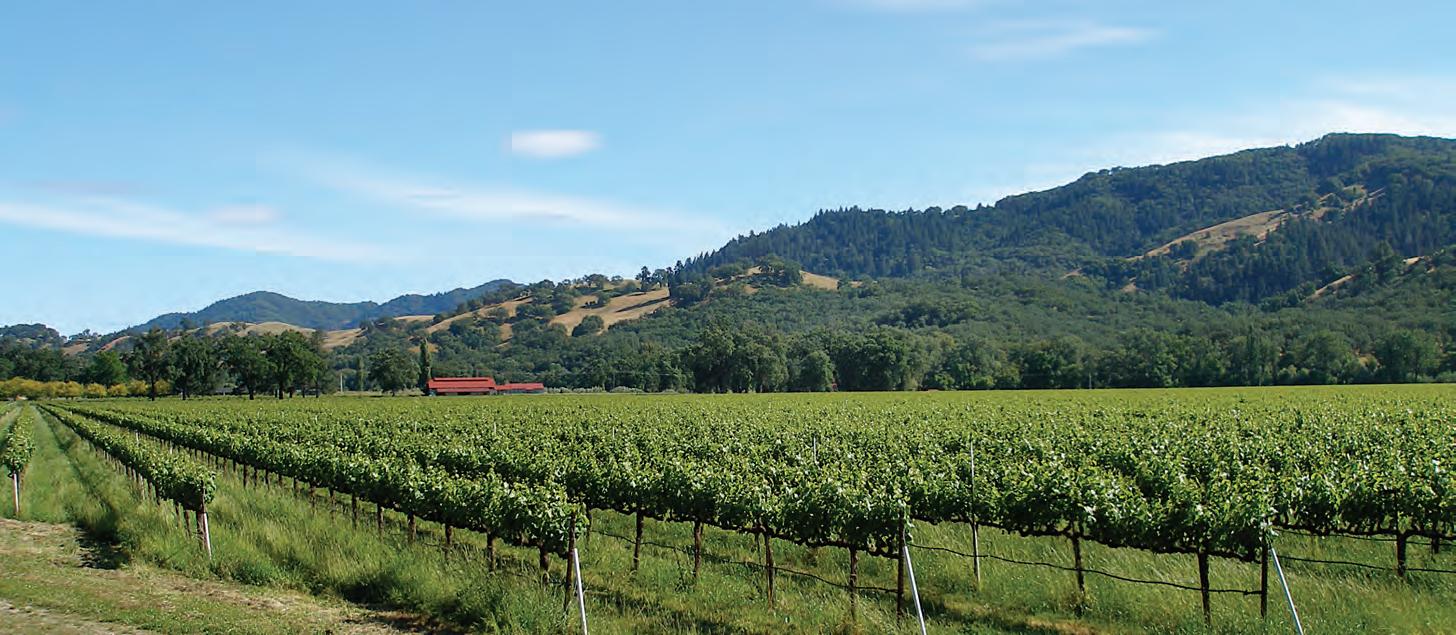
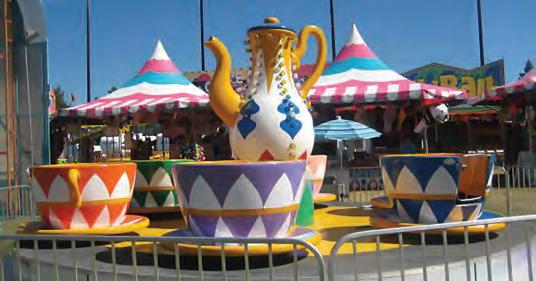
Ukiah is the Mendocino County seat and its largest city. First settled about 5,000 years ago, people of European descent began to arrive there around 1845. It took the arrival of the railroad in 1889, however, for Ukiah to begin to really grow. Now its population is approximately 16,000, while that of the greater Ukiah area numbers about 35,000. Framed in a deep mountain valley (its name is derived from the word “yokayo,” which means either “deep valley” or “south valley” in the native Pomo tribal language), Ukiah is a beautiful destination that combines a wealth of natural resources with an independent character. Off the beaten path, Ukiah’s unique setting, spirit and people inspire you to explore further.
For those seeking to escape urban angst and experience life in a more relaxed environment, Ukiah offers a getaway rich with activity, creativity and small town charm. With countless opportunities for outdoor recreation, good food and drink, year-round events and cultural attractions, Ukiah has something for everyone. And, unlike any city named anything else, its name spelled backwards is “haiku.”
For musical enjoyment, Ukiah offers Mendocino Ballet, Ukiah Civic Light Opera, Ukiah Community Concert Association, Ukiah Symphony and the Ukiah Players Theatre. Mendocino College Center Theater also has a 400-seat theater in its stateof-the-art performing arts facility. Parducci Wine Cellars and Rivino Winery offer live music in the summer.
There are city parks within Ukiah with playgrounds, picnic areas and other services. Todd Grove Park, located on Park Boulevard, features a public swimming pool, playground and picnic areas amid tall redwoods.
Lake Mendocino is 5 miles north of Ukiah on Hwy 20, east of Hwy 101. Visitors to the lake enjoy wake boarding, water skiing, jet skiing, camping and fishing for bass, bluegill, crappie and catfish. Nearby recreational areas include Low Gap Regional County Park, Mill Creek County Park, Cow Mountain Recreation Area and Montgomery Woods State Reserve.
Mendocino County is a wonderful grape-growing and wine-producing area. The county’s wine-growing areas can be divided into ten distinct regions, one of which is the Redwood Valley. Every June on Father’s Day weekend, A Taste of Redwood Valley brings wine, food, arts and crafts, and fun to the area. The region starts near the city of Calpella (north of Ukiah) and extends north between Potter Valley and the new Eagle Peak AVA. Here, many distinctive wines are crafted, from deep, rich reds such as Cabernet Sauvignon and Zinfadel to crisp Chardonnays and Sauvignon Blancs. Organic vineyards are maintained throughout the area and produce unique, flavorful wine grapes. Small wineries produce their own specialty wines that you will enjoy sampling and tasting at the many different tasting rooms throughout the region. See our wine section starting on page 37, which includes Frey Vineyards, Rivino Estate and Barra of Mendocino in the Redwood Valley and Ukiah area.
MORE INFO: Mendocino County Visitors Center, 866-466-3636, VisitMendocino.com; MendoWine.com, 707-901-7629
VichySprings.com
• Year-Round: First Friday Art Walk, Downtown Ukiah, ArtWalkUkiah.org; Ukiah Farmers’ Market, Saturdays 9am-noon, MCFarm.org; Live music at Rivino Vineyards, Rivino.com, usually on Friday or Saturday night
• Various Dates: Ukiah Symphony, 707-510-1793, UkiahSymphony.org
• January: Mendocino Crab Feast; Lantern Festival for Chinese New Year in Alex Thomas Plaza
• M ay: Potter Valley Rodeo, PotterValleyRodeo.com; Pastels on the Plaza, 707-467-1855
• J une-August: Sundays in the Park Free Concert Series, Todd Grove Park; Moonlight Movie Madness at Alex Thomas Plaza; also First Friday Art Party
• J une: Gourmet Escape (Taste of Downtown and Blues and Brews)
• J uly-September: Nelson Family Vineyards offers music during the summer, NelsonFamilyVineyards.com/events/
• A ugust: Redwood Empire Fair, RedwoodEmpireFair.com
• S eptember: Car Show
• October: PumpkinFest
• November: Mushroom Fest (all over the county)
• December: Hometown Holiday parade of lights, ice skating rink, holiday trolley

69
Mendocino County boasts some of the best natural hot springs in the world. Particularly notable are the carbonated hot springs at Vichy Springs Mineral Hot Springs Resort and Country Inn, a unique 164-year-old historic hot springs resort only two hours north of downtown San Francisco. It has the only naturally warm and carbonated “Vichy” mineral baths in North America. Its soothing 90-degree sparkling waters have drawn famous names throughout the decades. Mark Twain, Jack London, Robert Louis Stevenson, Teddy Roosevelt and Ulysses S. Grant have all enjoyed the relaxing, therapeutic and healing properties of its unique “Vichy” waters.
Vichy Hot Springs is the best of two worlds, a country inn and a hot springs resort open every day for day use or overnight stays. Included with overnight rooms and cottages are breakfast in the morning, full use of the naturally carbonated mineral baths and hot soaking pool at any time, Olympic size pool in season, and 700 acres of hiking trails. Day use is available every day from 8 am until 8 pm and includes the naturally carbonated mineral baths, hot soaking pool, Olympic size swimming pool and the property, just as if one were staying the night. Massage therapy, facials and hot stone massage are also available from 8 am to 8 pm for both overnight and day use guests. WHERE: 2605 Vichy Springs Rd., Ukiah
MORE INFO: 707-462-9515, VichySprings.com
2023 marks the 33nd season of Ukiah’s “Sundays In The Park” free concert series. Presenting performances by artists from a range of diverse genres, each of the summer’s six free concerts draws an average of over 3,000 music fans to beautiful Todd Grove Park. These shows feature artists from around the world and just down the road.
Highlights of past concert series included performances by Marcia Ball, McKenna Faith and Blues Hall of Fame veteran guitarist Elvin Bishop. Check the city of Ukiah’s website for this year’s lineup.
Pack a picnic, or indulge yourself with great food from vendors offering everything from barbecue tri-tip to sushi. Bring a blanket and gather with family, friends and neighbors to enjoy top notch performers while being part of the greater Ukiah community. Pets and smoking are prohibited within the main event area. Bring low-back chairs only, and personal BBQs are only allowed at the picnic table areas. Concerts begin at 6 pm

MORE INFO: 707-463-6231, CityOfUkiah.com/sundays-in-the-park

120 West Standley Street, Ukiah 707.463.6933
www.shoeflyandsox.com find us on facebook



A gate of three arches located welcomes visitors to the City of 10,000 Buddhas. In the 1930s, this complex served as a state hospital and featured over seventy large buildings including three gymnasiums, a swimming pool, fire station, and incinerator with underground connections for electricity, water, and even air-conditioning. A severe drought in the 1970s forced a closure of the facility when all efforts to drill a well failed to find any water. After purchasing the facility, the Venerable Master Hua directed an effort to dig down more than 100 feet, and water was finally discovered. An elementary, secondary school and the Dharma Realm Buddhist University are now housed within the City. The Administration Building registers and welcomes visitors, and features an exhibition room, museum, and book and gift shops. Of all the treasures of the City, the most memorable is the Jewelled Hall of Ten Thousand Buddhas, which is where the assemblies of disciples gather to attend daily ceremonies. Although the hall was once an indoor basketball court, it now features a massive wooden Buddha with a thousand hands, and the walls are covered in compartments. These alcoves house 10,000 Buddhas, all created by Venerable Master Hua himself. Day visitors can enjoy the campus every day from 8 am to 6 pm; the restaurant from 11:30 am to 3:30 pm every day except Tuesday; and the gift shop and bookstore on Monday, Thursday and Friday from 1-5 pm
WHERE: 2001 Talmage Rd., Ukiah
MORE INFO: 707-462-0939, cttbusa. org/, cttbusa.org/visit_cttb/cttb.asp



Corner Gallery/Art Center Ukiah opened in March 2008. Renovating a historic building just one block from the county courthouse, 24 local inland Mendocino County artists realized the dream of having a place to showcase their art. Featured theme shows, lectures and educational events for artists from childhood to the adult professional are supported by the Art Center Ukiah community gallery.
The active Corner Gallery membership rotates its art frequently, and special guest artists are featured monthly. Visitors will find a refreshing selection of paintings in a variety of media and styles, ceramics, photography, fiber arts, wood crafts, jewelry, gifts and cards. Corner Gallery/Art Center Ukiah has evolved as the hub of the monthly First Friday Art Walk, an event of music, refreshments, artists and art. Local galleries and selected businesses are open till 8 pm . Writers Read is the literary companion to Art Walk, poetry readings hosted by the Art Center Ukiah every last Thursday evening.
The gallery is open Tuesday to Saturday 11am to 5 pm and until 8 pm on the First Friday of each month.
WHERE: 201 S. State St., Ukiah
MORE INFO: 707-462-1400, CornerGalleryUkiah.com for detailed event information.

www.vichysprings.com
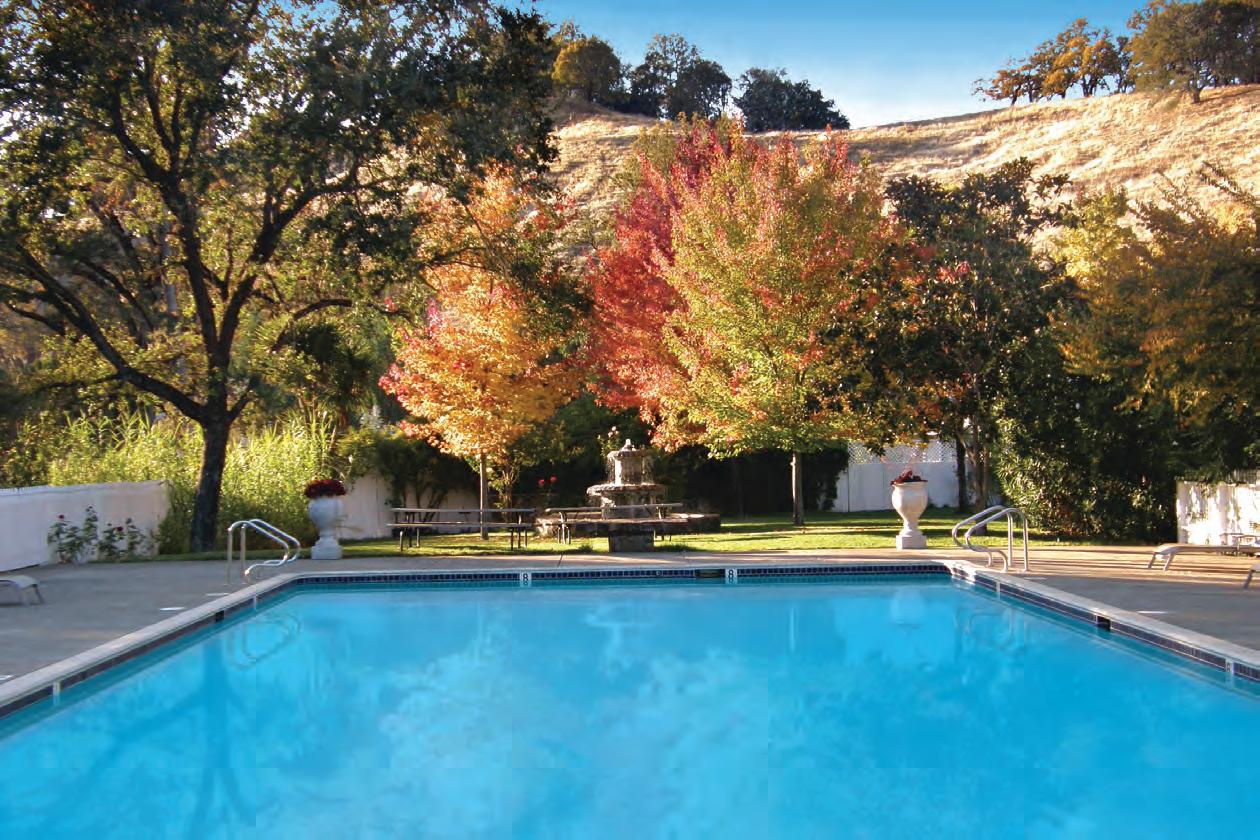

See why Jack London, Mark Twain, Ulysses S. Grant, Teddy Roosevelt, Robert Louis Stevenson and many other distinguished guests fell in love with this resort.

Welcoming visitors and world-wide travelers since 1854
18 well-appointed rooms and 8 private cottages available for overnight stays
700 acre private reserve for walking, hiking and rejuvenation

California Historic Landmark No. 980 North America’s only warm, naturally carbonated “Vichy” baths, famous worldwide Mineral hot pool and 25-meter (80’) pool


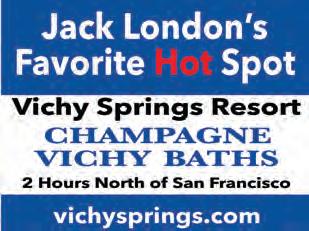
Indulge in first class spa treatments
Massage, Facials, Hot Stone Massage and Reflexology Treatments
No reservation needed for day use



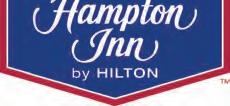

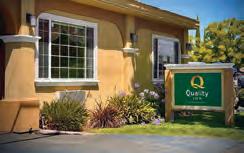
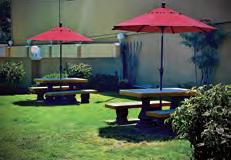
The Grace Hudson Museum features the best of the region’s art, history and anthropology. Exhibits in the museum range in subject matter from Native American culture and Northern California coast history to the works of contemporary artists. The primary focus of the museum is the work of Grace Carpenter Hudson, noted for her brilliant oil paintings of the Pomo Indians. The museum features over 30,000 related objects, including historical photographs and Pomo Indian artifacts. The building sits on a beautiful four-acre park with shaded picnic areas and a basket garden that grows all of the materials that the Pomo Indians used for their basket making. Also located on the grounds is Sun House, the former Hudson residence. It was originally designed by Grace Hudson and her husband, and is still furnished with their unique collection of furnishings and décor. Docent-led tours of the Sun House are held Wednesday to Sunday, noon to 3 pm , and depart from the museum. Admission fees are nominal, and entry is free on the first Friday of every month. There is also a delightful gift shop open during museum hours, Wednesday through Saturday 10a m to 4:30 pm and Sunday noon to 4:30 pm Closed Mondays, Tuesdays and major holidays.




WHERE: 431 S. Main St., Ukiah
MORE INFO: 707-467-2836, GraceHudsonMuseum.org







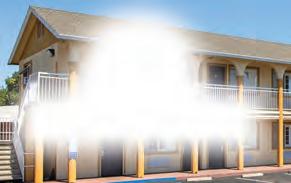



Ukiah Speedway is a 1⁄4 -mile asphalt oval racetrack offering pulsepounding excitement and high-velocity family fun. Come out and see bombers, modifieds, extreme asphalt outlaws, jammers, mini-stocks and more in action.
Typically a night of racing begins with a Trophy Dash, with the four to six fastest qualifiers in each division racing four to 6 laps and the winner receiving a trophy. The second set of races are the Heat Races; the field is divided into 2 or 3 groups that race between six and ten laps depending on division, earning money and points and allowing drivers to feel out how their cars are handling prior to the Main Event. As in the other races, cars in the Main Event run an inverted start, with the fastest cars in the back. This is the feature race, and it begins with qualifying semi-main events. The top four from those go on to the Main Event, where most of the points are earned and the largest part of the night’s purse is won.
Come visit Ukiah Speedway on the 4th of July and enjoy a fireworks show, too!
WHERE: 1055 N. State St., Ukiah
MORE INFO: 707-279-9577, UkiahSpeedway.com and on Facebook

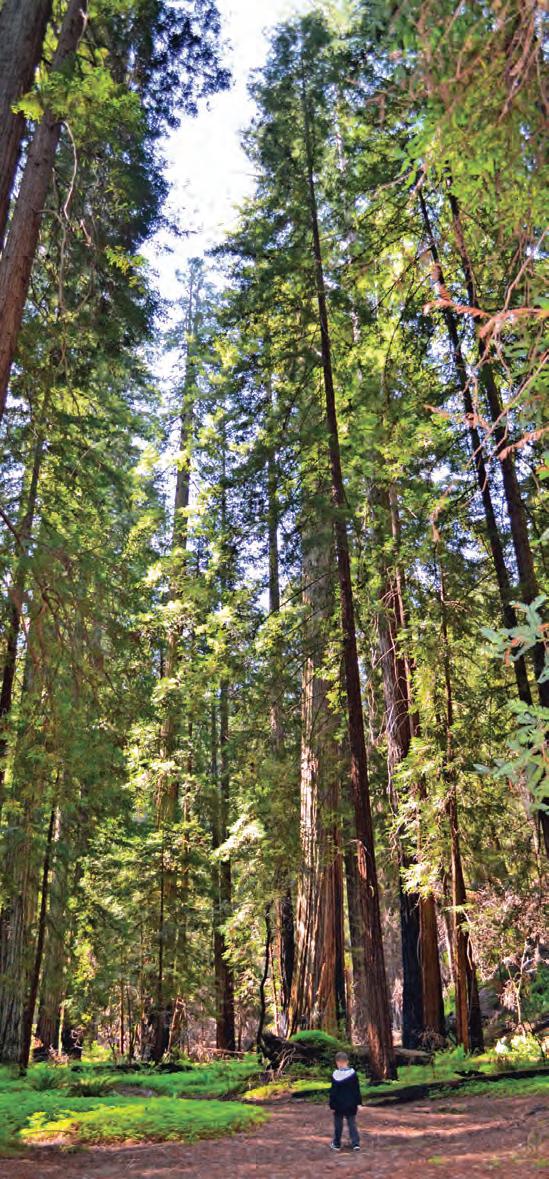
Set amid the scenic rolling hills of Coyote Valley, Lake Mendocino was formed in 1958 by the construction of the Coyote Valley Dam on the Russian River. Groves of oak mixed with manzanita and pine trees forest the area, offering intermittent shade and premium bird and wildlife habitat. The 1,900+ acre lake and its environs offer a wide variety of recreational opportunities including boating, swimming, water-skiing, fishing, hiking, camping and horseback riding. Anglers will find sunfish, largemouth and smallmouth bass, striped bass, crappie, white and channel catfish, bluegill, and perch.
Several miles of trails wind around Lake Mendocino. The Lake Mendocino Disc Golf Course offers 18 holes between its north and south courses. There are playgrounds for children at the Bushay and Chekaka campgrounds, and a horse staging area is located near the Kaweyo Trailhead.
WHERE: 8 miles northeast of Ukiah off Hwy 101 on Hwy 20 (Bushay) or 5 miles northeast of Ukiah off North State Street on Lake Mendocino Drive (Chekaka).
MORE INFO: 707-462-7581, 707-467-4200, Mendocino.com/?id=2431
Probably the most remote of California’s 31 redwood parks, this jewel of a natural reserve is a beautiful fern forest that is home to five separate redwood groves that have never been logged. You can access them by walking along a 2-mile loop trail that follows Montgomery Creek. The really dramatic old-growth scenery begins about one third of a mile into the park.
The tallest known tree in the world from 1996 to 2000 grew in Montgomery Woods. Called the Mendocino, it has since been edged out by more recently discovered trees in Humboldt and Del Norte Counties, but remains in the top 10 of the world’s tallest known trees. Another redwood, the largest (by mass) known in Montgomery Woods, the Montgomery Giant, is one of the 20 tallest known trees in the world. Altogether there are 18 trees in Montgomery Woods that are more than 350 ft. in height.
One of the less well-known attractions of Montgomery Woods State Natural Reserve is its fern forest, a large expanse of 4- to 5-foot-tall giant chain ferns that grow along the Montgomery Woods trail.
Montgomery Woods State Natural Reserve is off the beaten track, but once you get there you will experience one of the world’s true natural wonders. Parts of the reserve are somewhat marshy, so it’s not a bad idea to bring along mosquito repellent if you’re visiting during the summer. The park is open for day use only, and there is no fee.
WHERE: Located about 13 miles west of Ukiah on Orr Springs Road. Allow 30 to 45 minutes for the drive along this picturesque but steep, winding road.
MORE INFO: 707-937-5804, parks.ca.gov/?page_id=434
Mendocino County has a diverse and abundant selection of game, with quail, wild turkey, elk, bear, pig and blacktail deer among other species. The County also offers sportsmen many different choices when it comes to where to hunt. There is public land available for hunting, and most of it holds trophy-class game. There are also opportunities to hunt on private land for a fee.
For local information and to pick up supplies, there are many outdoor stores and suppliers in the Ukiah area. Stock up on boots, bows, guns, tents and any other equipment you might need, and ask the employees to share their favorite local spots. Unless specifically prohibited, public lands managed by the BLM are open to hunting, fishing and recreational shooting, including target shooting for license-holders.
WHERE: In parts of the Black Butte River watershed near Covelo, Jackson State Forest, Cow Mountain Recreation Area, Mendocino National Forest, Red Mountain Recreational Area, other areas of public land and various private lands.
MORE INFO: Pacific Outfitters, 955 N. State St., Ukiah, 707-468-6474, PacificOutfitters.com, G I Joes Outdoor Store, 976 N. State Street, 707-468-8834, GIJoesweb.com. Tractor Supply Co., 1248 Airport Blvd., 707-462-3748, tractorsupply.com
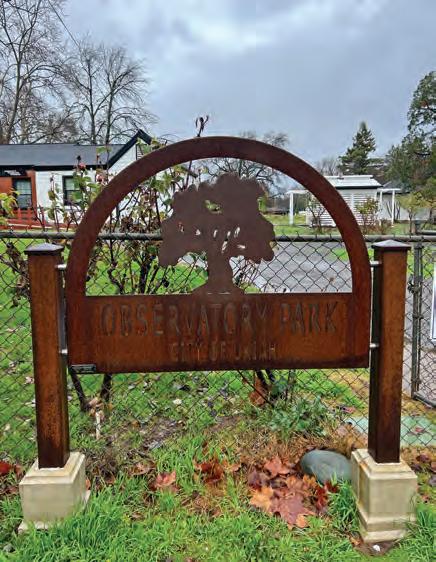
The international latitude observatories were a system of six locations near the parallel of 39° north latitude. They were used to measure the variation in latitude that occurs as a result of the wobble of the earth and its polar axis before the use of satellite technology became a more effective tool for observation.
There are two international latitude observatories in the United States the one located in Ukiah and another in Gaithersburg Maryland. Although the system is not widely used anymore, it represents a distinctive point in scientific history and innovation.
The park features a planet walk, a scale model of the solar system that fits within the boundaries of the walking path inside the park. There is also a restored labyrinth, the original observatory structure, and a newly-relaunched Interpretive Center.
The city hosts several exciting and educational events at the park. The tours of earth and sky lecture series are held at the Ukiah Civic Center and feature guest speakers talking about astronomy and natural sciences. There are also docent tours of the observatory in Park they can be scheduled by appointment. The park also welcomes amateur astronomers to bring their telescopes for open skies nights when they can share knowledge and observations.
MORE INFO: www.facebook.com/UkiahLatitudeObservatory,
Low Gap Regional Park is a multi-use public park covering more than 80 acres. It is situated along Orr Creek, an important tributary of the Russian River and one of three major streams that run through the city of Ukiah. Because access to all of these streams is extremely limited, access to Orr Creek is one of the most noteworthy features of this park, along with its extensive recreational development.
The upper reaches of Low Gap Regional Park serve as a woodland preserve. Here you will find nature trails that allow you to explore and enjoy the beauty of the area in its natural state. One of the trails will take you past a vernal pool (a small seasonal wetland). You may observe the pool from the trail, but please stay out of it; it is a very fragile and special environment.
The developed part of the park includes tennis courts, playgrounds, an archery range, horseshoe pits, a disc golf course, a covered picnic area, and an amphitheater for small concerts, plays and other performances. There is also a one-acre community dog park, a fenced area designated for off-leash use by residents and visitors and their dogs. It offers shade, benches, water and disposal facilities for dog waste, and allows well-mannered canine citizens to exercise and play in a clean and safe environment without endangering or annoying people, property or wildlife.
WHERE: In the hills west of Ukiah, just across Low Gap Road from Ukiah High School.
MORE INFO: https://tinyurl.com/y9dy3q57
1 Shoefly and Sox
2 Left Coast Seafood
3 • Corner Gallery
• Art Center Ukiah
4 Ukiah Visitor Center & Chamber of Commerce
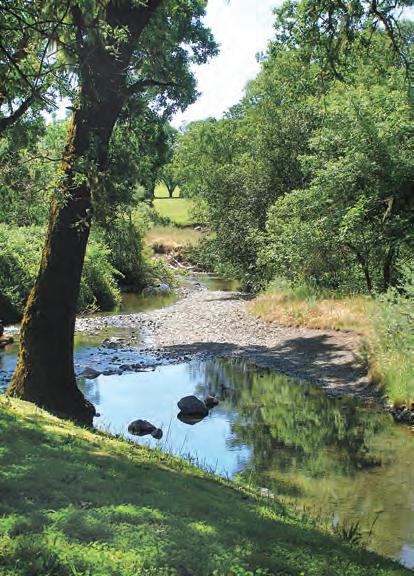

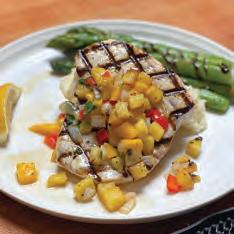

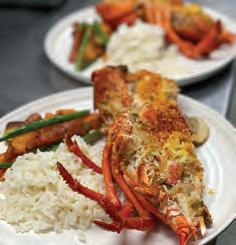



Since 1931 the Ukiah Valley Golf Course has provided countless rounds of golf and numerous tournaments set amid the majestic hills and sloping terrain of Mendocino County. Ukiah is a regulation 18-hole municipal golf course with an “open to the public” policy. It also offers annual memberships, tournaments and instruction.
From the back tees it offers 5,850 yards of golf at a par 70. With many trees and criss-crossed by sparkling streams, this is a gem of a course. Its signature hole is the 192yard, par three, third hole. This challenging tee shot dares you to hit the green, despite the bunkers that provide heavy protection and a gully on the right side of the fairway. This is a wonderful golf course that will not disappoint.
WHERE: 599 Park Blvd., Ukiah, (about a mile from the center of town).
MORE INFO: 707-467-2832, UkiahGolf.com
Comprised of 52,000-acres of rugged terrain with steep, chaparral-covered slopes and scattered stands of fir, pine and oak, Cow Mountain Recreation Area offers recreational opportunities as diverse as off-roading, hunting, camping and horseback riding. Elevations vary from 800 to 4,000 ft., affording spectacular views of Ukiah and Clear Lake. Cow Mountain, named for the wild longhorn cattle that once roamed there, is premium wildlife habitat, with over 30 miles of streams and 13 wildlife reservoirs. Upland species that inhabit the area include blacktail deer, black bear and wild turkey. Because Cow Mountain offers so many different types of recreational opportunities, it is divided into three management sections:
South Cow Mountain OHV Recreation Area emphasizes off-highway vehicle use. Over 90 miles of vehicle trails cross 23,000 acres, and offer challenges to motorcycle, ATV, and four-wheel drive enthusiasts. There are two developed campgrounds and two OHV staging areas. During the rainy season call ahead regarding closures. North Cow Mountain Recreation Area is managed primarily for such non-motorized activities as hunting, hiking, camping, horseback riding and mountain bicycling. There is one developed campground, a rifle range and a 17-mile network of hiking trails. Sheldon Creek Recreation Site is a smaller, detached area offering primitive recreational opportunities. It has a small campground. As in other sections of Cow Mountain, campsites are available on a first-come, first-served basis. There are no fees and no running water, but there are portable restrooms.
WHERE: Sheldon Creek is located near Hopland. North and South Cow Mountain are closer to Ukiah, and are accessed off Talmage Road from Hwy 101 South. There are several entrances. The access roads going into all of these areas are narrow and winding, and travel trailers and large RVs are not recommended. Check with the local BLM field office for conditions and road closings.
MORE INFO: BLM field office, 707-468-4000; BLM.gov/visit/cow-mountain
The Ukiah Valley Conference Center is a great place for planning and hosting an upcoming event. The Center is a state-of-the-art meeting facility, offering a variety of spaces able to accommodate groups as small as five or as large as 600 people. Located in beautiful downtown Ukiah, this modern center has every amenity to make your next social or professional gathering a success. There is an on-site kitchen. The Center is conveniently located within walking distance of restaurants and specialty shops for dining and shopping needs. There are also several shops located directly on the premises, including a specialty marketplace for local foods, gifts baskets, unique gifts, garden accessories and a coffee bar. Adjacent to the center is the Alex R. Thomas Jr. Plaza, great for hosting outdoor ceremonies and special events.
The Event Coordinator can arrange planning and set-up for events from small meetings to large banquets. The Conference Center staff is trained to assist event needs from start to finish, at any level. This Conference Center can provide audio visual equipment, pull-down and freestanding projection screens, video and slide projectors, as well as tabletop or freestanding 40-watt amplified podiums. This equipment can be provided free of charge — just notify the Center of your special needs in advance. The Ukiah Visitor Center is also located in the building and features Ukiah and surrounding area information, plus up-to-date event information.
WHERE: 200 S. School St., Ukiah.
MORE INFO: 707-463-6700, CityOfUkiah.com/uvcc; 707-467-5766, VisitUkiah.com (click on Groups & Meetings)
A 1929 Railroad Depot, Colonial Revival style.
B The Sun House; 1911, Arts Craftsman style, National Register. Listing, State Landmark.
C Carnegie Library, Prairie School style, 1914.
D Ukiah Civic Center, Mission Revival style, originally in 1922 as the town’s grammar school.
E C. Hofman home, National Registry, Eastlake style, 1889.
F Old City Hall, 1913-1987, corner Church and School Sts.
G Masonic Lodge, Classic style with cut brick facade, 1924, corner of Perkins & School Sts.
H Ukiah Republican Press Building, Revival-Renaissance style, 1928, glazed terra cotta tiles.
I Courthouse Annex Beaux-Arts style, 1928 with Indian limestone added to original 1872 courthouse.
J 100 block of Standley St.; first commercially developed area during 1859-1883 era.
K Palace Hotel, National Registry, corner Smith and N. State Sts., First built in 1891, a mixture of styles.
L Lamb’s Inn, Four Square style, built in 1915 as a quality boarding house; now offices.
M Gillespie Building, a commercial block from 239-255 N. State St., built after the 1890 fire.
N Oddfellows Lodge, Italianate style, 1882.
O White Building, 1906, the only structure in Ukiah that was significantly damaged by the 1906 earthquake; 111-115 N. State St.
P The block was developed by the Mark’s family, originally with four buildings, Laura Scudder (of potato chip fame) ran a café in this block called Little Davenport, 100 block of W. Perkins St.
Q Mendocino County Public Library, the site of the first white settlers’ cabin in Ukiah, 1850.
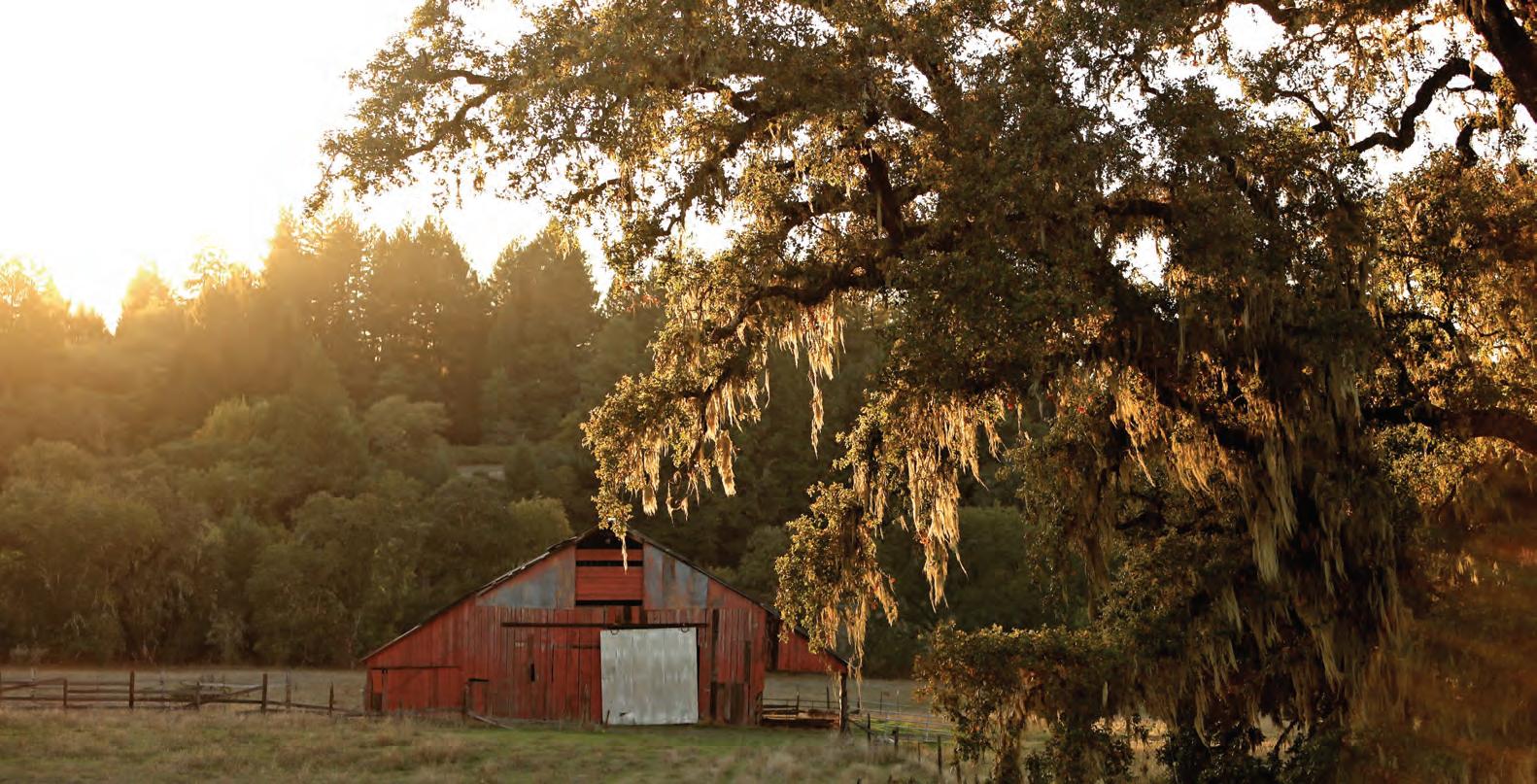
Willits, the third largest town in Mendocino County, is located on Hwy 101 approximately 22 miles north of Ukiah. Willits calls itself “Heart of Mendocino County — Gateway to the Redwoods,” and was incorporated in 1888. In 1911, tracks were extended from the California Western Railway’s Skunk Train to reach Willits. The former logging train connected Willits with Fort Bragg on the Mendocino coast until a collapse in the last decade, and is a favorite attraction for visitors to the area. Willits features excellent retail stores, restaurants, lodging, business and service establishments. Most of the businesses line Main Street, but a few can be found on quiet side streets. The town itself is set amid the beautiful rolling hills and forests of central Mendocino County.

Located in Northern California’s “Gateway to the Redwoods,” the Mendocino Redwoods RV Resort features an Old West theme and is laid out in a peaceful country setting with rolling hills and trees. It has something for everyone, including a swimming pool, fishing pond (freshly stocked and ready for summer), petting zoo, mini golf, the Rootin’ Tootin’ play tower, disc golf course, water spray park, sand volleyball court, two outdoor playgrounds, an arcade, and hiking trails. Their national awardwinning summer recreation program includes ice cream socials, Karaoke, and live entertainment.
Surprised by an unexpected rain shower? Not a problem. The resort also offers an arcade and time to catch your breath at the Zen Garden after trying to keep up with your kids. Ready to relax and watch a movie under the stars? There’s guaranteed to be an activity the whole family will enjoy.
Mendocino Redwoods RV Resort offers overnight camping in their spacious RV sites, shaded tent sites, and cozy cabins, which are also available for day-use fun. For your family reunion, office party, school field trip or a birthday bash for someone special, this is the perfect place to go.
Mendocino Redwoods RV Resort is open all year and pets are welcome. WHERE: 1600 Hwy 20, Willits
MORE INFO: 707-459-6179, mendocinoredwoods.com



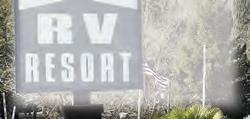



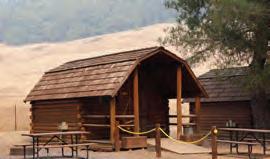






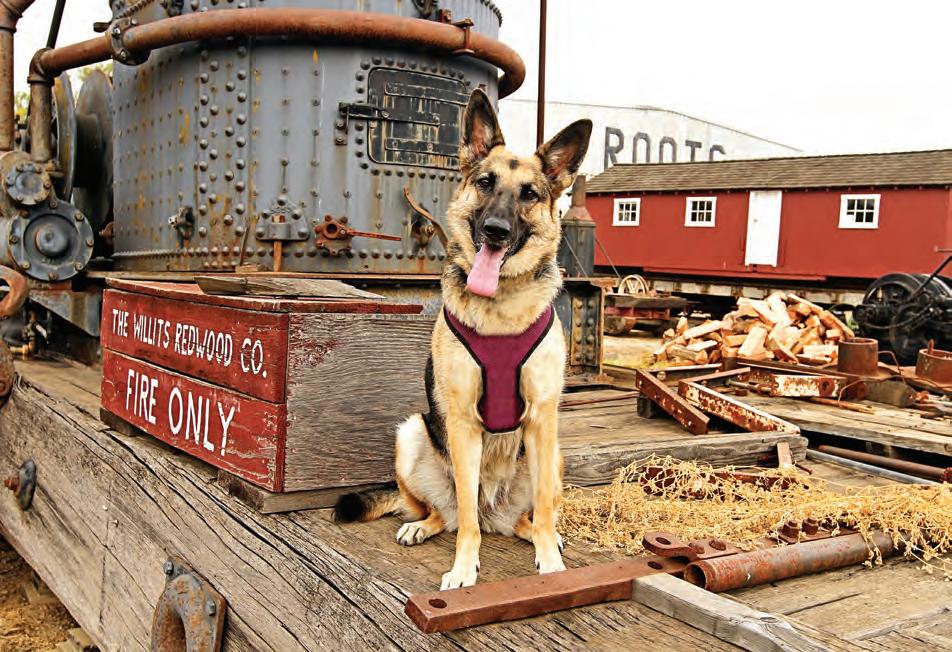
The Willits Skate Park was the first skate park in Mendocino County. What began when organizers approached the Willits City Council in 2000 finally became a reality at its grand opening in June, 2005. The council initially declined to function as lead agency, so consequently the Willits Skate Park Association, an adult volunteer service group, formed. It raised money, mobilized people, and got the ball rolling. The vast community effort that ensued was truly a testament to what can be accomplished when enough people follow through on a big idea.
The finished product was an 18,500-square foot cement skate park, one of Northern California’s premier skate destinations. In the end, over 6,000 man-hours of volunteered time and roughly $800,000 in grants and donated funds helped to make it possible.
Go to skate or just to check out the action. The park welcomes anyone on a skateboard, roller skates or rollerblades. Please note that helmets, elbow pads and knee pads are a must, and drugs and alcohol are strictly forbidden, as are fighting and other violent behavior, weapons and tobacco use. The park is open from 8 am to 5 pm during Pacific Standard Time; summer hours are 8 am to 7pm Pacific Daylight Time. It is closed during inclement weather.
WHERE: From South Main Street turn east onto East Commercial Street. The park is about half a mile down on the left-hand side (north side) of the street.
MORE INFO: 707-459-4605, WillitsSkatePark.com

Take a trip back in time at Roots of Motive Power, and learn about steam engines and the roots of the logging industry in northwestern California. California’s history was built on the backs of these rolling marvels, and at Roots of Motive Power the past comes alive with physical history. Standing next to these locomotives is like standing near huge, metal, fire-eating and steam-breathing giants.
Roots is an all-volunteer organization founded in 1982 to preserve and restore steam and diesel powered equipment used in the California north coast logging industry from the 1850s to the present. Anyone interested in helping out is encouraged to become a member and lend a hand on scheduled workdays, which generally take place the first and third Sundays of each month. The organization also holds classes, such as Steam Engineer and Railroad Safety classes, and sponsors public events, including train rides and the Willits Frontier Days Steam-Up on the 4th of July.
Whether you would like to join in the action or just want to watch, this is a great way to connect with our collective past.
WHERE: 400 E. Commercial St., Willits
MORE INFO: RootsOfMotivePower.com

Recreation Grove Park , the largest park in Willits, sits at the corner of Commercial and South Lenore Streets. It includes a stage, arena, covered picnic tables, restrooms, barbecues, a food service building and a playground.
Bud Snider City Park is downtown across from City Hall. Under a canopy of trees you’ll find a playground and the Centennial Monument, the latter dedicated in 1988 in celebration of Willits’ 100 years as an incorporated city. This park is also the location for the weekly Farmers’ Market during summer.
Babcock Park , the smallest park in Willits, is off South Main Street adjacent to the Adventist Health Memorial Hospital. There you can stretch your legs under the trees by the fountain, and, should you wish, enjoy a picnic lunch.
Frank Grasse Dog Park , located on East Commercial Street next to the Willits Skate Park, is a free, off-leash dog park. It is fully fenced, open from dawn until dusk, and offers shade and water.
MORE INFO: 707-459-4601, Willits.org
• Year-Round: Thursday Farmers’ Market, May to October at West Mendocino Ave, between Muir & Main St. 3–6 pm and November to April at Little Lake Grange, 3–5:30 pm , MCFarm.org
• M ay: Willits Community Festival & Car & Bike Show
• J une: Summer Hometown Celebration
• J uly: Willits Frontier Days, weeklong 4th of July Celebration with Rodeo, Carnival, Parade, willitsfrontierdays.com; Sherwood Valley Big Time Event (Native American Festival), 707-459-9690
• S eptember: Roots of Motive Power Annual Steam Festival, RootsOfMotivePower.com
• October: Harvest Moon Hometown Celebration
• December: Christmas Express Train, RootsOfMotivePower.com










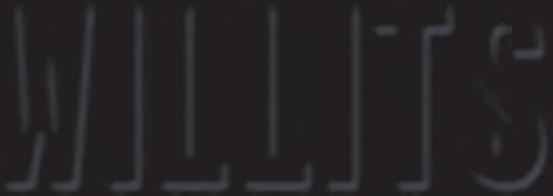







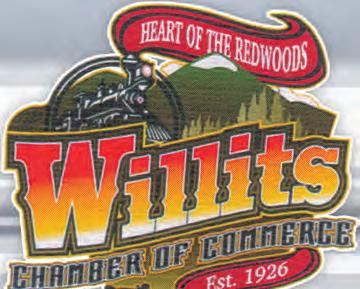







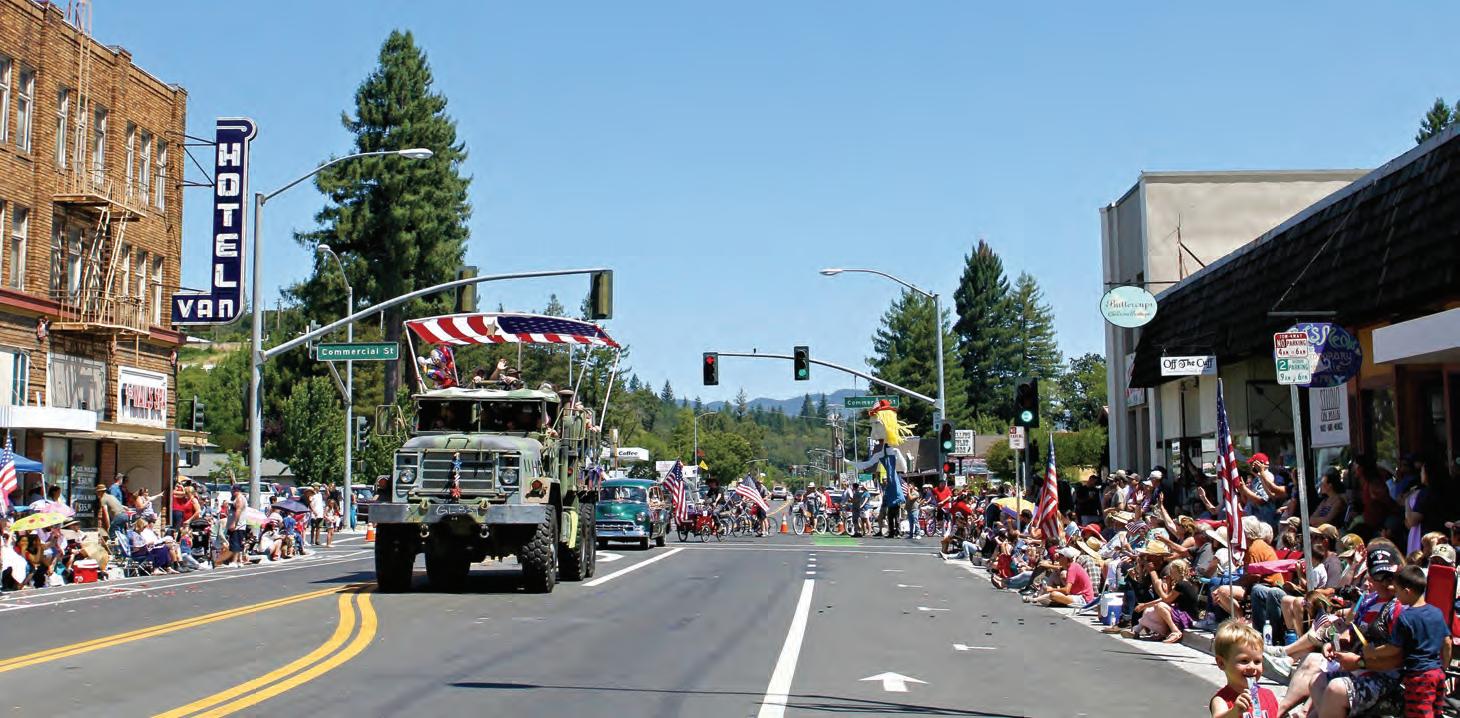

Willits Frontier Days Parade and Rodeo. Photos by Maureen Jennings, Willits Observer
Spend the 4th of July in the Old West at the week-long Fourth of July celebration known as Willits Frontier Days. This event stars California’s oldest continuous rodeo, which has run for over 90 years.
The rodeo and a full week of events draw people from all over California and the world. Willits Frontier Days was started by the American Legion in 1926 with the intention of raising money to build a hospital for the town. In 1932 the reins were handed over to the Willits Volunteer Fire Department, and since 1950 it’s been run by the Willits Frontier Days Association, a nonprofit organization of businessmen and ranchers raising funds for community projects.
The main event is the California Cowboys Professional Rodeo Association (CCPRA) Rodeo. This is rodeo at its finest, featuring some of the finest cowboy talent in California. It’s got the right stuff: bull riding, bulldogging, bronc riding, steer wrestling, barrel racing, team roping and more, plus all the dust, sweat and excitement anyone could want. Live professional rodeo is a spectator sport like no other in America, and in Willits it’s clear the Old West is still alive and kicking. This is the real deal. Centered around this semi-professional, top competition are a traditional rodeo parade, rodeo sweetheart competition, junior rodeo, old-time carnival, classic western dance, cowboy barbecue and breakfast, a truck-pull, and a national anthem singing contest. Get a hat (horses and six-shooters are optional) and come be a cowboy or cowgirl for a week!
MORE INFO: 707-459-6330, WillitsFrontierDays.com

Veteran’s Memorial at Mendocino County Museum. Photos by Steve Eberhard

600 S. Main St. Willits, CA 95490 (707) 472-7412
The Mendocino County Museum opens a window onto the past of the people and places that make up Mendocino County. Fascinating temporary exhibits change regularly; check online or give them a call to find out what’s current. An exhibit of antique toys will end in March of 2019, and two exhibits relating to World War I will open.
Be sure to visit favorite ongoing exhibits as well: an authentic “hippie” van replete with trippy hippie decor from the ’60s, real stagecoaches, a recreated old time creamery, Pomo and other local indigenous people’s basketry, relics from the ill-fated clipper ship Frolic, Seabiscuit’s friends, and a great museum shop featuring locally made gift items. Next door is Roots of Motive Power and its collection of steam-powered trains and machines.
The Mendocino County Museum is open Wednesday through Sunday, 10 am to 4:30 pm . Admission is free on the first Wednesday of each month, and more than reasonable the rest of the time.
WHERE: 400 E. Commercial St., Willits, Recreation Grove Park and the Willits Rodeo Grounds.
MORE INFO: 707-459-2736, MendocinoMuseum.org

The Willits Center for the Arts was created to support and showcase the local art scene in and around Willits, showcasing and supporting local and art-related activities. It holds locally-grown art shows monthly.
Work on renovating the historic 1926 Women’s Improvement Club building that would house the WCA began in 1993, and by 2000 the center was finally opened. Another milestone was reached in 2008 with the opening of the upstairs “Great Room,” which increased available exhibit space and provided a venue for music, physical arts and dance classes and performances, meetings, and celebrations.
The Willits Center for the Arts is open from 11am to 5pm, Friday through Sunday. An updated listing of current shows and events can be found on its website where you can also subscribe to their email newsletter.
WHERE: 71 E. Commercial St., Willits
MORE INFO: 707-459-1726, WillitsCenterForTheArts.org
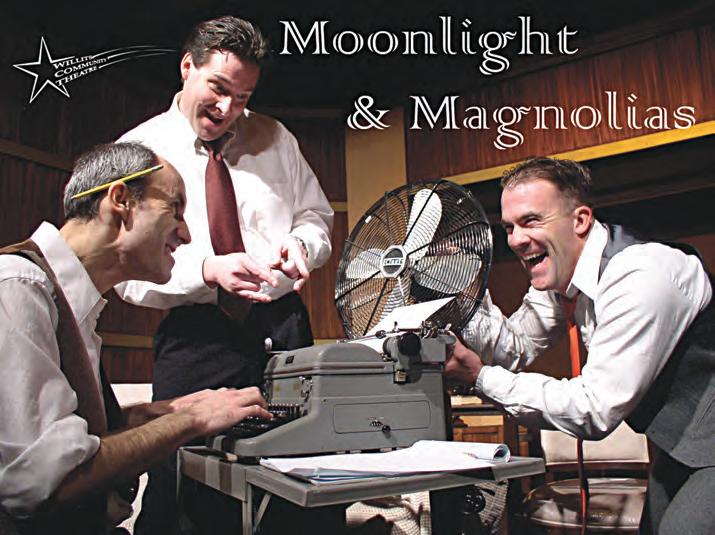
Live theatre is a transformative experience. People who appreciate it flock to the Willits Community Theatre from all over Mendocino County and beyond to see and hear actors live and up close, and immerse themselves in the magic that occurs when performers and an audience intersect.
Established in 1977, the WCT is proud to present an annual season of new and classic plays every year, as well as ongoing concerts, dance performances and community events. It also offers its stage on a rental basis, collaborating with schools and other groups, and providing a venue for artists to audio and video record their shows in front of an artistically sophisticated live local audience.
WHERE: 37 W. Van Ln., Willits
MORE INFO: 707-459-0895, WillitsTheatre.org



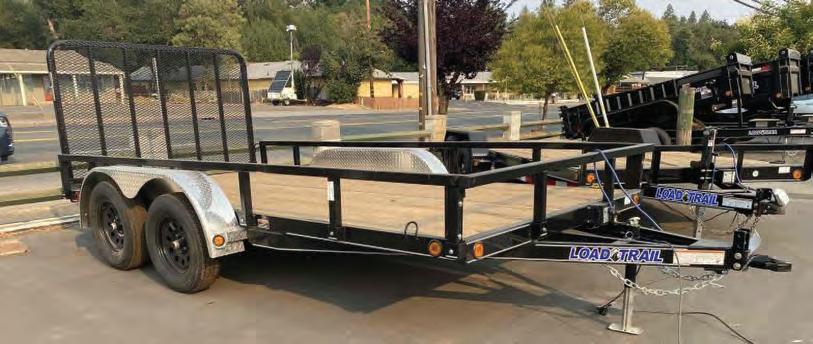
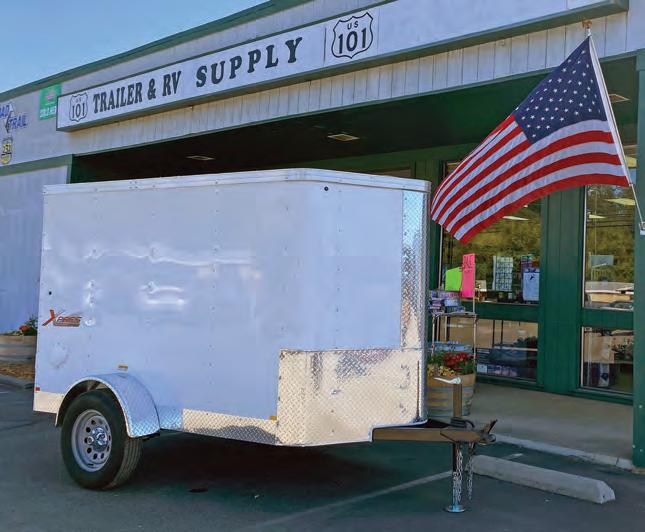


Since 1885 California’s renowned Skunk Train has been transporting passengers along the world-famous Redwood Route. The views on this scenic stretch of track are nearly the same as they would have been more than a century ago — the result of visionary forest stewardship and a dedication to the natural wonder of the redwoods. Some of the trees along the route are more than 1,000 years old, and reach more than 300 feet tall. They have awed passengers both young and old riding on the back of the Skunk for generations, and remain as delightful today as they were for those first riders.
The train offers two points of departure — from the iconic fishing town of Fort Bragg on the stunning Mendocino Coast, and from the inland city of Willits, nestled among the redwoods and sweeping hills of the 101 corridor.
From Willits you’ll travel up to the summit of the line and through a historic tunnel, then down miles of curving track deep into the heart of the Noyo River Canyon. Here
you’ll be surrounded by towering redwoods, and will make a stop at historic Crowley, underneath the shade of the iconic Wolf Tree.
Wherever you choose as your point of departure, you’ll experience the same great connection with a living, breathing piece of history, and discover the majesty of the California redwoods in a way unlike any other. The Skunk Train operates year-round, is child- and dog-friendly, and offers snacks and beverages (alcoholic and non-alcoholic) on board the train. Throughout the year there are seasonal event trains, and for most of December it transforms into the Magical Christmas Train, an experience featuring caroling, hot cocoa, an interactive story, and a visit from Santa Claus.
WHERE: (Depot) 299 E. Commercial St., Willits
MORE INFO: 707-964-6371, SkunkTrain.com


• M ay: FFA Parade on Mother’s Day Weekend
• A ugust: Blackberry Festival
• S eptember: Round Valley Rodeo, Round Valley Indian Tribe’s “Indian Days”
• December: Lioness Club Christmas Bazaar
Ascenic turn off Hwy 101 northeast onto Route 162 will bring you to one of California’s prettiest pockets of nature. The drive takes you along the old Northwestern Pacific Railroad and the ancient waters of the Eel River into a land that Native Americans venerate to this day. Covelo and the Round Valley, with its breathtaking mountains, the majestic Eel River, and groves of conifers and valley oaks, offer a rare glimpse of the wilderness to share and remember. The air is fresh, crisp and clean, and the view is literally panoramic.
The oldest known inhabitants of Round Valley were members of the Native American Yuki tribe, who lived there for thousands of years. Tragically, in the late 1850s they were driven onto a small remnant of their land that had been designated an Indian reservation, and eventually seven other California tribes were forcibly relocated there as well.
Over the past century, the area around the reservation became populated with small settlements. Industry did pass through briefly, but today the natural beauty of the landscape is essentially unscathed, as over time many of the scars slowly healed. Even the old railroad line with its turn-of-the-century designed trestles and tunnels now seems almost a natural work of art. Today the little town of Covelo at the middle of Round Valley is a unique cultural enclave set in the heart of the natural world. Close to half of its population are Native Americans. The town has a vibrant artistic community and a Community Radio Station, KYBU 96.9 FM. With a large number of talented artists who specialize in many different media including ceramics, basket-making, drumming, photography, painting, Japanese textiles, quilting and sculpture, Covelo is one of the most culturally rich and artistically exciting towns in Mendocino County. It is an exceptional place to stop for gallery-browsing and purchasing unique local items.
92
Scenic Drive to Covelo
(see page 76 for more on Mendocino National Forest)
Ten miles north of Willits, State Route 162 runs east from Hwy 101. Known at that point as Covelo Road, it meanders through the Mendocino National Forest all the way to Glenn County and Willows. It is one the most beautiful back roads in California. A 45-minute drive over its first 30 miles will take you from Hwy 101 through Dos Rios and on to Covelo. You will travel back to the past and into the heart of unspoiled nature. Your odyssey will follow the tracks of the historic Northwestern Pacific Railroad with its majestic tunnels, trestles and tracks cutting through the hills and river canyons. Opened in 1914, with its final run in the 1990s, the NWP railroad that once ran the length of the Eel River from Willits to Eureka is itself a man-made wonder. Built by hard-working, mostly immigrant labor at the turn of the century, it is a remarkable sight. The remaining glory of the railroad invokes a sense of history and nostalgia for a time no longer here. Covelo Road will transport you through mixed conifer forests, oak woodlands, grass glades, canyons and wet meadows. In fall and winter, the forests and the majestic Eel River are the stars of the journey. The road follows the course of both the main branch of the Eel and its middle fork for a time. See a wild, natural waterway in motion, waxing and waning through the seasons, perpetually refreshing. In spring and summer, California poppies, penstemon, shooting stars, wild iris, Indian paintbrush, dogwood, wild lilac and several varieties of lupine steal the show with breathtaking explosions of color. Go for it — head for Covelo and an outdoor experience you’ll never forget!

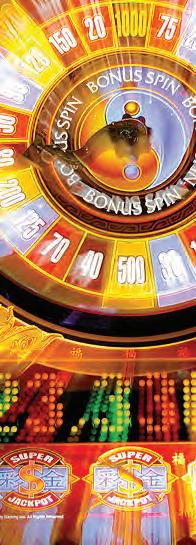






•
•
•
•
•
•
•
•
•

At


Owners:
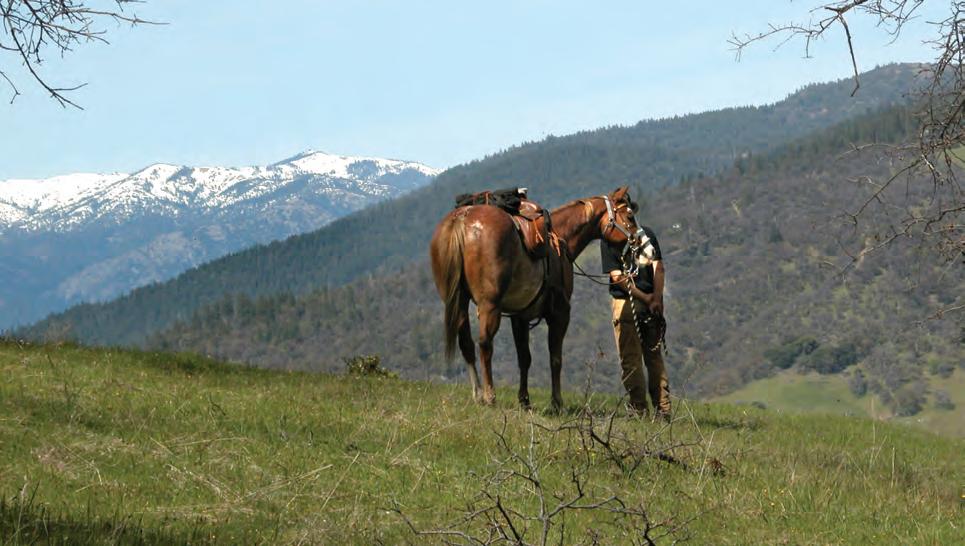
Just 14 miles east of Covelo, “where the pavement ends,” lies the secluded and magnificent Black Butte River Ranch. This 14-acre facility is minutes from great swimming holes on the Eel River and the wilds of the Mendocino National Forest. The ranch offers full hookup RV sites, tent camping and rustic cabins along the Black Butte River. A Country Store, a barbecue featuring local grass fed beef, and showers and a laundromat are all on site. Bring your horse; Black Butte River Ranch provides 9 paddocks and 7 acres of pasture. Recreational opportunities abound, including camping, hiking, backpacking, rafting, kayaking, hunting, fishing, nature study, mushroom hunting, photography and off-highway vehicle travel. Black Butte River Ranch is available for weddings and events.
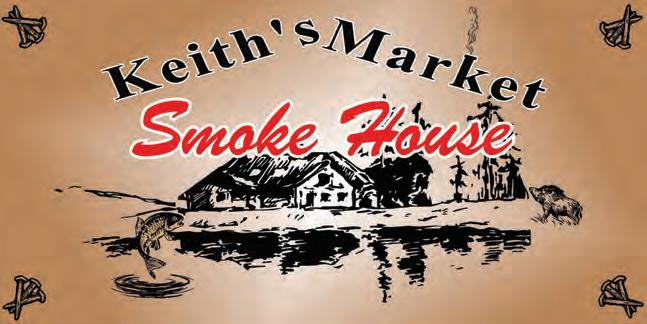
You’ll find mountains of fresh fruit and vegetables, a large selection of organic & natural items, wines, nuts and sweets, a full service deli, the best smoked meats in Mendocino County, and great cheeses, & beer.
The Yolla Bolly-Middle Eel Wilderness to the north provides the experience of deep mountain forests and swift rivers. Mendocino National Forest is located only 6 miles from the Ranch. Rainbow trout, salmon and steelhead can be found there in over 300 miles of streams and 2,000 acres of lakes and ponds. The changing elevations in this wilderness offer a wide variety of outdoor conditions.
WHERE: 34985 Etsel Ridge Rd., Covelo MORE INFO: 707-983-9438, BlackButteRiverRanch.com
The 40th annual Round Valley Blackberry Festival is scheduled for Saturday and Sunday, August 19 and 20, 2023, at the Blackberry Festival grounds in Covelo. Organized by a committee of the Friends of the Round Valley Public Library and sponsored by more than a dozen local businesses and groups of volunteers, the festival features arts and crafts booths, kids’ activities, blackberry delicacies, Mendocino wine tasting, a climbing wall and live music both days. Admission is free.
The grounds include a large wisteria-covered, semi-circular arbor with a bandstand in the middle, both originally built for the first festival in 1983. The wisteria arbor was renewed in 2018 thanks to generous donations of redwood lumber.
Inspired by the delicious blackberries that grow all around Round Valley, the event was begun in order to provide an outlet for local citizens to sell their handiwork, to boost the Round Valley economy by promoting tourism, and to unite the people of Round Valley in a common cause.


WHERE: Festival grounds are located at the corner of Main and Grange Streets, in the park of the historic Round Valley Flour Mill in Covelo.
MORE INFO: RoundValleyBlackberryFestival.com





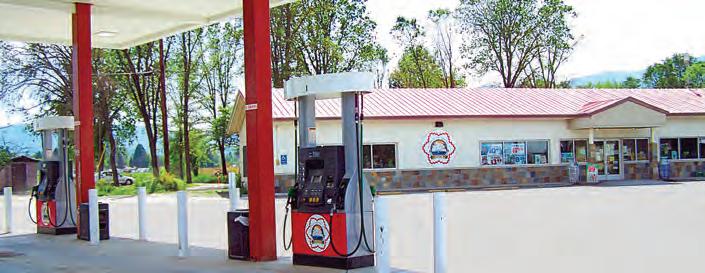

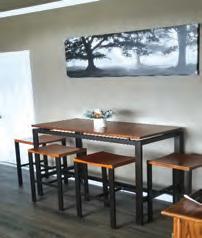
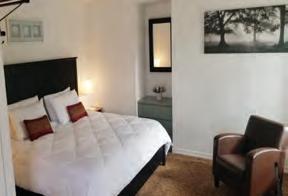

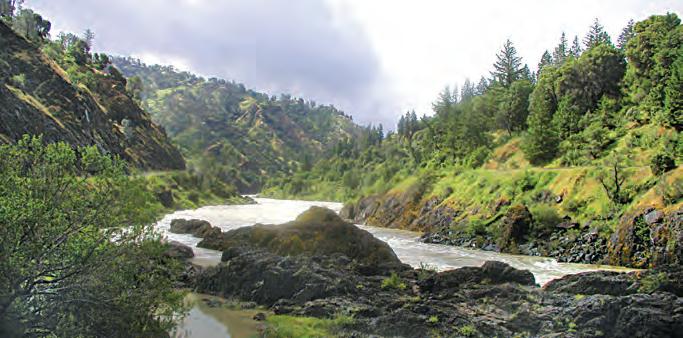
To reach Interstate 5 from Hwy 101, travel east on Hwy 162 north of Willits, past Covelo and through Mendocino National Forest. The journey is approximately 85 miles over both paved and dirt roads, and can take over three hours to drive, but the beautiful scenery and sweeping vistas will turn the chore of reaching the interstate into a delight. The route through Mendocino National Forest is usually closed until mid-May due to snow.
Closures are possible at other times of the year and road conditions may vary; for more information on conditions and closures before departing call the Covelo Ranger District at 707-983-6118 or the Grindstone Ranger District at 530-934-3316
MORE INFO: www.fs.usda.gov/mendocino
The Mendocino National Forest, just to the east of Covelo, covers an enormous area and is perfect for outdoor recreation. Of all of California’s 18 national forests, it is the only one that is not crossed by a paved road or highway. It is especially attractive when seeking tranquility and solitude.
Approximately 65 miles long and 35 miles across, Mendocino National Forest consists of one million acres of mountains and canyons that offer abundant recreational opportunities. Elevations in the forest range from 750 feet in the Grindstone C reek Canyon in the Sacramento Valley foothills on the forest’s eastern edge, to 8,092 feet at South Yolla Bolly Mountain in the northern part of the forest. The average elevation is about 4,000 feet. Four wilderness areas are located in the Mendocino National Forest: Yolla Bolly-Middle Eel, Yuki, Sanhedrin and Snow Mountain, running north to south respectively. The forest is also home to two federally designated Wild and Scenic Rivers: the Eel River received its designation in 1981, and the Black Butte River in 2006.
CAMPING: The camping experience in Mendocino National Forest is outstanding, with developed campgrounds offering facilities from backcountry camping to dispersed campsites (which are not as developed as the regular campgrounds and will usually have one or two primitive vault toilets, one or two picnic tables and fire rings). For up-to-date information contact the Covelo Ranger Station located just north of Covelo on Hwy 162 or phone 707-983-6118.
Getting there is easy. Take Hwy 162 North of Covelo for 1.5 miles; there you will find the ranger station. From the station turn east on Hwy 162 for 11 miles to Eel River Work Center, where Hwy 162 arrives at the Mendocino National Forest. As the roadway enters the national forest it becomes Forest Hwy 7 (FH 7) and changes from a paved road to a dirt road. From there all the campsites are accessible. Some of our favorites are listed below.
Eel River Campground is adjacent to the Eel River Work Station with river access. Hammerhorn Lake Campground is 18 miles north of Eel River Work Center via Road M1 (Indian Dick Rd.), and offers a 5-acre lake for trout fishing in a mixed conifer setting.
Little Doe Campground is 12 miles north of Eel River Work Center via Road M1 (Indian Dick Rd.). No piped water here, but a beautiful mixed conifer setting at 3,600 ft.
Howard Meadows Campground is great for picnicking with fishing and nearby boat launching ramp. At 3,500 feet this campground is within walking distance of Howard Lake.
Howard Lake Basin Recreation Area is a popular primitive experience. The 20-acre lake is accessible; however, it is recommended that vehicles with good clearance be used, such as a 4WD pickup truck, since the access road is not improved.
Several nicely dispersed camp sites include Atchison Camp on Forest Hwy 7, Section 24; Surveyor Camp, off Forest Hwy 7, 7 miles east of Eel River Station; Green Springs Camp and Rock Cabin Camp are trailhead camps and popular jumping off spots to the Yolla Bolly-Middle Eel Wilderness. Georges Valley and Soldier Ridge Camps are located at the northeast terminus of the Indian Dick Road. (M-1); both camps are at trail heads accessing the wilderness.
RECREATION: The diverse geography of this forest offers numerous recreational opportunities, including hiking, backpacking, boating (no motors), fishing, hunting, nature study, photography, and off-highway vehicle travel. The Mendocino National Forest supports an extensive resident trout fishery as well as salmon and warm-water fisheries. Rainbow trout are found in over 300 miles of streams and 2,000 acres of lakes and ponds. The varied terrain of the Mendocino provides endless challenges for mountain bikers. Wilderness areas are one of the few places in the Forest where bicycles are not permitted. Mendocino National Forest offers one of the finest opportunities for OHV recreationists in Northern California, with designated routes and facilities. Free OHV maps are available at the Covelo Ranger station.

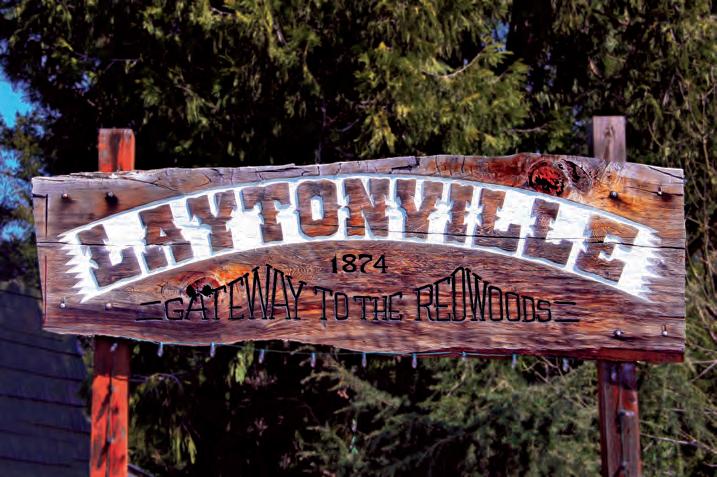
• Year-Round: Laytonville Farmers’ Market
• M ay: Gaia Festival
• A ugust : Laytonville Junior Rodeo
amed after Frank B. Layton, a blacksmith who settled there in 1875, Laytonville sits at 1,670 feet above sea level, giving it the highest elevation of any town along Hwy 101 in Mendocino County. Small yet lively, it is a federally designated Frontier Community and has a warm and friendly “Old West” feel to it. Home to the “Best Lil’ Rodeo Around,” the area also hosts the annual Gaia Festival at a ranch 5 miles north of town. At one time a center of both the logging and ranching industries, today Laytonville’s economy relies primarily on service occupations and educational, community service and arts employment, along with some remaining ranching and agriculture.
Surrounded by beautiful mountains, dramatic redwood forests and rich prairie land graced with beautiful, gnarled valley oaks and canyon live oaks dripping California Spanish moss, this is a sleepy little hideaway where the frantic pace of modern city life gives way to the measured cadences of nature.


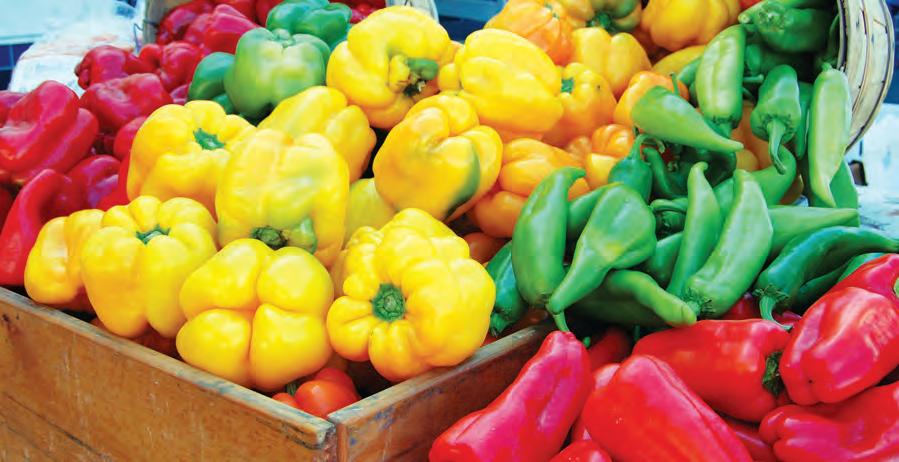

Year-round on Mondays from 2:30 to 5:30 pm , June through October at Alberts on Hwy 101, and 2:30 to 4:30 pm , November through May in the Laytonville Elementary School cafeteria, local farmers set up shop in Laytonville. They bring glorious offerings of the best in local fresh fruits and vegetables, artisan goat cheeses, ranch meats, eggs, garden bouquets, handcrafted clothing and much more. They also come to share their ideas and visions for future projects in their community. This is the Laytonville Certified Farmers’ Market (LCFM), in the heart of Mendocino County. The Laytonville Certified Farmers’ Market provides opportunities for people in rural Mendocino County to develop new businesses, and gives everyone a chance to visit with friends, enjoy local musicians, and purchase delicious, healthy food while supporting local farms.
MORE INFO: MCFarm.org and see Farmers’ Markets listings on page 8.

Cowboy up! For 24 years now, Laytonville has been holding the rootin’ tootin’est junior rodeo around. At press time, no information is available about the 2023 Rodeo, which normally occurs in the last week of August.
You’ll get to see kids competing in categories from “Pee Wee” (5 and under) all the way up through “Jr/Sr” (ages 14-18). The littlest ones compete at lead line barrels and goat ribbon untying, while events for older participants include barrel racing, pole bending, goat tying, breakaway roping, calf, sheep and steer riding and more.
One of the Jr/Sr categories is chute dogging “Chute dogging is getting into a bucking chute, like bull riders come out of, with a 300-500 pound steer. You hold on to his horns, they open the gate, you get 10 feet away and then you have to wrestle him until he falls over.”
— Laytonville chute-dogger Henry Shere.
Spectator admission is remarkably affordable, and kids 5 and under get in for free. So come on down, and cheer on the kids!
WHERE: Hwy 101 to Laytonville, follow the signs to the Laytonville Rodeo Grounds at Harwood Park, 44400 Willis Ave.
MORE INFO: Call Regina at 707-354-1630, laytonvillerodeo.org


ConfusionHill.com

OneLogHouse.com
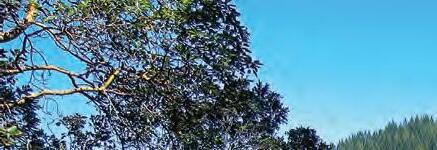
Approximately 25 miles north of Laytonville is the town of Leggett, located at the junction of Hwy 101 and Hwy 1. The former logging town attracts campers and travelers during the summer months, and hordes of fishermen when the salmon swim upstream to spawn in the late fall. The population of Leggett fluctuates between 350 and 500 depending on the season. Summer temperatures can hover in the 90s, but the Eel River is always nearby for cooling off. Piercy, about 9 miles northwest of Leggett and located on the South Fork of the Eel River, is an unincorporated area immediately below the Mendocino-Humboldt County line.
Here at the “gateway to the tall trees country,” weary travelers can refresh themselves with a dip in the South Fork of the Eel River, a quiet picnic, or a stroll through the beautiful redwoods. One of the last remaining stands of virgin, old-growth redwood in the area can be found on the Grove Trail.
There is great fishing here, too. Standish-Hickey also offers three campgrounds, with over 150 campsites available on a first-come, first-served basis.
Standish-Hickey State Recreation Area began as a Save the Redwoods League campground in 1922, and, in the 1950s, 500 additional acres were donated by descendants of Miles Standish, one of the original pilgrims. The 1,200-year-old Captain Miles Standish Tree named after him is one of the park’s premier attractions. Additional acreage was acquired over the years, and now the park is over 1,000 acres. The second part of the park’s name was chosen in memory of Edward Ritter Hickey, the son of a local lumberman, who died of the Spanish influenza in 1918 while caring for victims of the pandemic. His family also donated some of the land.
WHERE: 1.5 miles north of Leggett on Hwy 101.
MORE INFO: 707-925-6482, www.parks.ca.gov/?page_id=423
Just north of Leggett, you’ll find Campbell Bros. World Famous Confusion Hill, the most exciting roadside attraction in northern Mendocino County. Listed as a California Point of Historical Interest, and featured on Ripley’s Believe It or Not, this is definitely a one-of-a-kind attraction. It has been the home of mystery and fun since 1949. When you step into the Gravity House, your body will seem to defy the laws of nature. You will experience contradictory optical and physical sensations that will make you ask yourself, IS SEEING BELIEVING? There are no right or wrong answers at Confusion Hill.
Be sure to check out the Redwood Shoe House. There is also the unique, miniature Mountain Train Ride that will take you on a 30-minute ride up the hill and back down. Along the way you will learn about the Redwood Forest and see historical logging equipment on the side of the track. Confusion Hill is also the home of the World’s Tallest Free Standing Redwood Chainsaw Carving, and has been listed in Ripley’s Believe It or Not. While at Confusion Hill, take a few minutes to pay your respects at the Twin Towers Memorial Trees. There is also a gift shop, snack bar and playground for the kids. Please note that the Train Ride and Snack Bar are seasonal and are open Memorial Day to Labor Day only.
WHERE: Along Hwy 101, 15 miles south of Garberville (exit left) and 7 miles north of Leggett (exit right).
MORE INFO: 707-925-6456, ConfusionHill.com
The One Log House is the heartwood of a 2,100+ year-old redwood, hollowed out by hand, and fashioned into a tiny home; complete with all the amenities. Although the timeline for this tree starts before the birth of Christ, its modern timeline starts with its cutting in 1946. The log for the One Log House was cut down by Art Schmock and his son. At that time, the tree was on property owned by Georgia Pacific Co. of Eureka. This particular log was cut, rolled onto a trailer, and metal straps were welded around it for support. It was then transported to Eureka where it was hollowed out by hand, using tools such as drills, chisels, wedges and foot adzes. The log itself is 32 feet long, 10-11 feet in diameter and has an interior height slightly over 6 feet. The living area is divided into kitchen, bathroom, living and bedroom areas. In the 8-month process of hollowing the log, enough wood chips were produced to build a traditional 5-bedroom home.
The One-Log House has traveled to and stayed at various places in Humboldt and Mendocino Counties since 1946. Open since 1999, One Log House Cafe & Giftshop sits near Richardson Grove State Park on Hwy 101, serving fresh sandwiches, ice cream sundaes and organic, locally roasted coffee and snacks. Visitors can tour inside the One Log House itself, enjoy the gift shop and cafe, and even grab some legendary Humboldt cannabis at the 21+ dispensary.
Outdoor picnicking areas, air-conditioned tables, and dog runs are on site. Antique logging photos and local art are on display. Souvenir penny smashing machine, local crafts and wild-foraged items, Bigfoot, and Cannabis Americana make this a stop that has something for everyone.
EV chargers coming in 2020. Handicap accessible. Open daily, year-round. WHERE: On Hwy 101, 9 miles south of Garberville next to Richardson Grove.
MORE INFO: 707-247-2717, OneLogHouse.com
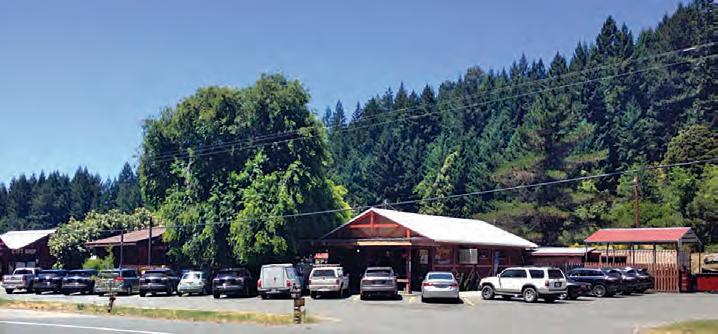
On Hwy 101 north of Leggett is one of the most beloved roadside stops along the Redwood Highway. The Peg House is featured in Sunset magazine’s Top Road Food Spots in the West: “One of the 25 Absolutely Best Places to Eat Along Western Highways.” Across from Standish-Hickey State Recreation Area, the ‘Peg House’ features a gourmet deli, espresso bar, gift shop, general store complete with picnic and camping supplies and an outdoor organic grill. Owners Diana and Gary Ballard-Doll have it all — right in the middle of nowhere and on the way to everywhere. Their espresso bar features some of the best mud north of San Francisco. Signature Coffee, roasted in Redway and freshly ground on site, goes into an old Rancilio espresso machine that has been building up steam for decades. The espresso that comes out has an aroma and crema thick enough to make a city barista cry.
The delicatessen features fantastic sandwiches (turkey roasted there) and other delights. The Grill is outside, in back, where you can sit in a garden. The grill features Tri-Tip sandwiches, Humboldt Grass-Fed Beef burgers and fresh, sweet Arcata Bay oysters. A beautiful redwood stage creates a venue for summer music, movies, and other events. Diana’s award-winning jams, jellies, salad dressings, candies, brownies and cookies make a simple coffee break an event. Try the “Mendo Mookie” — a cross between an oatmeal muffin and a cookie. The Peg House has some of the coolest gifts on the road. More collector items than tourist fodder, it features unique postcards, books, signs, locally-made designer jewelry and other classy gifts and gear. Open from 7am ’til sunset, hours varying with the seasons. Remember, “Never Don’t Stop” at The Peg House.
WHERE: 2 miles north of Leggett on Hwy 101.
MORE INFO: 707-925-6444, ThePegHouse.com
Traveling north from San Francisco along the Redwood Highway (U.S. 101), the first old-growth redwoods you’ll encounter are in Smithe Redwoods State Natural Reserve. Here you’ll find the beautiful Frank and Bess Smithe Grove of redwoods, as well as Dora Creek Falls, a lovely 60-foot waterfall. Because Smithe Redwoods is a natural reserve, the park is managed to minimize human impact, so there are no developed campgrounds or trails, or even a parking lot. There is, however, a paved pullout near it on Hwy 101 where you can pull over and park, and within the reserve you’ll find a picnic area and easy access to the South Fork of the Eel River for fishing and swimming. From about 1920 until the early 1960s it was a popular tourist resort called Lane’s Redwood Flat, owned by George W. Lane, one of the builders of the Redwood Highway. It was then purchased by the Save the Redwoods League, which deeded it to the State of California.
WHERE: 4 miles north of Leggett on Hwy 101.
MORE INFO: 707-247-3318, www.parks.ca.gov/?page_id=427










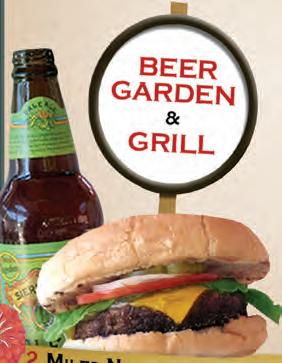




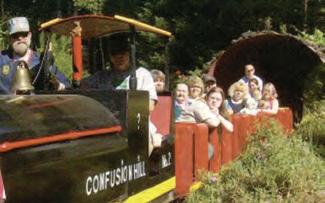













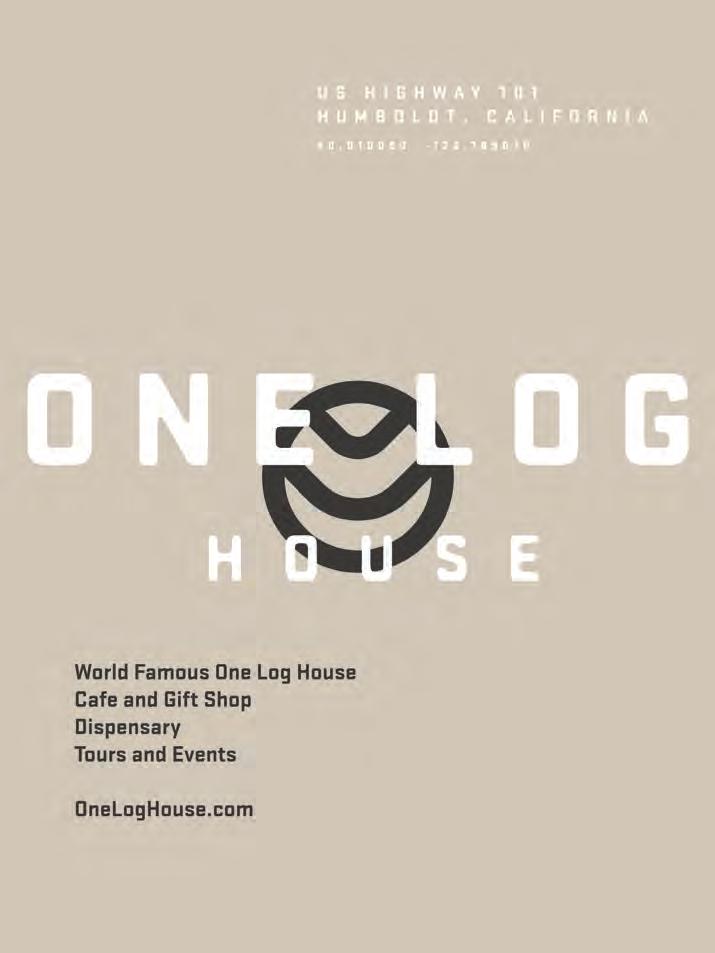
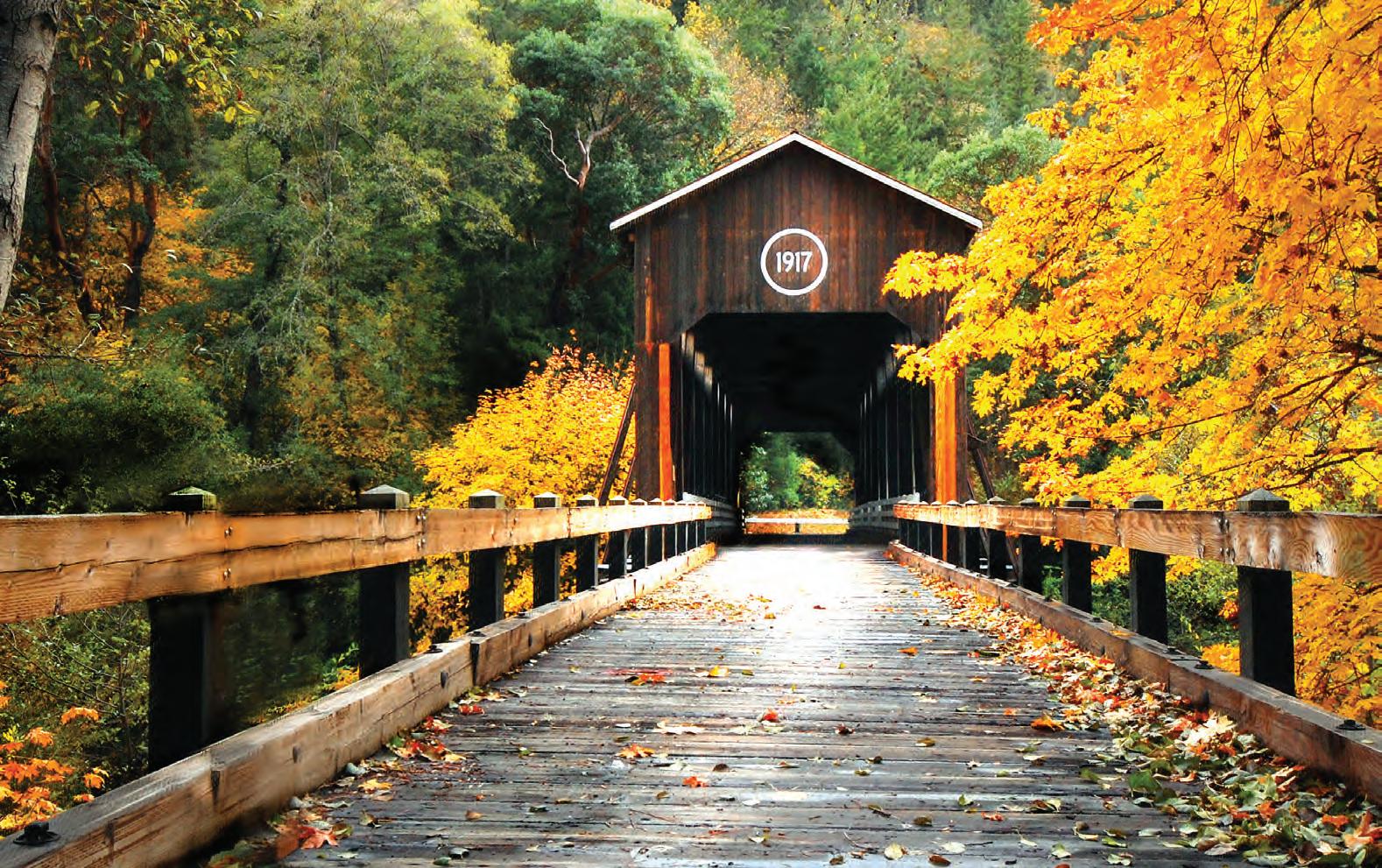
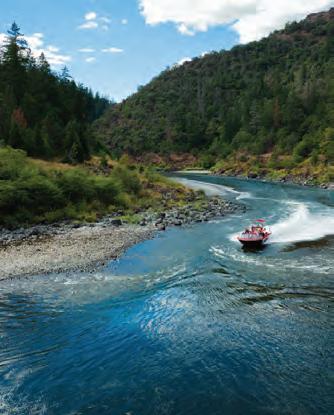



California’s northernmost coastal county, Del Norte, contains miles of unspoiled beaches and rivers famous for salmon and steelhead. Most of the communities in the county are situated along coastal Hwy 101.
Del Norte County is located roughly halfway between San Francisco and Portland via Hwy 101, Hwy 199 and I-5. Towering redwood forests can be seen there in Redwood National Park, Jedediah Smith State Park and Del Norte Coast Redwoods State Park.
The town of Klamath is the southern-most in Del Norte County. It is a favorite getaway for campers, hikers, boaters and fishermen.
Klamath River Jet Boat Tours, one of the area’s most popular attractions, takes people on exciting, scenic trips down the Klamath River aboard their jet propelled boats.
Another popular attraction, Trees of Mystery, offers tours through a pristine redwood forest. Its Skytram takes visitors on an aerial tour through the lofty canopy of an ancient redwood grove. Klamath’s newest attraction is the beautiful Redwood Hotel Casino. 101Things.com

Crescent City is the county seat and Del Norte’s largest city. The Redwood National and State Parks Visitor Center is located at 1111 2nd St. Attractions include Battery Point Lighthouse, Crescent City Harbor, scenic drives, public fishing piers, a museum and the Elk Valley Casino. The city also has a wide variety of stores, restaurants, RV parks and lodging facilities. Nearby the majestic Smith River flows to the ocean and offers a host of recreational activities, including rafting, inner tubing, kayaking, fishing and more.
When in the Crescent City area, tour Ocean World for an exciting family adventure. This is one of the best privately-owned small aquariums in the United States. It has an abundance of marine life including sharks, seals, sea lions, rays and wolf eels, and features shark petting, an interactive tide pool and high-flying sea lion performances.
The Northcoast Marine Mammal Center is located in Crescent City’s Beachfront Park. The center is dedicated to the rescue and rehabilitation of stranded, sick or injured seals, sea lions, dolphins, porpoises and whales along the northernmost coast of California.
Traveling north from Crescent City you‘ll come to the tiny agricultural community of Smith River, where the river of that name enters the Pacific. Continue further north, and you will find yourself in Oregon.
The Southern Oregon coast offers visitors dazzling ocean vistas and lush green forests, sand dunes and sea lions, water sports and sailing adventures. Inland Southern Oregon offers warmer summertime temperatures, wintertime skiing, whitewater excitement, wineries and Shakespeare performances. From beautiful coastal communities like Gold Beach, Brookings Harbor and


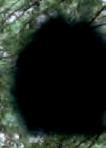
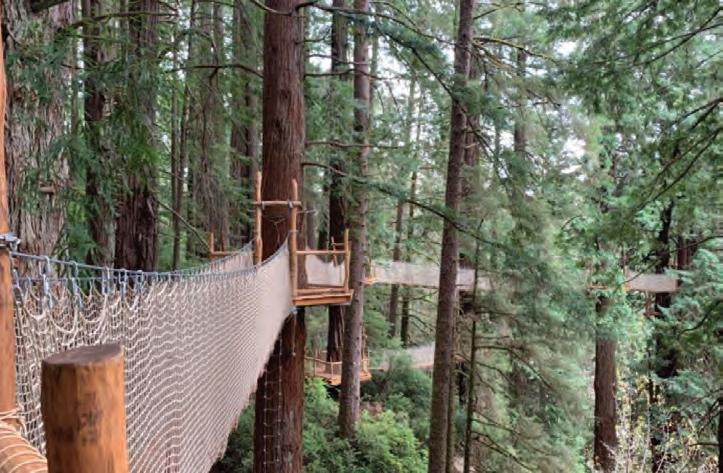







Humboldt County is a haven for travelers and residents alike. It boasts half of all remaining old growth redwoods, including the world’s tallest trees, 160 miles of unspoiled beaches, many of them along the fabled Lost Coast, and bustling seaports, quaint farming communities and historic fishing villages. Everywhere in the county, travelers will find exceptional accommodations, fine restaurants, a multitude of shopping opportunities and numerous campgrounds.
The county is situated on the Northern California coast and begins about 50 miles south of the Oregon border. The largest towns are adjacent to Hwy 101. The southern end of the county lies about 200 miles north of San Francisco.
Humboldt County has a variety of climates and terrain. Coastal Humboldt is wild, mostly rocky, and cool in the summer. Inland, Humboldt has small communities that get quite warm in the summer. Many sit next to scenic rivers such as the Eel, Trinity and Klamath.
In northern Humboldt, Orick is the gateway to Redwood National Park, home of many of the world’s tallest trees. Many notable redwoods grow along the Newton B. Drury Parkway, a short stretch of old Hwy 101. Twenty miles south of the park is the fishing village of









town, with many businesses clustered around its historic central plaza.
East of Arcata along Hwy 299 is the charming, sunny town of Blue Lake, home of the Blue Lake Rancheria Indian tribe. Curiously enough, there is no lake in Blue Lake. Further east is Willow Creek, known for outdoor recreation along the Trinity River, including whitewater rafting, and the site of many purported Bigfoot sightings.
Eight miles south of Arcata is the Victorian seaport of Eureka. It’s situated on Humboldt Bay, which offers kayaking, fishing and wildlife-watching. There are harbor tours aboard the M.V. Madaket, and the Woodley Island Marina is a great spot to enjoy a panoramic view of the waterfront.
Eureka is the county seat and contains many fine examples of Victorian architecture, particularly along the waterfront in Old Town. Most noteworthy of these is the ornate Carson Mansion, perhaps the most photographed Victorian in the United States. Eureka’s population of nearly 28,000 makes it the largest coastal city between San Francisco and the Oregon border.













next page

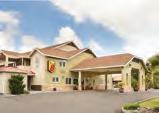















Eureka has many excellent restaurants, cafes, specialty shops and lodging facilities. The city is also known for its large and active arts community. In fact, Humboldt County has the distinction of having more artists per capita than any other of the state’s 58 counties.
Further south and 5 miles west of Hwy 101 is the Victorian village of Ferndale. The entire downtown has been named a State Historical Landmark (No. 883) because of its outstanding preservation of its buildings.
Eight miles east of Ferndale is the sunny inland town of Fortuna, known as the Friendly City. Right along Hwy 101, it has many newer hotels and an attractive community lodge overlooking the Eel River. East of Fortuna along State Hwy 36 is Grizzly Creek State Park, a favorite for hiking, camping and summer sun.
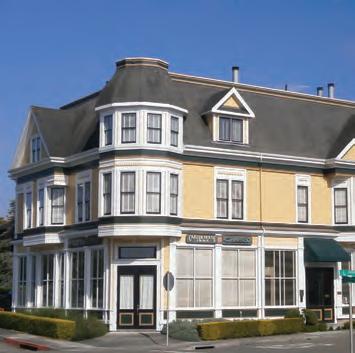
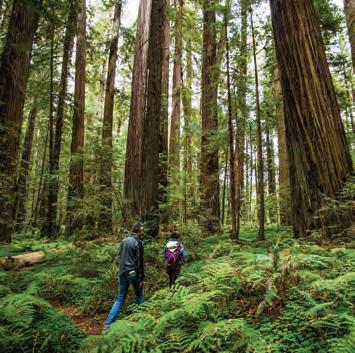
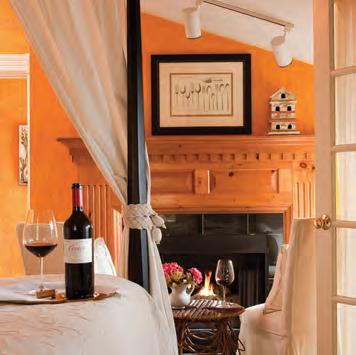

South of Fortuna on Hwy 101 is Scotia, a historic lumber mill town just recently transitioned from “company town” to independent community.
In southern Humboldt, Hwy 101 and nearby roads pass near some of the finest specimens of old-growth redwoods in the world. From Redcrest south to Phillipsville, motorists can detour along the renowned Avenue of the Giants, a 31-mile stretch of two-lane road that parallels Hwy 101 and winds through stands of huge redwoods along the Eel River.
Humboldt Redwoods State Park, located along the Avenue of the Giants, covers more than 51,000 acres. The park includes the Rockefeller Forest, the largest single stand of virgin redwoods. After leaving the avenue, the traveler will once again be on Hwy 101.
A jaunt west on side roads that exit Hwy 101 will lead travelers to the King Range National Conservation Area and the legendary Lost Coast. This adventure leads to several colorful hamlets and ultimately the picturesque resort town of Shelter Cove.
Near the southern county line, 9 miles south of Garberville, Richardson Grove State Park is a magnificent 2,000 acres of redwoods. The state acquired the area in the early 1920s, making it one of the oldest state parks in California.
MORE INFO: Humboldt County Convention & Visitors Bureau, 1034 2nd St., Eureka, 707443-5097, Redwoods.info; VisitRedwoods.com
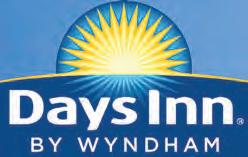


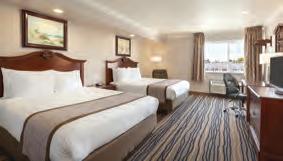










Whether it’s communion with nature, creative expression, or physical and spiritual rejuvenation, people who come to Ukiah are seeking an escape from the usual. Two hours north of the San Francisco Bay Area, Ukiah charms you with its rich character, vineyards and natural surroundings. Named California’s best small town and the sixth best in the entire country, Ukiah beckons you to explore all that the valley has to offer amidst their 300 days of annual sunshine.
Ukiah is the heart of the greenest wine region in America and is home to industry pioneers like the nation’s first organic winery, the first carbon-neutral winery and renowned innovators in the microbrew industry.
Plan your visit around one of the many year-round events and farm-to-table dinners that celebrate the local bounties of organic food and wine, artisan olive oils and more. For rest and relaxation, there are hot springs and statuesque redwood groves, an international Buddhist monastery with its jeweled hall of 10,000 Buddhas, and highly acclaimed fine dining.
Experience nature you can touch, wines that will amaze, food that you’ll remember. The hospitality is genuine, the pace unhurried. Ukiah is the place you didn’t know you needed to visit, but will be glad you did.


For more information and a full calendar of events, see VisitUkiah.com or call the Ukiah Visitor Center at (707) 467-5766.
